INTRODUCTION
by
David Hey
Terry Sykes's 'In and Out of Trains' is an appropriate heading for his page and I wish I had thought of it myself. Each and every one of us will have at one time or another experienced the ebb and flow in our passion for trains and railways, whether it be an allegiance to steam or a penchant for more modern diesel and electric traction…in essence, the appeal of trains frequently comes and goes, but it never leaves us entirely.
Terry's fascination with trains began in the West Riding of Yorkshire during the 1950s when the majority of 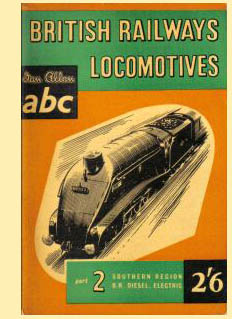 small boys shared a passion for train spotting. It started off as a relatively simple hobby at first, little morethan jotting down a few engine numbers at his local station at Saltaire near Shipley until it dawned on him that spotting the same old engines time and time again was a fruitless exercise and a wider search began in earnest. His parents were badgered for permission to travel further afield, but wisely no mention was made of the hairy escapades his trips involved, often pedalling mile upon mile on push bikes to faraway places and climbing over perimeter walls to gain access to engine sheds.
small boys shared a passion for train spotting. It started off as a relatively simple hobby at first, little morethan jotting down a few engine numbers at his local station at Saltaire near Shipley until it dawned on him that spotting the same old engines time and time again was a fruitless exercise and a wider search began in earnest. His parents were badgered for permission to travel further afield, but wisely no mention was made of the hairy escapades his trips involved, often pedalling mile upon mile on push bikes to faraway places and climbing over perimeter walls to gain access to engine sheds.
Of course, trespassing on railway property was downright dangerous and I am not making light of it here, however certain allowances must be made for young boys, who, by their very nature have yearned for adventure since time immemorial; the prospect of exploring new places has always been in a boy's genetic makeup, and this included a generation of post-war 'baby boomers', whose memories of chasing trains in the 1950s are remembered as a life-changing experience and we wouldn't have missed it for the world.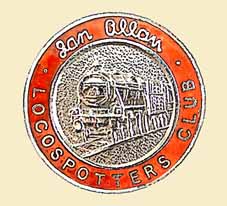 Alas, by the mid-1960s our search for engine numbers took an ominous downturn and our spotting trips were returning fewer rewards than previous times, not least because collecting engine numbers was a speculative pursuit where success was measured by the sum total of 'cops' collected. Now you don't have to be a mathematician to calculate the odds of adding more numbers to your collection when the rank and file of BR steam was being culled at an alarming rate.
Alas, by the mid-1960s our search for engine numbers took an ominous downturn and our spotting trips were returning fewer rewards than previous times, not least because collecting engine numbers was a speculative pursuit where success was measured by the sum total of 'cops' collected. Now you don't have to be a mathematician to calculate the odds of adding more numbers to your collection when the rank and file of BR steam was being culled at an alarming rate.
This is where things began to get serious, for having exhausted the 'cop' rate in our local area, the only way of filling the gaps in our Ian Allan ABCs was by travelling further afield, and so marathon trips were planned to distant BR Regions to track down those stubborn 'bs' of engines we needed before they too ended up on the scrap heap.
In short, the hobby became a miniaturised encyclopaedia with established traditions, conventions and boundaries, and yet in spite of all the disorder around us - the modernisation programme, the madness of the Beeching cuts - the one thing we learned most about life's ups and downs is that nothing lasts forever; indeed I have only the greatest respect for BR's beleaguered 'railway family' of workers who bore the brunt of change the most; all were the most genial and hospitable people I ever had the pleasure to meet…
(Below) Getting into its stride, 'Jubilee' class No 45629 Straits Settlements leaves Saltaire station in its wake with a northbound perishables goods train on a sunny summer morning in 1963.
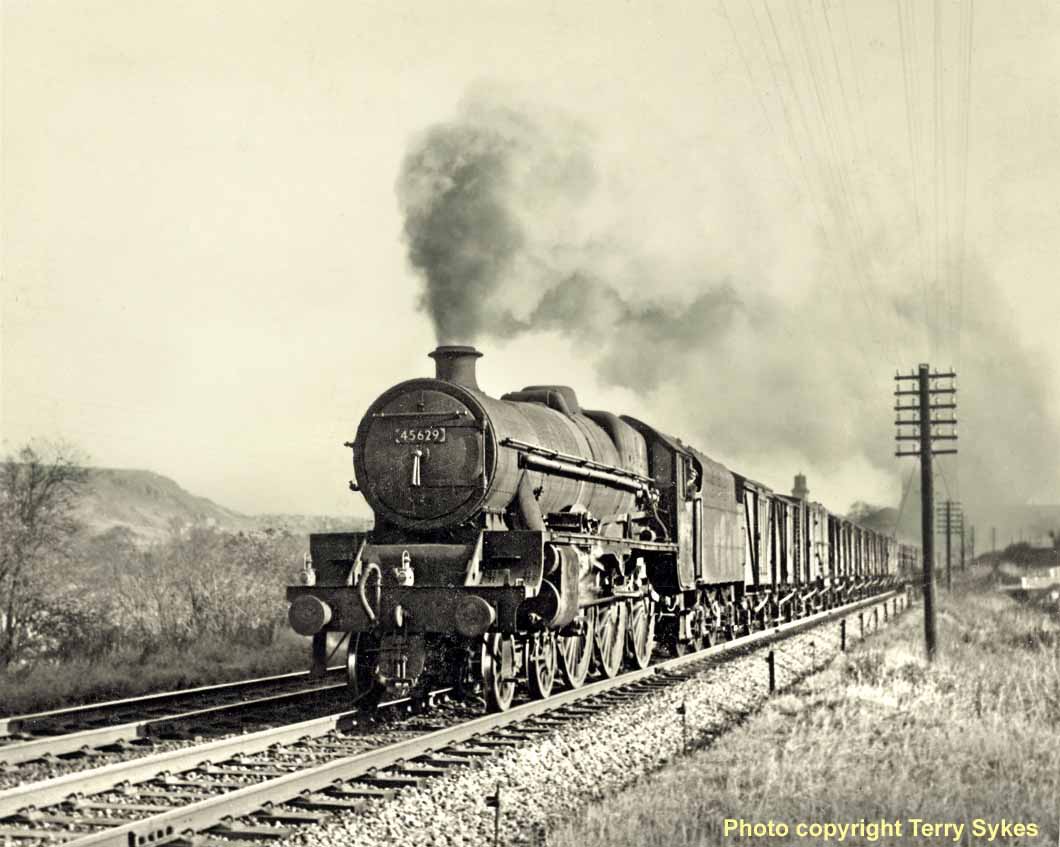
PREFACE
by
Terry Sykes
There's a very true saying - 'You can't put an old head on young shoulders' - and normally this is absolutely bang on! However, in the world of railway photography the complete opposite often turns out to be the case. Looking at old photographs of BR steam days posted on the Internet, you have to keep reminding yourself that many were taken by thirteen and fourteen year-old schoolboys with little or no knowledge of railways or the locos they were photographing.
And it's fortunate also, that the old cameras did not discriminate between the age or life experience of the person whose finger pressed the button. Thankfully the young learn very quickly. Once a picture had been taken of a loco with a lamp post growing out of its chimney, it was a mistake seldom repeated.
Now fast-forward fifty years, and hundreds of hours are spent surfing the web looking at some excellent photographs of steam days, however what is most extraordinary is that many were taken by small boys still in short trousers, all of whom are now old gentlemen well past their prime. In fact you can almost say - 'The old heads have finally caught up with young shoulders!' 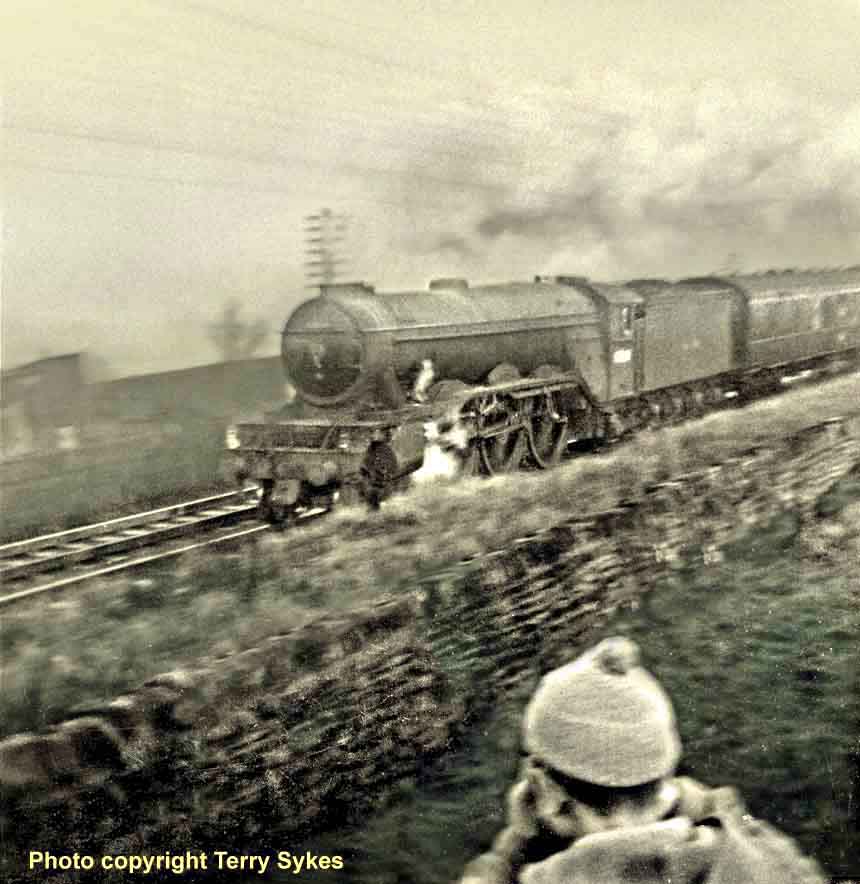
(Inset) I spent many hours playing football with my mates on the local 'rec' just a few hundred yards north of Saltaire station; it was situated right alongside the railway line which meant we could indulge our passion for football and observing trains at the same time.
Sadly, as a cash-strapped 12 year-old back in the Fifties, cameras were something that other people owned, and so all the hours spent watching 'Scots', 'Patriots' and 'Britannias' passing by on express trains, were by consequence recorded in pencil only. The only two pictures I have of this period are of Class A3 Pacifics taken with a Coronet 44, but neither are very good.
However a bit of tweaking in Adobe Photoshop has produced a passable image of Class A3 Pacific 60088 Book Law accelerating the 2 o'clock (local time) northbound 'Waverly' through the drizzle. The locomotive is about to pass beneath Hirst Lane road bridge which leads down to the locks and swing bridge on the Leeds-Liverpool Canal.
IN AND OUT OF TRAINS
by
Terry Sykes
It all began for me during the 1950s when I was just 12 years-old. I was then a pupil at Bingley Secondary Modern School where most adolescent boys were passionate about collecting everything from cigarette cards and marbles to birds' eggs, even love bites!
Above all else, collecting engine numbers figured high on our list of priorities, for it was hard to ignore the fact that a railway line was conveniently raised on a sizable embankment less than a couple of hundred yards from the classroom window and every day all manner of trains and locomotives were rattling past during lessons. How the teachers must have hated the intrusion when all heads turned sideways to enjoy the spectacle of passing trains…all teachers that is, for except the redoubtable Robert Bailey Parr.
'Puffer Parr', as he was affectionately known, was a staunch enthusiast who knew the railway timetable off by heart. At regular intervals during lessons he could be seen glancing at his watch before moving nonchalantly to the window, then after the train had gone he would slip back behind his desk and make notes out of sight of curious gazes before carrying on with his lesson!
He also ran the school's Railway Club, and since train spotting was then the national hobby for boys it seemed the most natural thing in the world to become a member along with your mates. Weekly club meetings were attended where Puffer Parr taught us all things 'Railway'. Strategies were formed and visits to engine sheds were organised…the world had suddenly become a much bigger place - and from that point on, the lives of many Bingley schoolboys would never be the same again!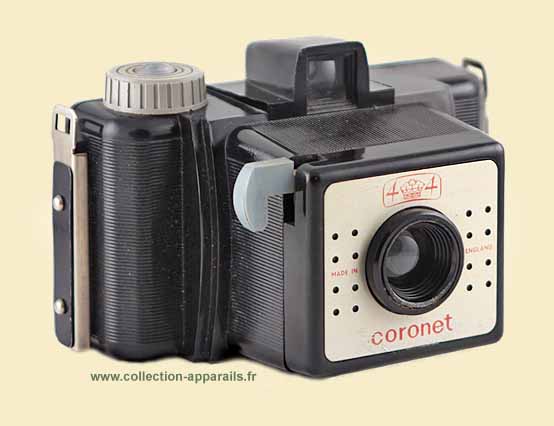 On joining the Bingley Secondary Modern School's Railway Club, the first memorable activity I recall was a trip to London. No half measures here from Mr Parr. Six sheds in one day! What would we give today to be transported back in time with a decent camera to that day in 1959?
On joining the Bingley Secondary Modern School's Railway Club, the first memorable activity I recall was a trip to London. No half measures here from Mr Parr. Six sheds in one day! What would we give today to be transported back in time with a decent camera to that day in 1959?
I have no idea where my 'Coronet 44' camera came from…the poor man's Brownie 127! And I have no idea why I took so few images during the entire day; perhaps mum let me borrow the family camera to finish off a film? I remember we had very little money and film was expensive, but I have no recollection whatsoever of the journey by train to London and back. I do recall walking down the platform at Kings Cross and seeing the prototype 'Deltic' snuggled up to the buffer stop. The English Electric diesel prototype was a regular performer on the ECML between Doncaster and Kings Cross; we may well have travelled down to London behind it? Also did we really arrive in London early enough to see Class A4 No 60014 Silver Link being prepared on shed before its scheduled 10 o'clock departure with down the 'Flying Scotsman'?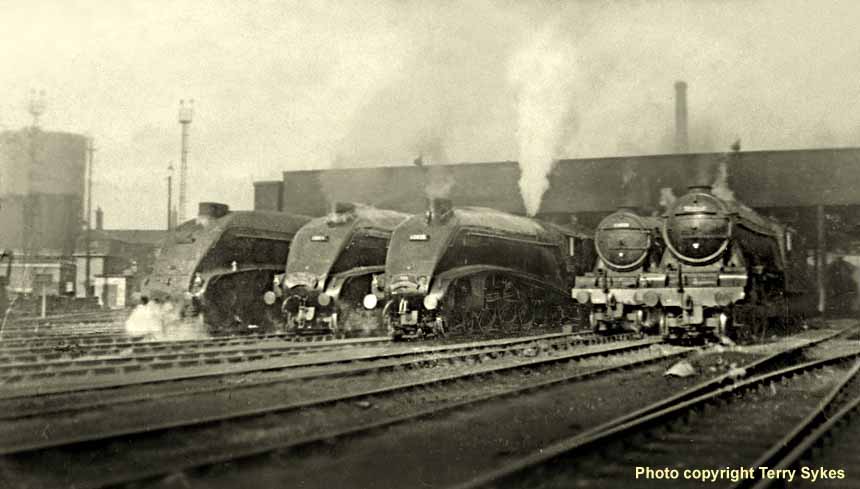
(Above-Below) Just look at this early morning line up of locomotives in the yard at Kings Cross MPD! From left to right we have three A4 Pacifics. The designer Sir Nigel Gresley was a serious bird enthusiast, and this was reflected in his choice of locomotive names. First we have 60018 Sparrowhawk, then the doyen of the class 60014 Silver link sporting the 'Flying Scotsman' headboard, and finally 60025 Falcon with the 'Elizabethan'. To the right we have A3s 60060 The Tetrarch, and finally 60062 Minoru. This was quite possibly the first photograph I ever took, what a subject! (Below) After our visit to 34A, the next shed on the agenda was Willesden (1A) where I distinctly remember seeing an immaculate 'Duchess' Pacific No 46256 Sir William A Stanier standing alone in the shed yard. So why didn't I take a shot of it? This was followed by a visit to Old Oak Common (81A) where I'm sure we had something to eat in the canteen before moving on to visit the three Southern Region sheds at Stewarts Lane (73A), Bricklayers Arms (73B) and Nine Elms (70A). Standing alone at the end of the yard at 70A was King Arthur class 4-6-0 locomotive No 30777 Sir Lamiel. Who would have thought that 57 years later this locomotive would still be running as part of the NRM collection! Robert Parr took this impressive photograph and every one of the group was given a print at the next railway club meeting. What a day! 

(Above) This group photo was taken of the Bingley Secondary School Railway Club trip to York in 1960. A line up of eager youngsters with notebooks pose for RB Parr's camera; some donning overcoats, others woolly-pullies or smart school blazers with badges on lapels; note the knee-length short trousers, half-mast socks, a solitary duffel bag and, of course, the trusty Kodak Brownie 127 cameras. There are 26 faces in this picture but I can only remember some of their names below…it WAS 56 years ago!
1 - Robert Milles; 4 - Michael Heaton; 8 - Keith Sykes; 10 - Keith Frear; 11 - Terry Sykes; 13 - Graham Pennie; 16 - Donald Muff; 18 - Rex Holt; 19 - Barry Todd; 21 - Ken Shackleton; 22 - Ian Buchanon; 23 - Roy Carney; 24 - Brian Wilthew; 26 - David Shaw.
If you can identify anybody else in the picture I will gladly add their names here.
The driver runs on wings of steel, the fireman wings of flame.
The poor old guard has no wings at all, but he gets there just the same!  (Inset) Being the youngest of three brothers meant my first pairs of long trousers were always going to be hand-me-downs! On the left is my 14 year-old brother Keith, just one year older than me, and I'm on the right wearing….well, no prizes for guessing whose trousers these belonged to! If you put your thumb over my lower half I look quite normal! The year is 1961 and the family was spending a week's holiday in Morecambe. Keith and I are standing in front of the boarding house, which just happened to be overlooking the myriad of tracks leading into Promenade Station...every cloud has a silver lining!
(Inset) Being the youngest of three brothers meant my first pairs of long trousers were always going to be hand-me-downs! On the left is my 14 year-old brother Keith, just one year older than me, and I'm on the right wearing….well, no prizes for guessing whose trousers these belonged to! If you put your thumb over my lower half I look quite normal! The year is 1961 and the family was spending a week's holiday in Morecambe. Keith and I are standing in front of the boarding house, which just happened to be overlooking the myriad of tracks leading into Promenade Station...every cloud has a silver lining!
(Inset-Below) A smokebox numberplate from a BR Standard Class 5MT 4-6-0 No 73167 went under the hammer for £700 at a Great Central Raiilway Auction in March 2016. Built at Doncaster and allocated new to York on 13 April 1957, No 73167's later sheds were Scarborough, Normanton, Holbeck, Feltham and Shrewsbury from where  it was withdrawn in the week ending 7 August 1965 and sold for scrap to Cashmores at Newport in November that year. (Below) Morecambe Promenade station July 1961. Standard Class 5 No 73167 awaits the off with a stopping train to Preston and beyond. This BR version of Stanier's 'Black 5' had raised running plates for easier maintenance and 6'2" driving wheels; they also had a slightly higher tractive effort and were very speedy machines. Note the 'Peak' class diesel locomotive waiting in the wings.
it was withdrawn in the week ending 7 August 1965 and sold for scrap to Cashmores at Newport in November that year. (Below) Morecambe Promenade station July 1961. Standard Class 5 No 73167 awaits the off with a stopping train to Preston and beyond. This BR version of Stanier's 'Black 5' had raised running plates for easier maintenance and 6'2" driving wheels; they also had a slightly higher tractive effort and were very speedy machines. Note the 'Peak' class diesel locomotive waiting in the wings. 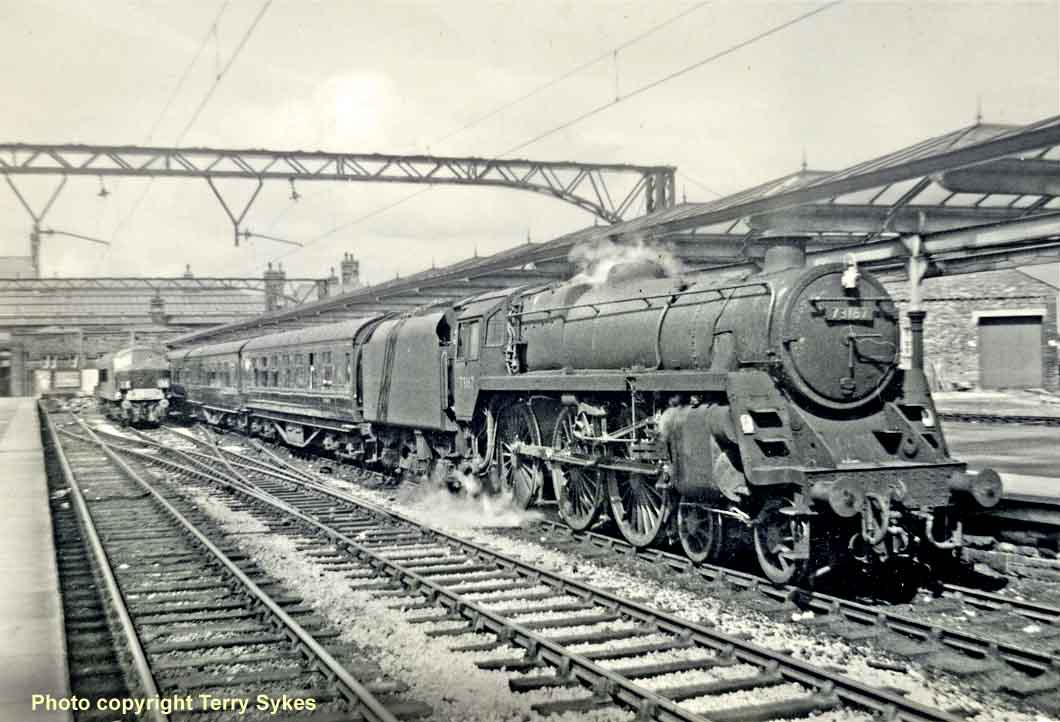
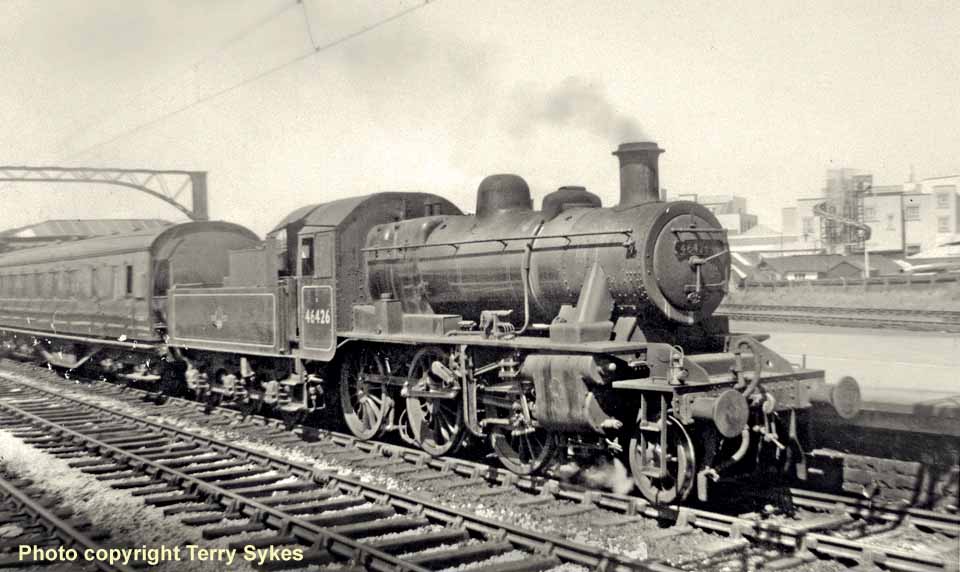
(Above) Later that same day Ivatt Class 2MT Mogul No 46426 awaits departure at Promenade station. Not too sure what the engine is up to since it is still showing 'light engine' code lamps. This was another Ivatt LMS design considered too good to miss by Robin Riddles; there is very little difference between this class of locomotive and the new BR Standard Class 2MTs in the 78000-78064 numbered series.
Not too much else going on in Morecambe you might think? Well! Two days before we went home I was woken up by an engine's whistle just after 6am in the morning, but even at such an ungodly hour I just had to have a quick look! Peering out of the bedroom window I expected to see a grimy old tank engine shuffling empty wagons; I couldn't believe my eyes! Snaking out of the station was a really long train of maroon carriages headed by a beautifully-prepared green 'Duchess' Pacific No 46250 City of Lichfield; I was witnessing the departure if the 'Ulster Express' to London. What a pleasant shock that was! Since the very next morning was to be our last day we waited expectantly and, sure enough - another green Duchess turned up! We went home that day feeling quite annoyed with ourselves at the thought of all the other 'Duchesses' we had missed on the 'Ulster Express, however we later found out that the usual haulage for this train were the 'Royal Scot' or 'Jubilee classes, which offered some consolation.
It was a good holiday though, as Keith and I went up to Hest Bank for the day to spot the Anglo-Scottish expresses on the West coast Main Line. I remember being told off for fighting with my brother when a guard opened the door and found us rolling about on the floor in our non-corridor carriage! 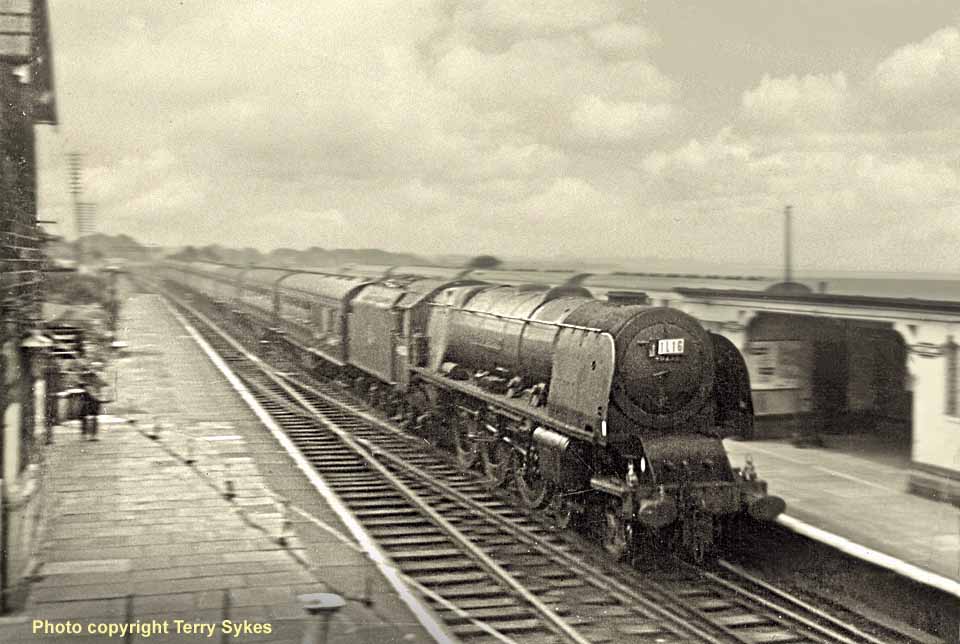
(Above-Below) Hest Bank was great! Taken from the steps of the footbridge, the first Brownie 127 shot shows 'Duchess' Pacific No 46236 City of Bradford rushing through Hest Bank station at high speed with a northbound express. The slow shutter speed and cheap lens actually enhances this composition; Claude Monet would have been proud of it! Note the roofs of the camping coaches behind the station looking out to sea. (Below) 'Jubilee' class No 45568 Western Australia shows no visible signs of having picked up water as it speeds away from Hest Bank water troughs with a thirteen coach southbound express. 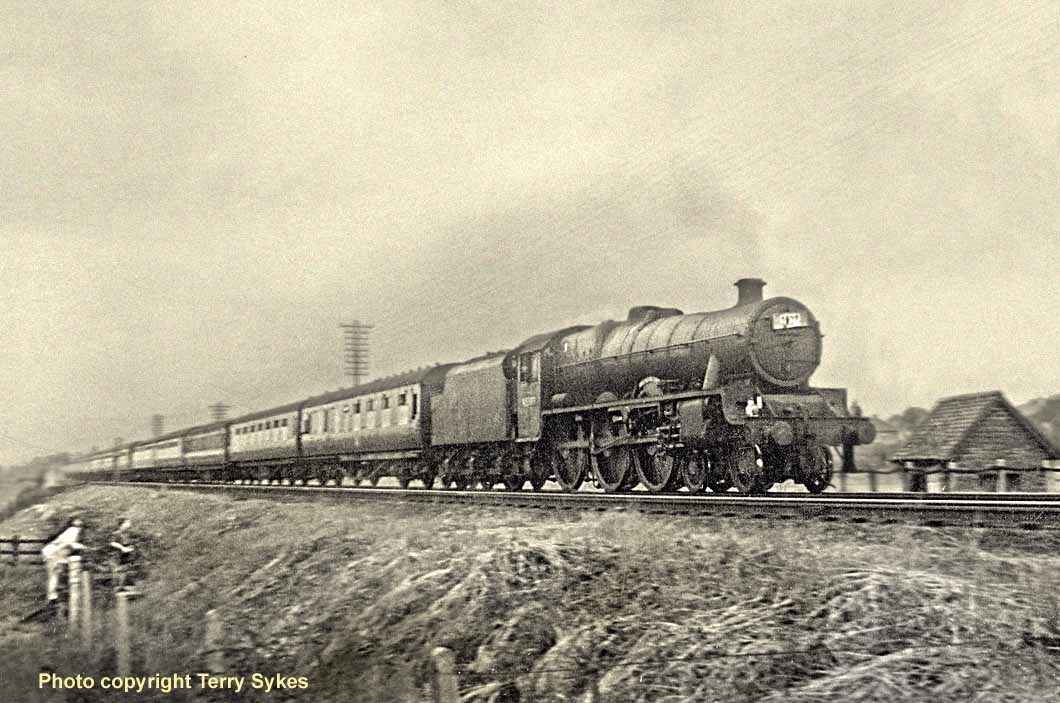
All at once the race was on! Train spotting had become more than just a hobby, it became an obsession and almost every weekend my brother Keith and myself, along with spotting pals Brian Killick and Keith Burnham - 'the gang of four' - would either catch the train to Leeds, or cycle the ten miles from home in Saltaire near Shipley. The hilly journey took more than an hour and was a hard slog for me - unlike the other three I didn't have a full size bike with gears - but on arrival at Leeds the far-flung sheds at Holbeck, Neville Hill, Stourton and Farnley were ten times easier to reach. We never once set foot in Copley Hill though, but all the other Leeds sheds fell frequently to us, and it seems incredible now to think of the perilous liberties we took; after all we were only twelve and thirteen year-olds, but even at that young age it was nothing for us to disappear for the entire day at weekends with little more than a couple of bob - 2/- equates to 10p in today's money - plus a bottle of Tizer and sandwiches...
(Above-Below) In 1961 I did a morning paper round for my local Saltaire newsagent, Mr Lindley, a keen railway enthusiast who managed to get me a ticket for the Railway Correspondence and Travel Society's 'Borders Rail Tour' on 9th july 1961. This photo of Class 8P Pacific No 46247 City of Liverpool awaiting departure at Leeds City station is probably right at the limit performance-wise of my humble Coronet 44… a large subject, close up, decent light. We left Leeds at 09.50 for the first leg along the Aire Valley line to Skipton and Hellifield, diverging at Settle Junction for the Settle-Carlisle line, however I don't remember too much about the climb to Ais Gill summit as I was wedged between a couple of big blokes away from the window, but I do recall some high speed running on the way down to Carlisle, where 46247 was changed at Petteril Bridge Junction for a couple of Class B1s Nos 61242 Alexander Reith Gray and 61290 which hauled the second leg of the tour to Hawick. There was a lot of activity at Hawick station, where I took a picture (below) of Class D34 4-4-0 No 256 Glen Douglas and Class J37 0-6-0 No 64624 which hooked on for the next leg via Belses, Kelso Junction, St Boswells, Ravenswood Junction, Greenlaw, Ravenswood Junction, St Boswells, Kelso Junction, Rutherford and Roxburgh for an out-and-back run to Jedburgh before continuing via Kelso, Coldstream and Norham to Tweedmouth. Now on the ECML metals, Class A1 Pacific No 60143 Sir Walter Scott was responsible for run to Newcastle where Class A3 60074 Harvester took the final leg south to Leeds, diverging from the ECML to Northallerton for the run via Ripon and Harrogate arriving back at Leeds City at 21.20pm...details of the tours featured on this page can be found on the excellent 'Six Bells Junction' website HERE 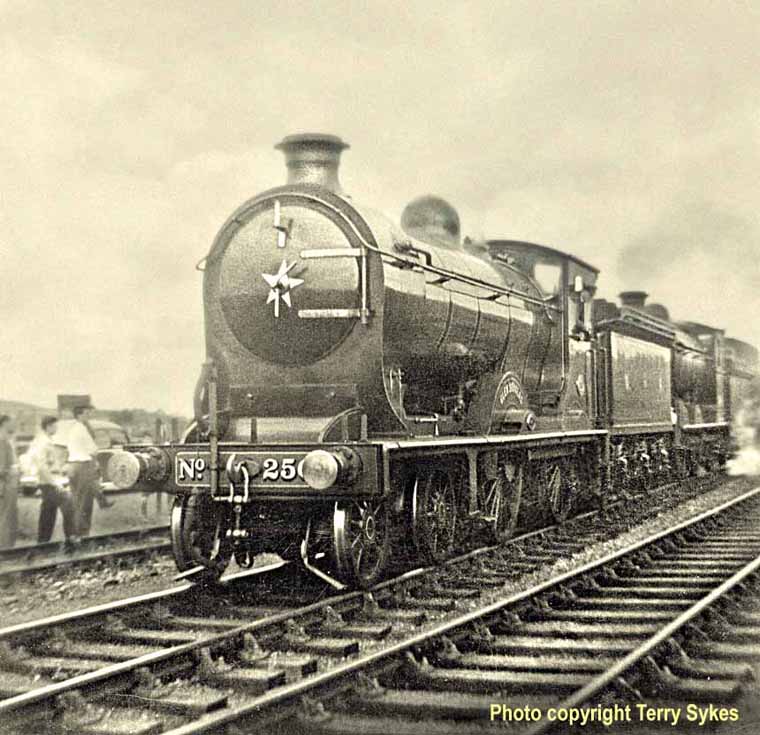

(Above-Below) The Bingley Secondary Modern School Railway Club's Doncaster trip found Class A4 No 60034 Lord Farringdon being cleaned and prepared for its next tour of duty. Originally numbered 4903 and named Peregrine, this A4 entered traffic on 1st July 1938 and was for a time used on the WCML during the 1948 Locomotive Exchanges. No 60034 was allocated to seven depots during its career: starting at Doncaster from new, followed by Kings Cross Top Shed, Grantham, back to Kings Cross, then to New England before a transfer to the ScR's St Margarets and finally Aberdeen in May 17th 1964. It was withdrawn from Aberdeen on 24 August 1966 and cut-up at Hughes, Bolckow, Blyth in October 1966. This Brownie 127 shot dates it from late 1961 to early 1962, by which time the club members are all looking much more mature and in long trousers since the York trip. (Below) The picture of an ex-Works Class A3 No 60103 Flying Scotsman was taken on the same day, and perhaps could date the trip exactly if anyone knows when it was last overhauled at Doncaster Works.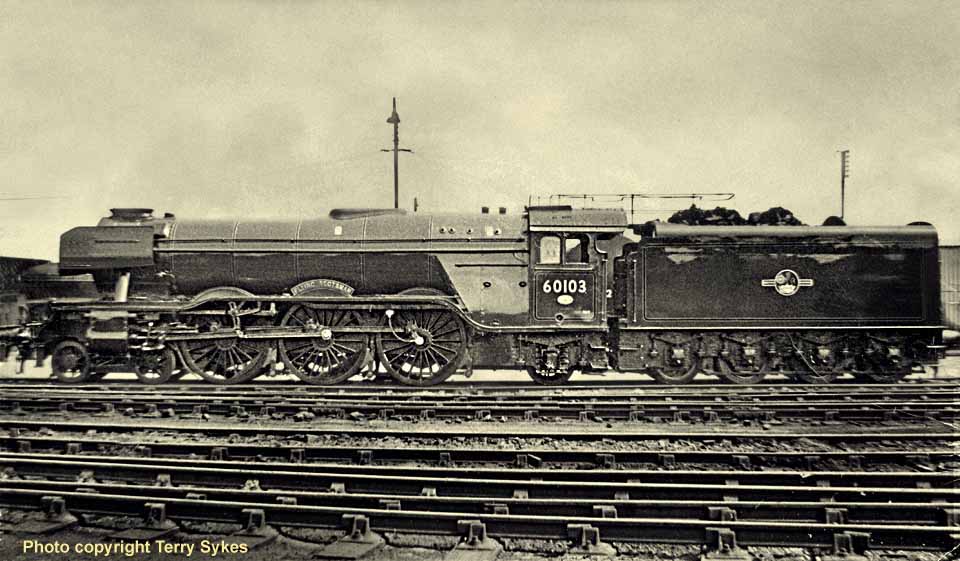

(Above) Another day we decided on a trip to Doncaster and caught a train from Bradford Exchange to Wakefield Westgate where we were pleased to see that our connection to Doncaster was hauled by 60003 Andrew K McCosh. Look at the number of spotters about on Wakefield station, none of them are with our party. This was the first time I had ever been behind an A4 but it was a very pedestrian run to Doncaster. 
(Above-Below) A locomotive nameplate, Andrew K McCosh - measuring 87in long, comprised of two parts permanently bolted together - went under the hammer for £20,100 at a Great Western Railwayana Auction in April 2015. Built at Doncaster in August 1937 and numbered 4494, this Gresley A4 Pacific was originally named Osprey until October 1942 when it was renamed Andrew K McCosh after the LNER Director and Chairman of the Locomotive Committee of the Board. Then in 1946 it was renumbered by the LNER to 596 and very quickly to No 3. Finally, in March 1949 it became BR number 60003. It was a long time resident of Kings Cross and Grantham sheds, regularly switching between the two up to withdrawal from traffic in December 1962. (Below) Robert Parr, the Bingley Secondary Modern School teacher I mentioned earlier, was also a superb photographer. He used a twin lens reflex box camera and his skill in the darkroom was astonishing. Just look at this picture of Thompson B1 61024 Addax at Wakefield Westgate. The locomotive is backing onto the Bradford portion of an express from London Kings Cross; I hope the fireman is going to add another code lamp above the other buffer, at the moment the engine is showing a pickup goods or ballast working. 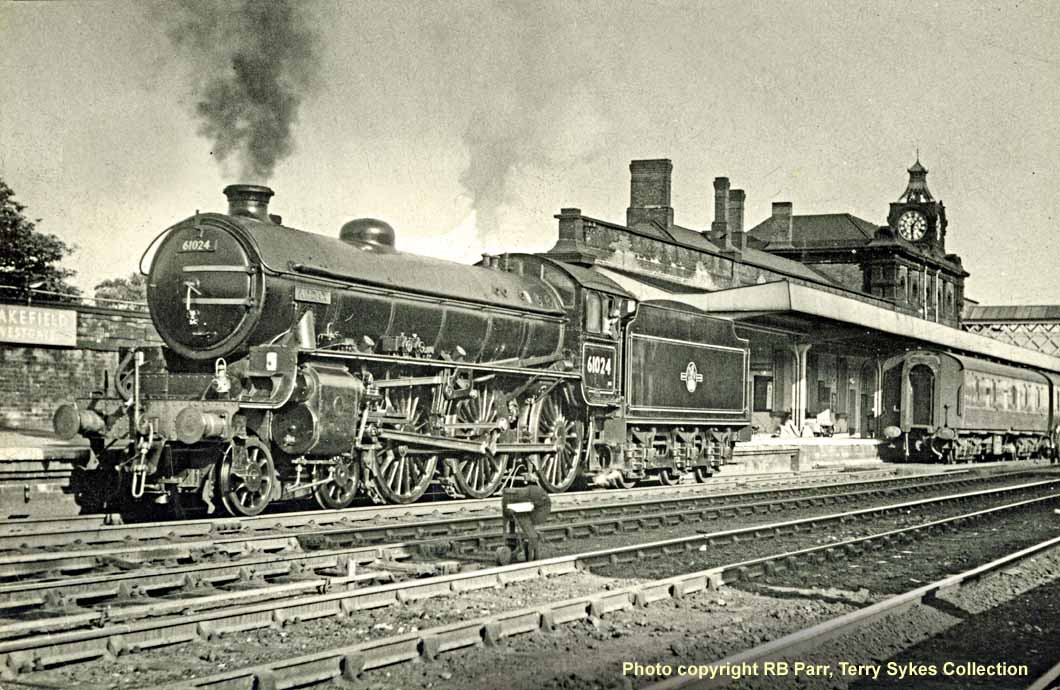
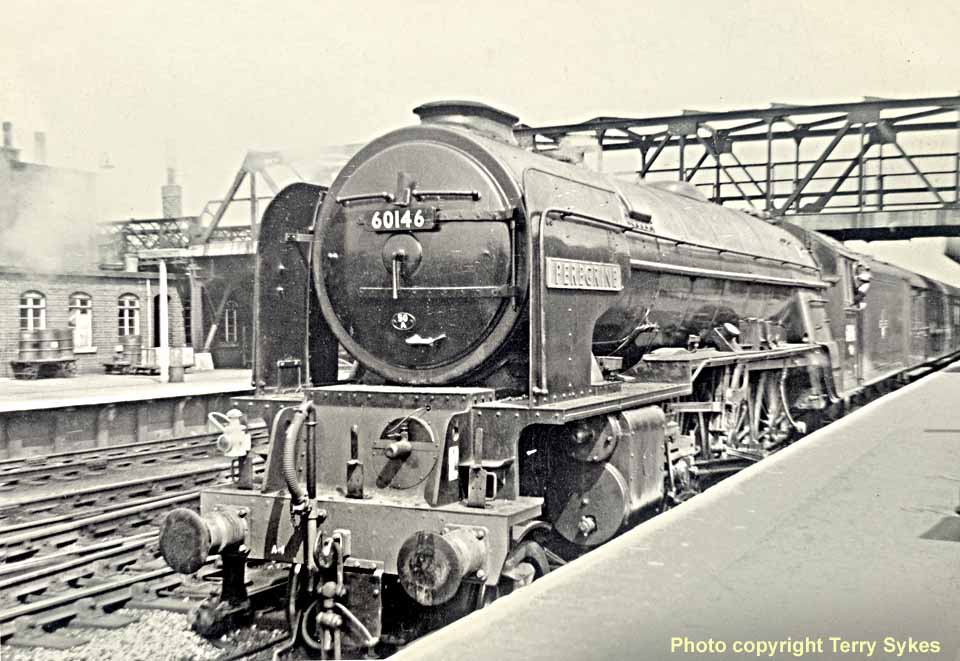
(Above) We had an enjoyable day at Doncaster, spending most of the time on the footbridge, but I did venture down to take this picture of a very clean Class A1 60146 Peregrine on a southbound stopping train. I believe these pictures were taken in the latter part of 1961 and it may have been the first pictures taken with my Brownie 127. Happy days!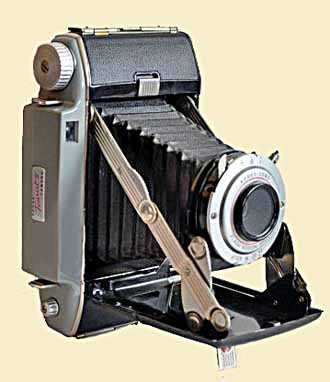 (Left-Below) Looking back at my photographs and the weather conditions in which they were taken, it appears I only took pictures on three separate visits to Leeds, the first being early 1963. I had been given a Kodak 'Tourist' 620 medium-format folding camera by my stepdad late in 1962; it had a 1/200th second maximum shutter speed, a f4.5 lens and delivered generous-sized 6cm by 9cm negatives (roughly 2½" X 3½") and fit snugly into my jacket pocket when closed...I just loved it! A year earlier I had joined the Bingley Secondary Modern School's Photographic Club and the lens quality was very evident when working in the darkroom. This shot of EE Type 5 Deltic D9014 standing lifeless outside Leeds Central station on a bitterly cold winters morning is a good example of a picture dating itself. D9014 entered service in September 1961, but the fact that it remains nameless in this shot means that it was taken early in 1963; the locomotive was later named 'The Duke of Wellington's Regiment' at a ceremony held at Darlington station on 20th October 1963; this Regimental name didn't become available until it was relinquished by 'Royal Scot' class No 46145 following its withdrawal from Holbeck in November 1962.
(Left-Below) Looking back at my photographs and the weather conditions in which they were taken, it appears I only took pictures on three separate visits to Leeds, the first being early 1963. I had been given a Kodak 'Tourist' 620 medium-format folding camera by my stepdad late in 1962; it had a 1/200th second maximum shutter speed, a f4.5 lens and delivered generous-sized 6cm by 9cm negatives (roughly 2½" X 3½") and fit snugly into my jacket pocket when closed...I just loved it! A year earlier I had joined the Bingley Secondary Modern School's Photographic Club and the lens quality was very evident when working in the darkroom. This shot of EE Type 5 Deltic D9014 standing lifeless outside Leeds Central station on a bitterly cold winters morning is a good example of a picture dating itself. D9014 entered service in September 1961, but the fact that it remains nameless in this shot means that it was taken early in 1963; the locomotive was later named 'The Duke of Wellington's Regiment' at a ceremony held at Darlington station on 20th October 1963; this Regimental name didn't become available until it was relinquished by 'Royal Scot' class No 46145 following its withdrawal from Holbeck in November 1962.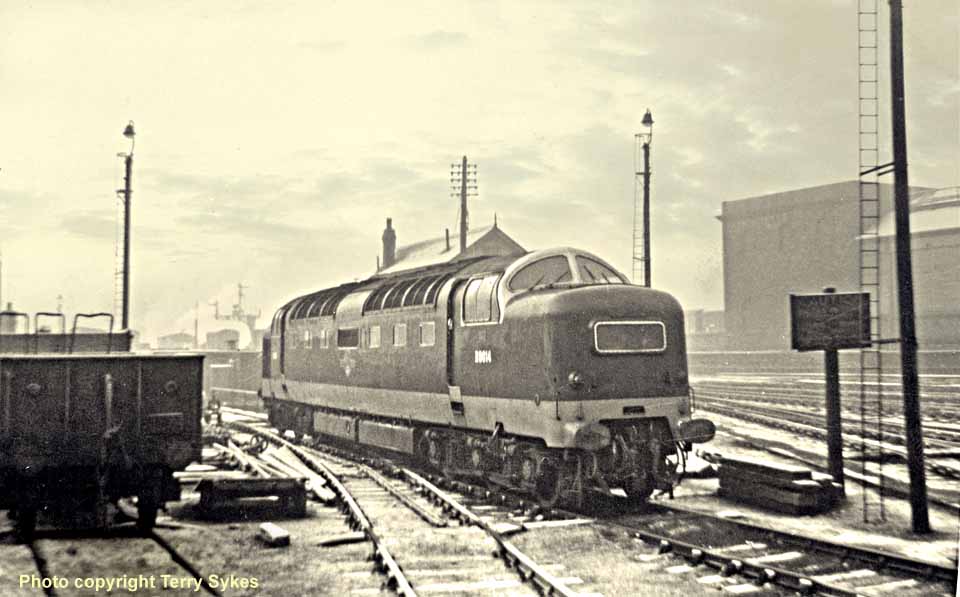
(Below) Leeds Central station was always worth a quick visit, I just wish we'd had enough gumption to check out the timetable now and again rather than just taking pot luck and hoping something of interest might turn up! Here Class A1 Pacific No 60114 WP Allen awaits departure with a stopping train in the spring of 1963. The locomotive is sporting a Doncaster shed plate (36A) and may be returning home.
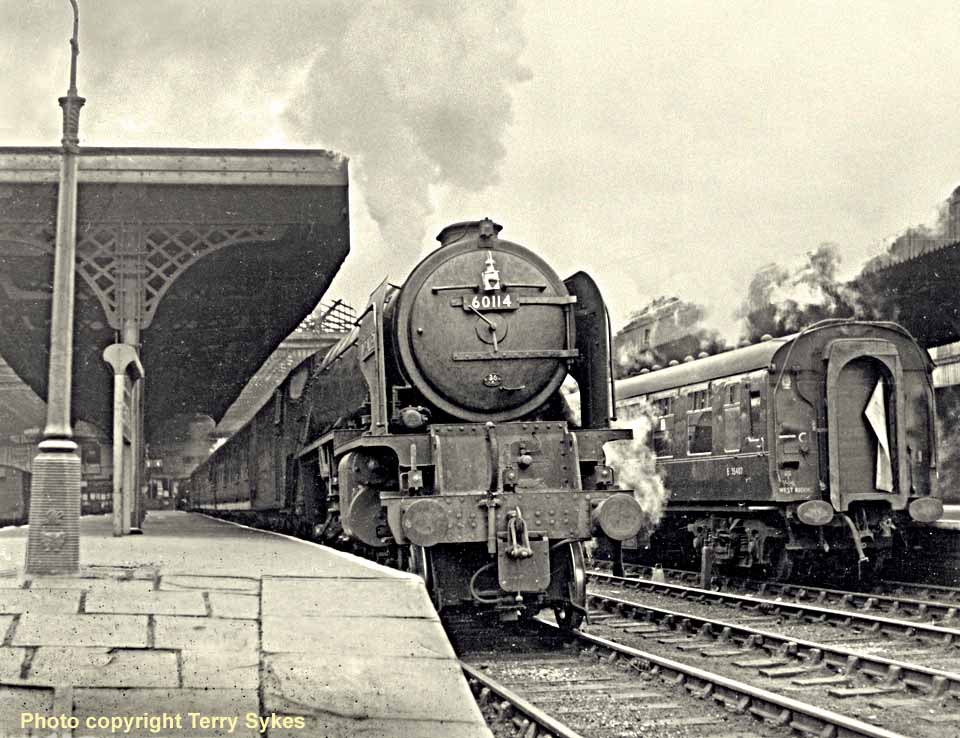
In those days trusting parents allowed their offspring great independence, and the happy memories of our escapades continue to flood back all these years later. Weekdays were less frenetic, but most days after school we organised a kick around on the local 'rec' at the bottom of the street alongside the railway not far from Saltaire station; this was a busy little station surrounded by Sir Titus Salt's huge woollen mill and his beautiful 19th century model village he constructed for his workers. Saltaire is located just eleven miles north of Leeds on the Midland Railway's Anglo-Scottish main line which runs through the Aire Valley to Skipton and beyond to Carlisle, and without realising it at the time the green urban corridor provided us with the perfect playground where we fulfilled our passion for playing both football and train spotting! These were great times, and it's surprising how often the memory of it all would resurrect itself in the most unusual places, such as the time I was bedridden with temperatures soaring high...
'SICK IN AFRICA'
You always remember your first Streak!
by
Terry Sykes
While lying on the sickness bed in country where my work had led, to stop the fever addled brain from thought of dying half insane. A rabid dog had passed me by! of poisoned water! mosquito fly? It 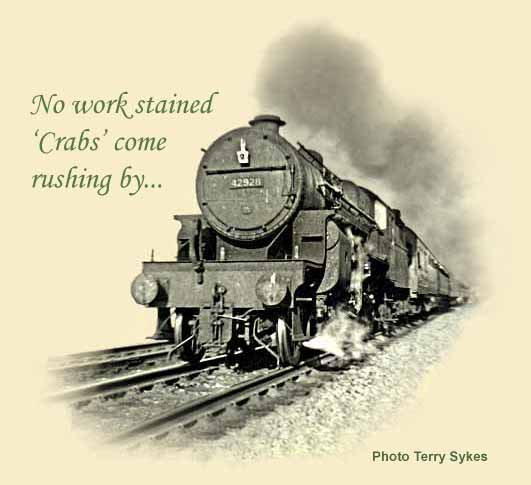 helped to force my mind away, perhaps recall some other days! And now I see a better place, a lovely park with palms and lakes. A holiday had just begun, it's summer and it's sixty one. The air is warm the soil is red, we drink our tea and eat our bread, but what makes it such a lovely spot? A railway runs right through the lot!
helped to force my mind away, perhaps recall some other days! And now I see a better place, a lovely park with palms and lakes. A holiday had just begun, it's summer and it's sixty one. The air is warm the soil is red, we drink our tea and eat our bread, but what makes it such a lovely spot? A railway runs right through the lot!
No work stained 'Crabs' come rushing by, no 'Derby 4s' with wheezing cry, no 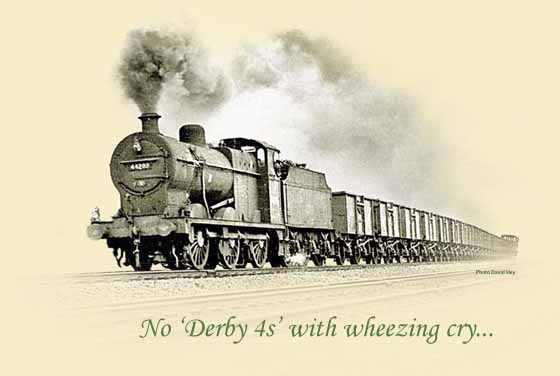 'Black 5' hurries Morecambe bound, no 'Mucky Duck, with leaking gland!
'Black 5' hurries Morecambe bound, no 'Mucky Duck, with leaking gland!
No, every engine here is green - and, dare I say it, most are clean. And each has brass like burnished flame, and most the engines have a name. The stately 'Hall', the friendly 'Grange', the little 'Manors' stomping by, in Combined Volume newly gained, each is found and underlined. And now a 'Castle' rounds the bend, and drifts towards its journey's end,-the coaches full of pandemonium, the headboard proudly states:- 'Devonian'.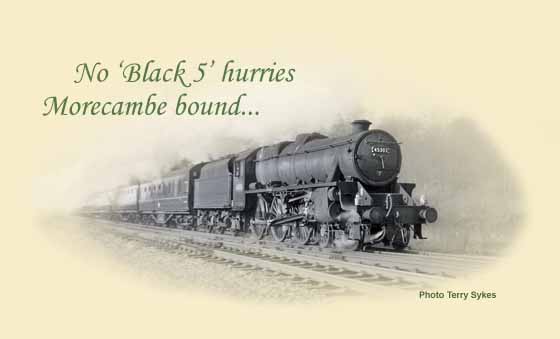 And now my young brain has to think, I've seen this train before! But it wasn't skirting round the coast, on a sunny southern shore, Is this the train at Shipley caught, to run to Leeds with friends to spot, with Fairburn engine bunker first, rushing through the Leeds suburbs. I guess it is, there's only one!---I never knew, Devonian!
And now my young brain has to think, I've seen this train before! But it wasn't skirting round the coast, on a sunny southern shore, Is this the train at Shipley caught, to run to Leeds with friends to spot, with Fairburn engine bunker first, rushing through the Leeds suburbs. I guess it is, there's only one!---I never knew, Devonian!
But now we're told, 'This ain't the spot!' The better stuff is  further off. A trip by train will do the trick, and show us what we've really missed! So brother, I, and new found friends, the next day early, make amends, behind a freshly painted 'Grange' we forage east in search of trains. And Newton Abbot soon is passed, the main line is beneath us, and soon we're there at Exeter, and Oh! What sights to greet us! There's 'Castles', 'Kings', and 'Counties' too, all in wild profusion, the Southern too does come and go, to add to the allusion.
further off. A trip by train will do the trick, and show us what we've really missed! So brother, I, and new found friends, the next day early, make amends, behind a freshly painted 'Grange' we forage east in search of trains. And Newton Abbot soon is passed, the main line is beneath us, and soon we're there at Exeter, and Oh! What sights to greet us! There's 'Castles', 'Kings', and 'Counties' too, all in wild profusion, the Southern too does come and go, to add to the allusion.
And then the sight that to this day still causes me elation, 'Earl of Powis' Castle class, rolls into the station. The train it pulls seems much too long for one of small dimension, I wait to see a banker fix, I'm filled with 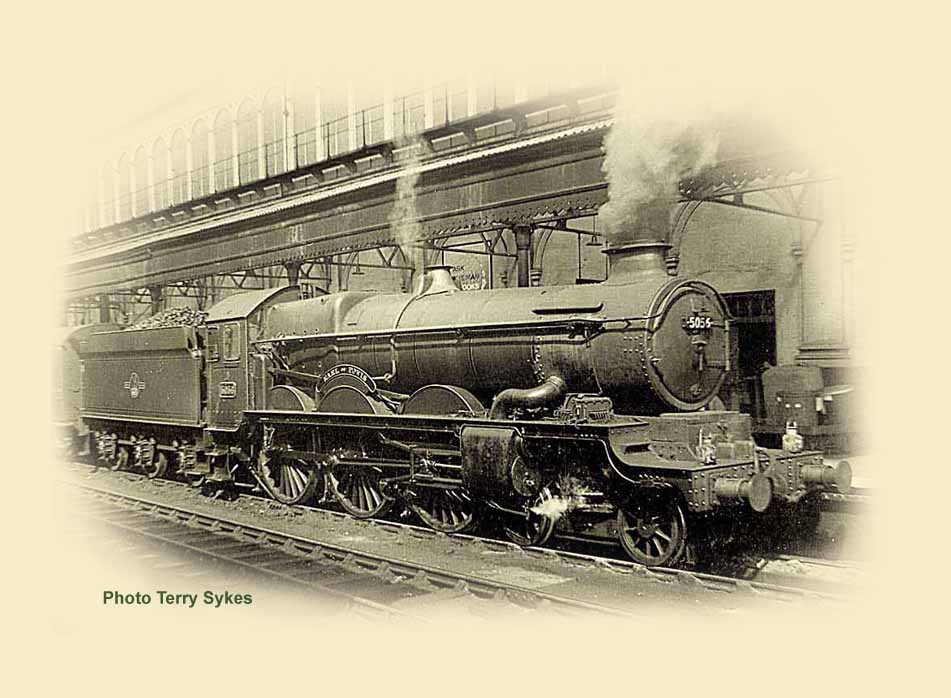 apprehension. The gradient going west to me seems very steep and awesome, I'm just 14 and I know naught of power, steam and motion. And then she's off with fearsome blast, and every turn more power, the thirteenth carriage passes by near twenty miles per hour! In days to come, I'd read of course, of Castles climbing from Kings Cross, and how each day they'd beat the time, of larger engines on the line. But now I'm young and standing there, mouth agape and smoke filled hair, the wondrous days when I was young on holiday in sixty one.
apprehension. The gradient going west to me seems very steep and awesome, I'm just 14 and I know naught of power, steam and motion. And then she's off with fearsome blast, and every turn more power, the thirteenth carriage passes by near twenty miles per hour! In days to come, I'd read of course, of Castles climbing from Kings Cross, and how each day they'd beat the time, of larger engines on the line. But now I'm young and standing there, mouth agape and smoke filled hair, the wondrous days when I was young on holiday in sixty one.
And now those memories fade away, and I recall some other days...days that soon were lost for good, on Central Station, Leeds we stood...the crowds were milling left and right, a train had just arrived, we made our  way excitedly, to see what was the prize. The noise of engine louder grew, as we passed through the foyer...what would this hissing monster be? Dante! Ladas! Aboyuer? The nameplate seen is long and straight, to suit the engines massive weight, we stood and gaped in dumbstruck awe, amid the engine's muted roar. We'd never heard of Peppercorn, or Thompson often heaped with scorn, or Gresley and his masterpiece, we stood and stared in front of the beast, And wondered what the name held forth, what could it mean? COCK O' THE NORTH!
way excitedly, to see what was the prize. The noise of engine louder grew, as we passed through the foyer...what would this hissing monster be? Dante! Ladas! Aboyuer? The nameplate seen is long and straight, to suit the engines massive weight, we stood and gaped in dumbstruck awe, amid the engine's muted roar. We'd never heard of Peppercorn, or Thompson often heaped with scorn, or Gresley and his masterpiece, we stood and stared in front of the beast, And wondered what the name held forth, what could it mean? COCK O' THE NORTH!
And many times we stood as well on Leeds's other station, and watched as the confusion grew and passenger irritation. For left and right there stood a train, and each one bore the same proud name -'Thames Clyde Express'. So take your pick! One North, one South, but best be quick!
And then the day I'll not forget, when walking back from Holbeck shed...another group passed on the news - 'Quick back to Central station! There's something there to make your day, cause for celebration!' So rushing back to canal side, we saw what they had seen. For backing over canal bridge, a vision quite supreme! Not only was it my first 'Streak', she was perfect, clean and sleek...a Scottish one no less to boot, ex works and working North 'Na Doot'. The driver gave a three chimed blast, as we waved and cheered him hither. My first A4...and what a score! 24, KINGFISHER!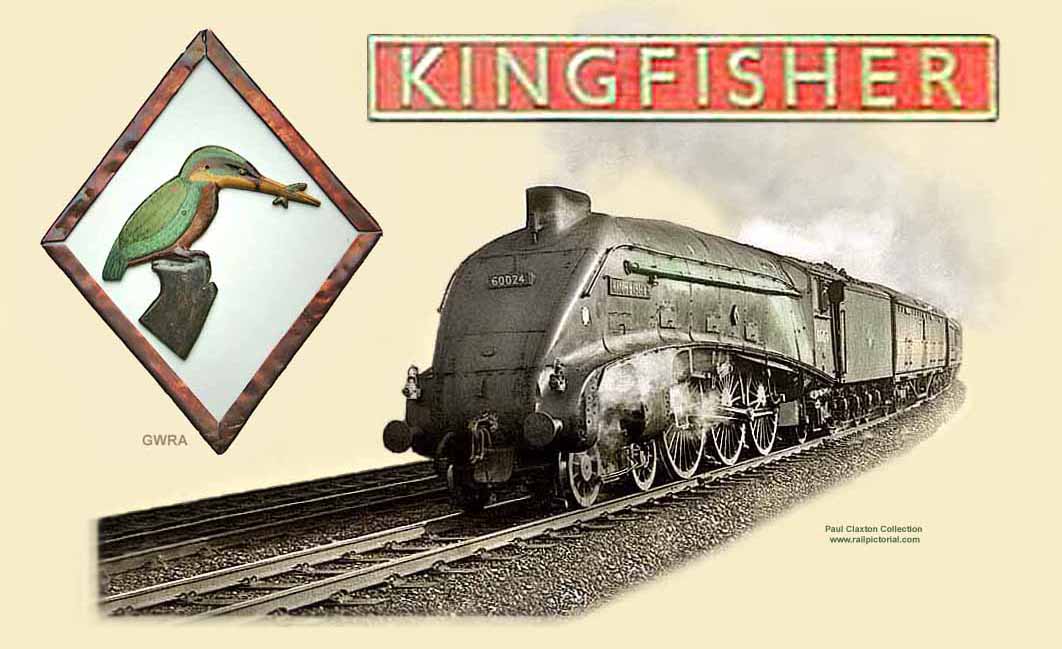
But now my fever's breaking, and memories fading fast...No mosquito, no rabid dog has laid me out to grass, But I cannot understand, it doesn't make much sense, when I think of all the time I've spent tempting providence.But I guess I must accept it, and it doesn't pay to moan - PNEUMONIA IN AFRICA!
And now I'M COMING HOME! (Above-Inset) A locomotive plaque, one of a pair featuring an embossed kingfisher perched on a log with a fish in its beak, went under the hammer for £4,600 at a Great Western Railwayana Auction (GWRA) in November 2007. Both plaques - each measuring 10" x 12½" - were removed by the Royal Navy from the RN Patrol Vessel L70, HMS Kingfisher and presented to British Railways on 21st October 1954. Original in every way, the plaque included the original backing board stamped 'Top Starboard' upon which it was laid and held in place with a copper-brass frame screwed from the side. The plaque was mounted on each side of the boiler casing of Class A4 Pacific No 60024 Kingfisher by fitters at Haymarket. For the record, 60024 was built at Doncaster Works in December 1936, renumbered 585 in March 1946 and then No 24 in May 1946 before eventually becoming 60024 in June 1948. The loco was allocated new to Haymarket and spent most of its working life there apart from brief spells at Kings Cross and Doncaster and, at the end, Dalry Road, St Margarets and Aberdeen Ferryhill from where it was withdrawn in September 1966 to be cut up at Hughes Bolckow Ltd at North Blyth in February 1967.
(Above-Inset) A locomotive plaque, one of a pair featuring an embossed kingfisher perched on a log with a fish in its beak, went under the hammer for £4,600 at a Great Western Railwayana Auction (GWRA) in November 2007. Both plaques - each measuring 10" x 12½" - were removed by the Royal Navy from the RN Patrol Vessel L70, HMS Kingfisher and presented to British Railways on 21st October 1954. Original in every way, the plaque included the original backing board stamped 'Top Starboard' upon which it was laid and held in place with a copper-brass frame screwed from the side. The plaque was mounted on each side of the boiler casing of Class A4 Pacific No 60024 Kingfisher by fitters at Haymarket. For the record, 60024 was built at Doncaster Works in December 1936, renumbered 585 in March 1946 and then No 24 in May 1946 before eventually becoming 60024 in June 1948. The loco was allocated new to Haymarket and spent most of its working life there apart from brief spells at Kings Cross and Doncaster and, at the end, Dalry Road, St Margarets and Aberdeen Ferryhill from where it was withdrawn in September 1966 to be cut up at Hughes Bolckow Ltd at North Blyth in February 1967.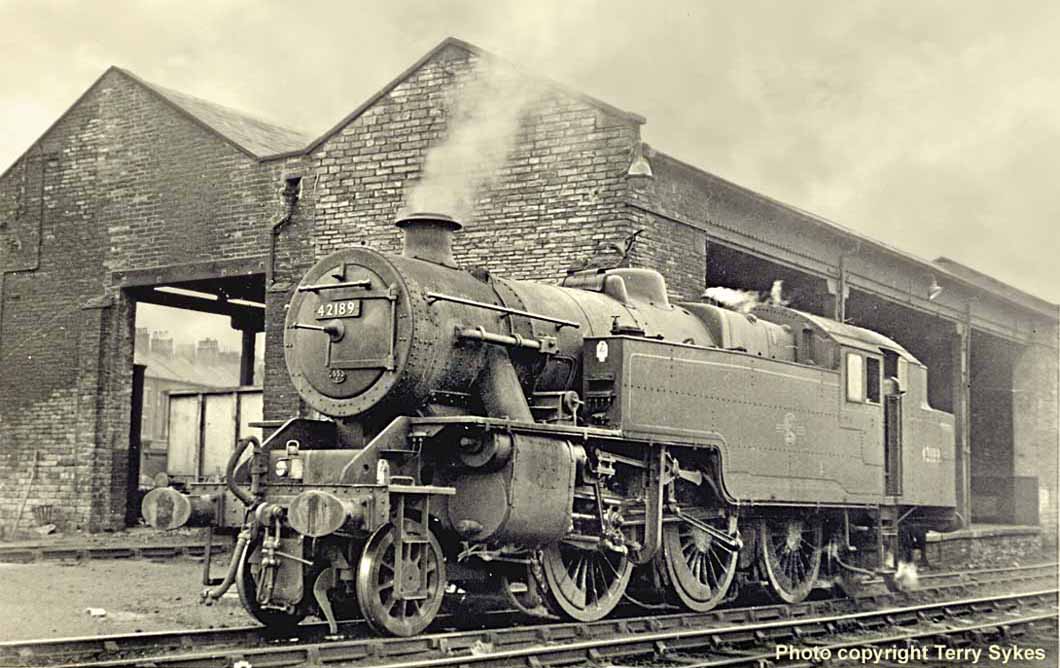
(Above-Inset) Bradford Manningham Shed (55F) was a place I should have visited more often! It was just a 25 minute bike ride away, but I only ever recall going there on two or three occasions! Whilst Manningham shed was closer to home and very easy to gain access, the lure of Leeds Holbeck shed's 'Jubilees', 'Scots' and 'Britannias' was just too great. And yet Manningham provided motive power for trains I have only the 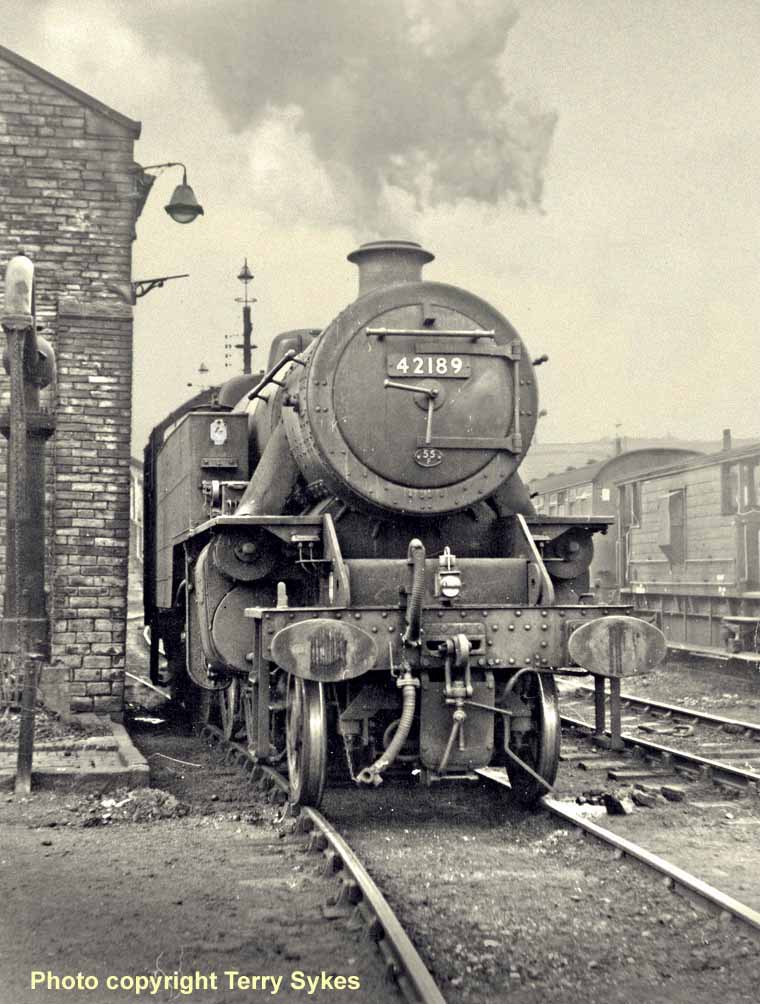 fondest memories, such as the 'Devonion' and other southbound expresses from Bradford Foster Square station.
fondest memories, such as the 'Devonion' and other southbound expresses from Bradford Foster Square station.
What I would give to see, or travel behind, a bunker-first Fairburn 2-6-4T again! A 400 ton train of ten or twelve coaches between Bradford and Leeds should have been a tough task for these modestly-dimensioned locomotives, but they seemed to handle it with ease.
We usually caught the train to Leeds at Shipley, starting off very slowly at first but very soon we'd be counting the number of rail joints in 41 seconds, rocking and rolling along at a mile a minute and more!
What great workhorses the 2-6-4Ts were! They provided the perfect power for the twelve-mile sprint to Leeds, returning later with the next Bradford-bound express without any need for turning; indeed they were just as fast backwards as they were forwards!
The pictures above and inset shows Fairburn class 4MT tank locomotive No 42189 displaying its handsome lines beside the coaling plant at 55F. I've added the second picture showing an interesting mix of rolling stock on the right hand side. Inside the roundhouse you'd often find a Britannia or a Royal Scot rubbing shoulders with the usual freight and shunting locomotives, but these would usually only provide power for the north and westbound services. 
(Above-Below) 'Britannia' Pacific No 70035 Rudyard Kipling rests inside the roundhouse at Manningham shed. I can't imagine the shed staff would be too happy with the engine blowing off steam inside the building! A large express passenger locomotives always seemed to be a bonus when you found one lurking in the gloom inside the shed. (Below) Station Pilot Standard Class 2MT No 78014 shuffles coaches in and out of Forster Square Station on a sunny summer afternoon in 1964. .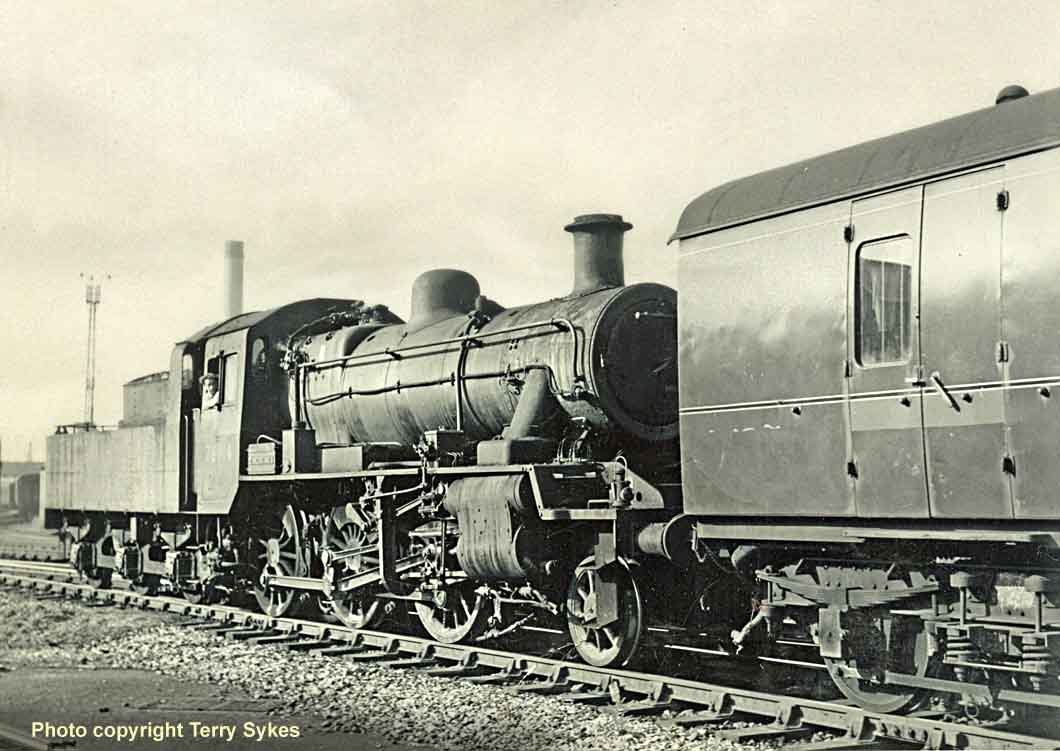
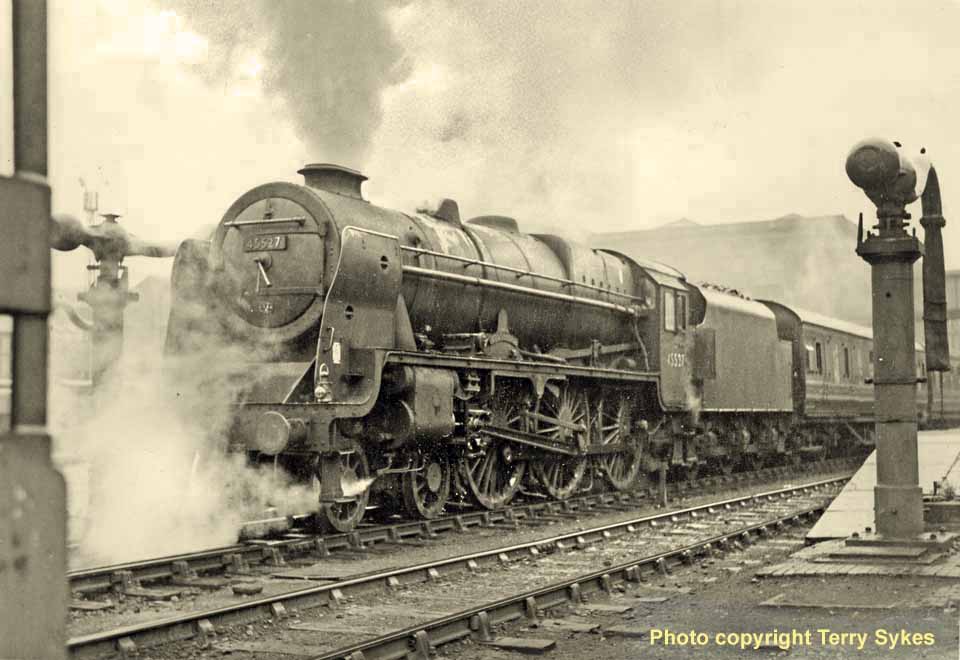
(Above) It's worth mentioning before we go much further that paperwork and record keeping has never been one of my strong points, and the only physical record I have of my schoolboy spotting days are two battered old photo scrapbooks. Add to this an unreliable memory and it's proving to be a real task to get any kind of an accurate timeline into my story. On the other hand, the compilation of this page is turning out to be good fun and also very interesting.
Every picture tells a story, they say, which is very true. For instance I was still at school when I took these pictures of rebuilt 'Patriot' No 45527 Southport 50-odd years ago, but the memory of it is slowly returning. In this shot of Bradford Forster square (above) there is steam evident at both the chimney and cylinder drain cocks, which means the driver has got the regulator open, however the locomotive is not departing because I caught this very same train to Shipley. Instead the driver is backing up to the train to couple on…and on closer inspection you'll notice the footplate gate is open, which suggests the fireman has climbed down from the footplate to do the coupling.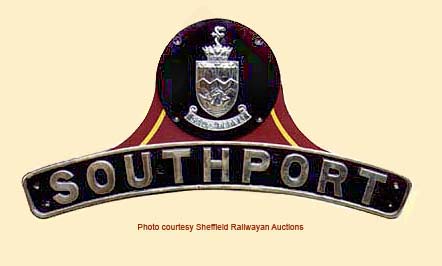 (Inset) 45527 was among the twelve members of the LMS 'Patriot' Class 4-6-0s named after Lancashire and North Wales coastal resorts served by the LMS. Built at Derby as No 5944 in 1933, later renumbered 5527 in 1934, the loco was named 'Southport' in 1937 and spent most of its working life based at 8A Edge Hill, the nearest shed to Southport, moving later to Llandudno Junction, Holyhead, Willesden, Carlisle Upperby and Carlisle Kingmoor, from where it was withdrawn in December 1964 and cut up at the West of Scotland Shipbreaking Co Troon in April 1965. This nameplate measures 34½" long, and features the coat-of-arms and matching badge depicting the town of Southport; the plate recently went under the hammer at a Sheffield Railwayana Auction for £24,500. The nameplate is clearly visible in the above shot...
(Inset) 45527 was among the twelve members of the LMS 'Patriot' Class 4-6-0s named after Lancashire and North Wales coastal resorts served by the LMS. Built at Derby as No 5944 in 1933, later renumbered 5527 in 1934, the loco was named 'Southport' in 1937 and spent most of its working life based at 8A Edge Hill, the nearest shed to Southport, moving later to Llandudno Junction, Holyhead, Willesden, Carlisle Upperby and Carlisle Kingmoor, from where it was withdrawn in December 1964 and cut up at the West of Scotland Shipbreaking Co Troon in April 1965. This nameplate measures 34½" long, and features the coat-of-arms and matching badge depicting the town of Southport; the plate recently went under the hammer at a Sheffield Railwayana Auction for £24,500. The nameplate is clearly visible in the above shot...
(Below) The second shot of 45527 leaving Shipley appears to be a hurried shot and badly framed, which of course is exactly what it is! The moment the train pulled into Shipley station I jumped off and dashed 200 yards up the road behind the wall, then ran across the road bridge and back down the opposite side of the line to photograph its departure.
So why didn't I get off the train at Saltaire station nearer my home? Because it's not the 3.50pm Carlisle stopping train as I had originally presumed, it is carrying express code lamps and wouldn't have stopped at Saltaire! Anyway, what's a mile and a half walk home to someone who's prepared to sprint three hundred yards just to get a second shot of a rebuilt 'Patriot'? 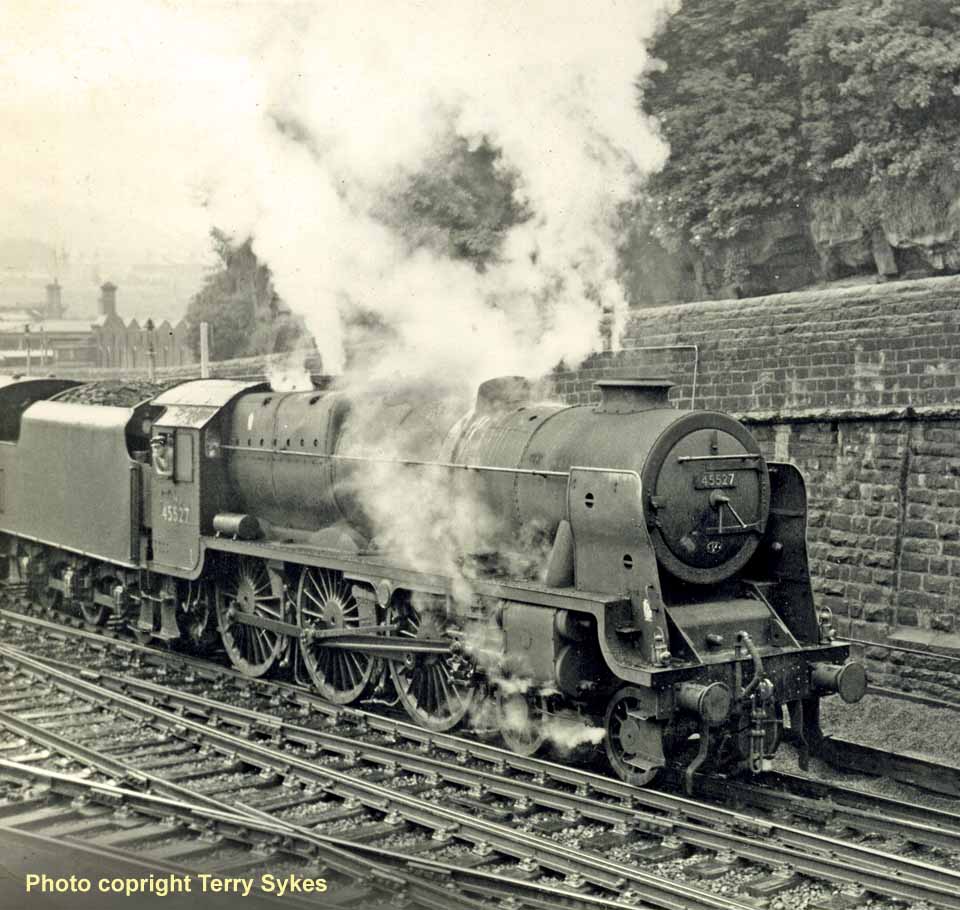
THE FOUR SIDES OF SHIPLEY's TRIANGULAR STATION!
Two and a half miles due north of Bradford Forster Square lies the triangular junction at Shipley which was established in September 1847 when the Leeds and Bradford Railway Company (L&BRC) extended its line from Leeds to Bradford to accommodate the company's extension to Skipton and beyond. Platforms were provided on the Bradford-Leeds curve and the Bradford-Skipton curve, but the Leeds-Skipton curve remained 'platformless' until May 1979 when a new bi-directional platform was opened. However, the clumsy operation of Skipton-Leeds trains switching to the single platform on the 'down' line' was not resolved until a new platform on the 'up' Leeds line was finally opened in 1992. Today Shipley is one of only two triangular stations in the UK: the other being at Earlestown in Merseyside.
(Below) Rail passengers arriving at Shipley will find the line from Bradford Forster Square diverges into an almost perfect triangle…east will take you to Leeds, and west will take you north to Carlisle. However, the route from Leeds barely wanders from its east-west direction for the first 10 miles of its journey, until it reaches Shipley where the contours of the Aire Valley take a north-west bearing and the railway simply follows suit. The sharp curvature of the Bradford-Shipley platform 1 is clearly evident in the above image of 45527; similarly the picture (below) of 'Clan' Pacific 72005 'Clan Macgregor' restarting a Leeds to Bradford Foster Square parcel train from Shipley's platform 4 shows the severity of the southernmost curve. The locomotive is sporting a Carlisle Kingmoor 12A shed code and may be returning later to its home depot on the 3.40pm Bradford Forster Square-Carlisle stopping train. For anyone not familiar with 12A, the shed took great pride in its locomotives, which is evident by this engine having 'Carlisle Kingmoor' stenciled on the buffer beam. Peter Thorpe has a great picture of this locomotive departing Shipley on the 3.40pm Carlisle stopping train on the 23rd April 1964? My photo is undated, but who knows! The two pictures may have been taken on the same day; we may have been 'Ships that passed in the Night'.
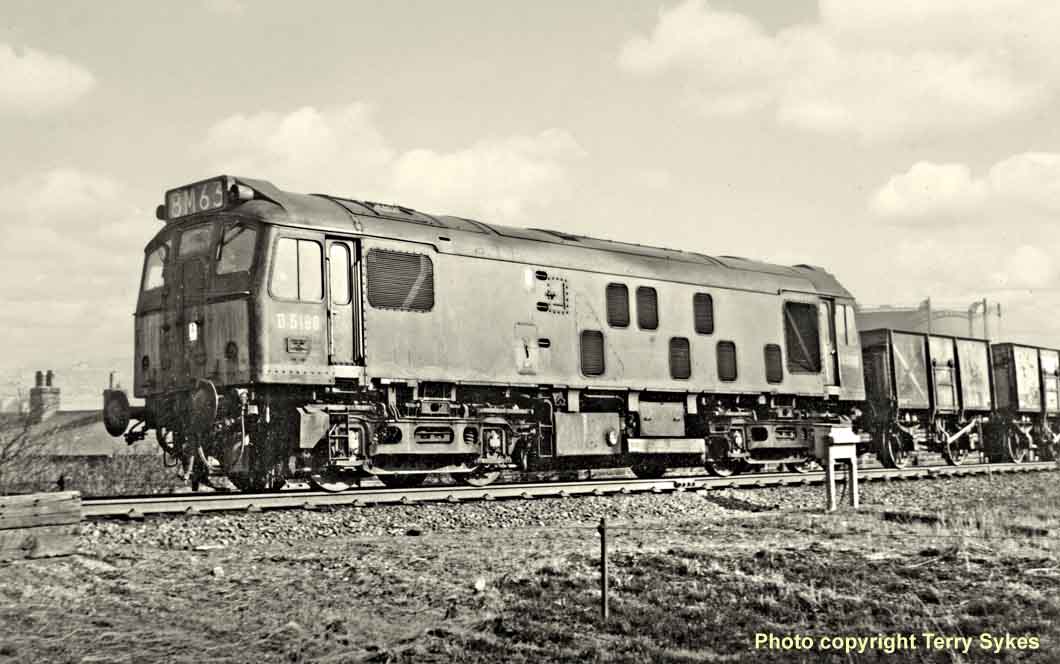
(Above-Below) Finally completing the triangle is the northernmost 'Shipley bend' where the Leeds-Carlisle line avoided the original station. There is a 15mph speed limit here and the screech of tortured wheel flanges on the side of the rails is evidence of the severity of the curve. On the same day that Clan Macgregor made its appearance, Brush Sulzer Type 2 Bo-Bo D5180 takes the bend towards Skipton with a freight working from Leeds. (Below) In the opposite direction Black 5 No 45014 is about to take the curve with a short stopping train for Leeds. The locomotive is passing Bingley Junction, where the divergence of the lines serving Shipley's platform 1 and 2 can be seen in the foreground. Beyond the arch of the bridge the rising gradient of the line can be seen curving north towards Saltaire.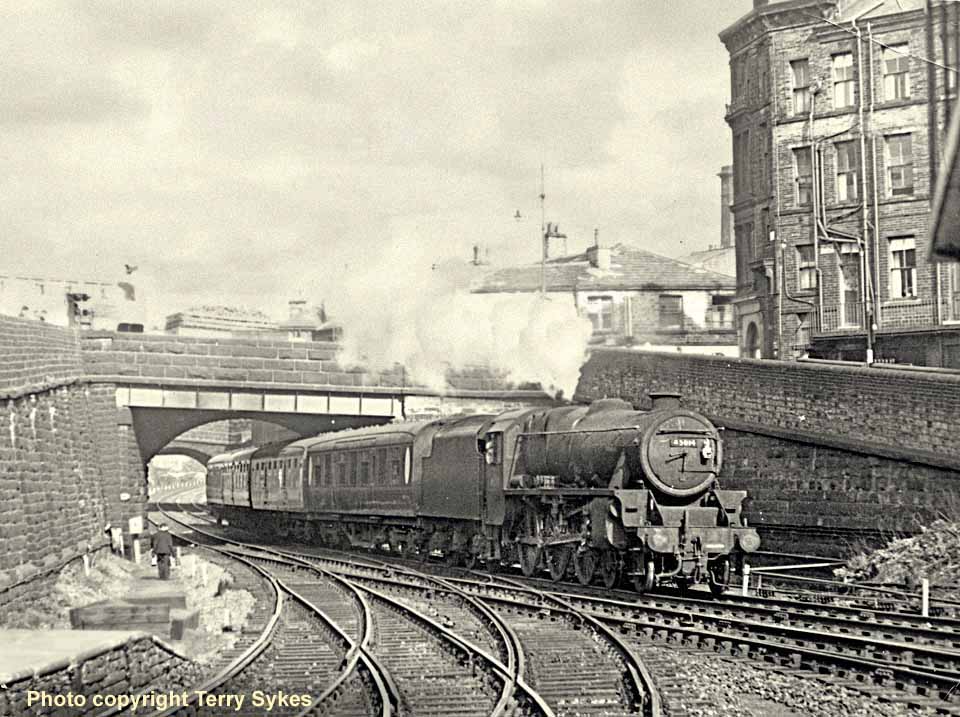
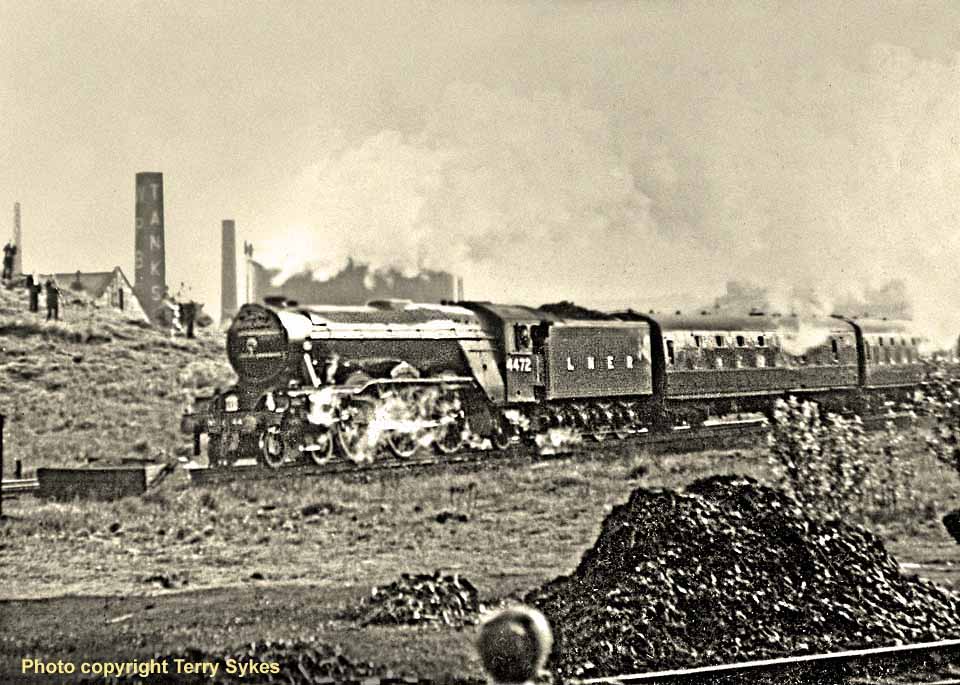
(Above) Fast forward 17 months and preserved Class A3 4472 'Flying Scotsman' is taking the bend with the Warwickshire Railway Society's 'Pennine Railtour' from Birmingham New Street on 4th September 1965; No 4472 was attached at Leeds City for the run to Carlisle Kingmoor via Shap, returning to Leeds via Ais Gill on the Settle-Carlisle line. It's taken me a good while to figure out what caused the odd picture quality on this occasion, then I realized it was taken about six months after I lost my beloved 'Kodak Tourist' camera on Lancaster Station, and I had to make do with a mediocre Halina 35mm camera! Add to that a 400ASA film and a sudden burst of sunlight from an odd angle on the shiny paintwork, and I ended up with this strange, surreal, and grainy image. The grassy wasteland across the tracks was called the 'Sand Bank' - a great place to spend a couple of hours.
(Below) Hang on a minute, though - I said Four Sides! And four you shall have! Such was the demand for trains serving Bradford's booming woollen mills plus the increase in other industrial freight, an avoiding line was built to bypass the platforms - and not just a single track either. Below is a rare picture by RB Parr showing Raven B16/1 4-6-0 No 61442 taking the back road past Shipley station with a long parcels train for Leeds and beyond. If you look closely towards the rear of the train you can see that half of the coaches are still climbing the steep gradient on the approach to the station. The engine's last shed was Leeds Neville Hill from where it was withdrawn on 29 February 1960.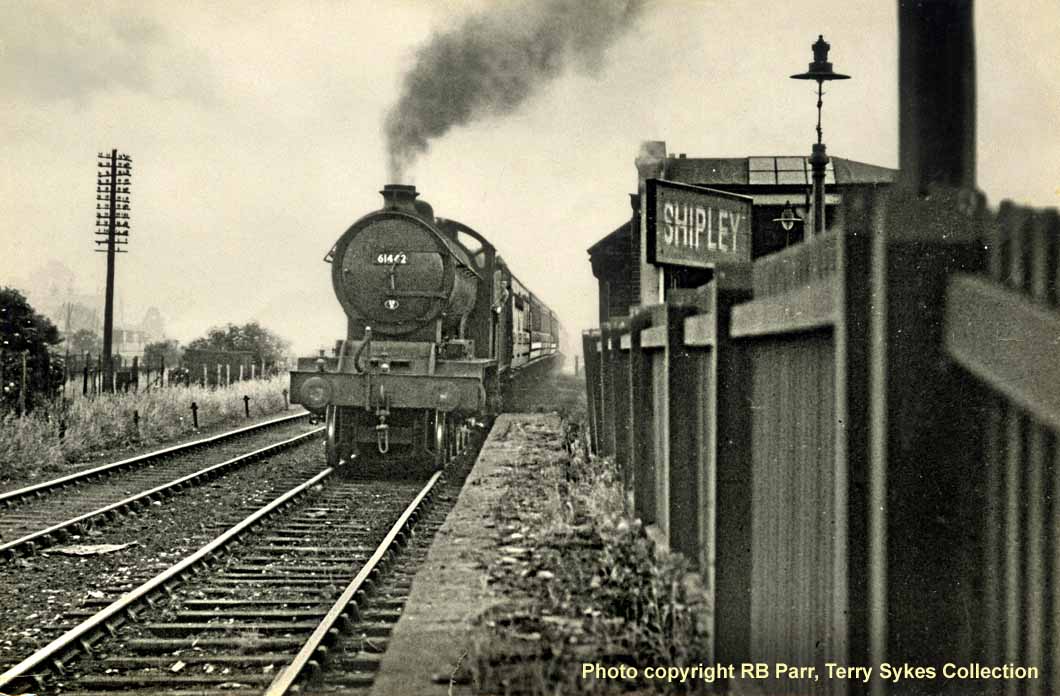
SALTAIRE STATION
Just one mile north of Shipley is the picturesque 19th Century village of Saltaire. Sir Titus Salt chose this spot to build his huge woollen mill and model village in 1851. The mill was the second largest in the world replacing five of his smaller mills in Bradford. It was constructed beside the River Aire and Leeds-Liverpool Canal, which supplied his famous mill complex with as much water as required, and provided an efficient canal and railway transport system on his doorstep. The railway was built in 1851 and the station opened in 1856.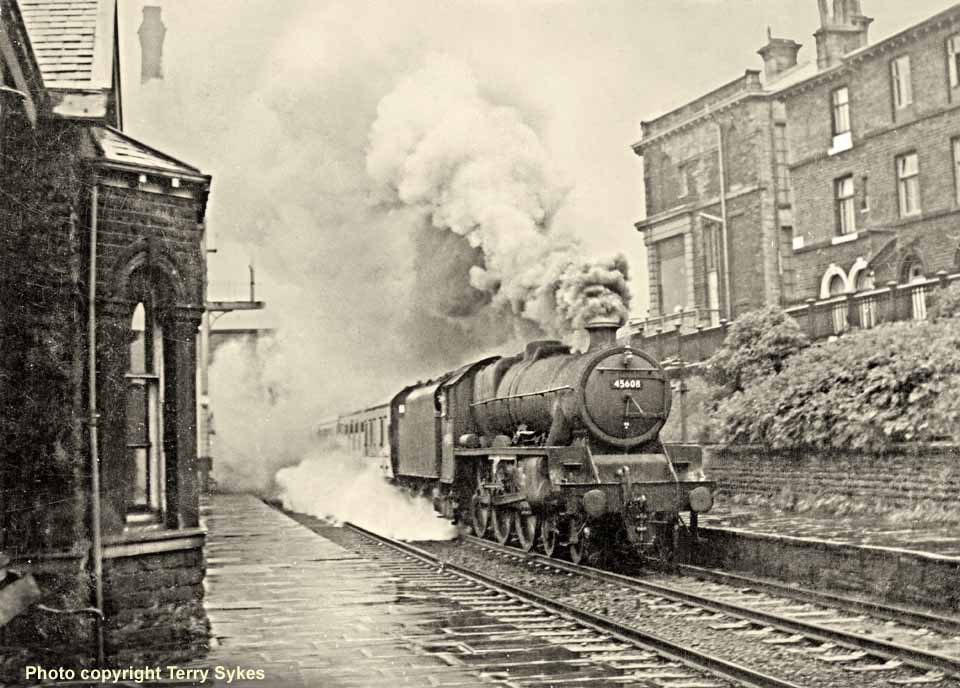
(Above) Stanier 'Jubilee' No 45608 Gibraltar creates a volcanic atmosphere as it runs into Saltaire station on a very wet autumnal day in 1963. The driver is shutting off steam on the approach to the station which has caused the safety valves to lift, and the sudden lack of draught through the fire has resulted in the very efficient smoke screen. It's possible that the fireman may have recently banked up the fire and this hasn't yet burned through sufficiently to prevent the resulting turmoil of black smoke belching from the chimney. The fireman can be seen looking out of the cab window at the steam escaping below him from the overflow of the feedwater injector pump, which shows that he is struggling to get the injector to strike. When the injector is working correctly it emits a low pitched whistling sound, and there should be nothing coming out of the overflow. The fireman is adjusting the water valve, or steam valve, or both, in order to get the balance right and on line. Pumping a little cold water into the boiler will cool the water enough to shut the safety valves! Early steam engines had water pumps that were driven by the engine's driving motion, but this meant that the boiler water could only be added when the engine was moving! Then along came Frenchman Henri Giffard in 1852! How the Victorians loved their science! Henri had built a steam-powered airship and he needed the lightest pump imaginable to keep the weight of the airship down. He came up with a horizontal cylinder design where steam was admitted through a nozzle at one end into a narrowing, and then widening chamber called a 'Venturi'. Cold water was admitted at a 90 degree angle at the point where a venturi creates a negative pressure, and it mixed with the jet of steam causing it to condense instantly! The rapid contraction of the steam releases tremendous latent energy which greatly increases the velocity of the jet of water. The water then enters an enlarged chamber creating a hydraulic affect which raised the pressure well above that of the boiler. This allowed it to overcome a large check valve and enter the boiler. A lightweight pump with no moving parts! Brilliant! And Henri Giffard entered the history books as the first man ever to fly a controllable machine!
(Below) Later that same year Type 4 'Peak' class D26 accelerates the 10.25 Leeds-Glasgow (1S49) through Saltaire station. The vegetation has all fallen back, and there are a few white patches of snow evident in the background. The small wooden hut is the only building on the northbound platform and may have been a temporary replacement for the original stone-built waiting room that used to stand opposite the station buildings on the up platform. The picture of the Peak was taken from the steps of the footbridge, as also was the following picture of the Crab. 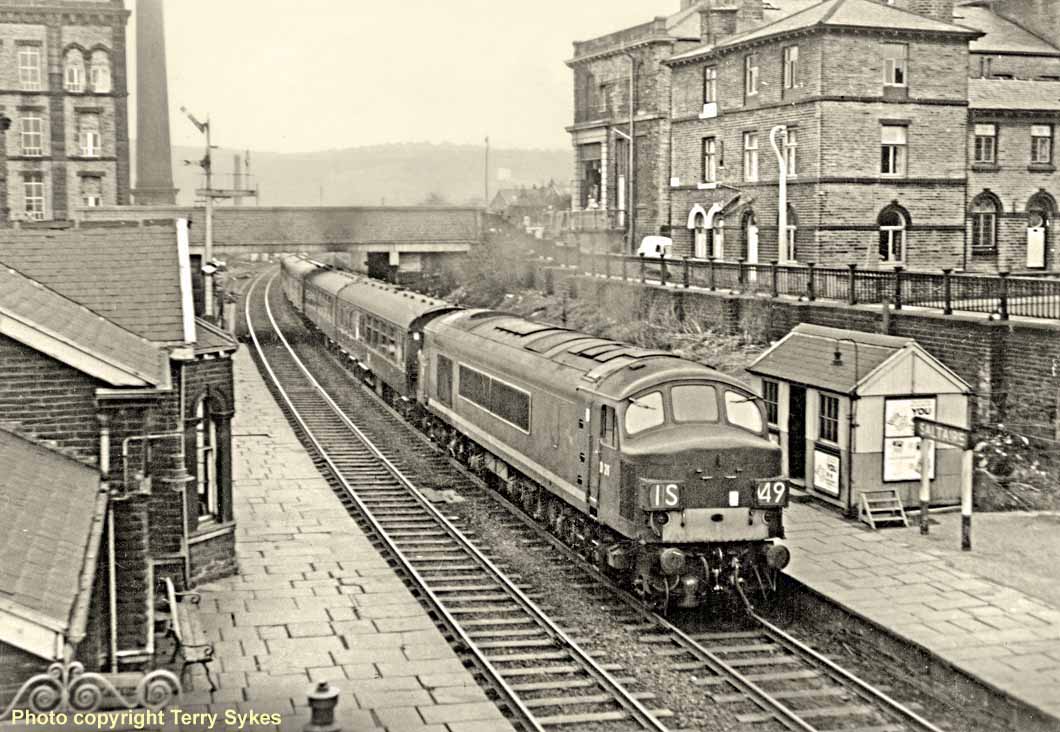

(Above) A clever bit of cropping has turned this poorly framed picture of Hughes Crab 2-6-0 No 42787 running light engine through Saltaire station into a much more interesting composition! And the fact that I managed to cut off part of the buffers is no longer an issue! The focus now is on the two figures and the buildings behind. But all is not what it seems…at first glance they appear to be father and son, but close inspection reveals that one figure is standing on the top of the wall and the other on the pavement behind it. Of interest are the small two-storey houses built by Sir Titus Salt for his general mill workers, whereas flanking them are the more spacious three-storey buildings constructed for his foremen and supervisors. So even outside of working hours Sir Titus expected his supervisors to keep a watchful eye on his 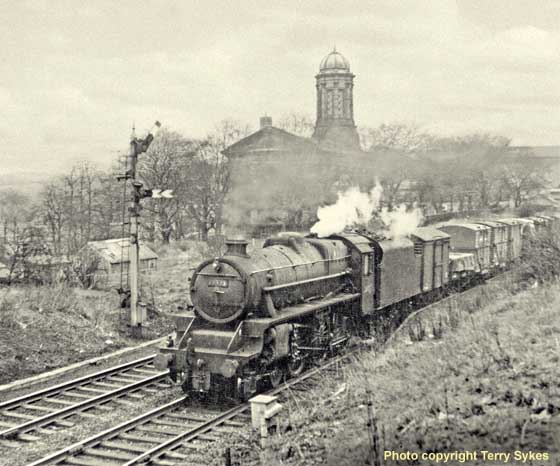 workforce! Nevertheless he took very good care of his mill workers thereby ensuring he maintained a happy workforce and a profitable business at the same time, however drunkeness and absenteeism was a real problem in his Bradford mills so there were no public houses in the village and everyone was expected to attend church; the average life expectancy of workers in the Bradford woollen mills was less than twenty years of age and many children died young.
workforce! Nevertheless he took very good care of his mill workers thereby ensuring he maintained a happy workforce and a profitable business at the same time, however drunkeness and absenteeism was a real problem in his Bradford mills so there were no public houses in the village and everyone was expected to attend church; the average life expectancy of workers in the Bradford woollen mills was less than twenty years of age and many children died young.
(Inset) 'Black Five' No 44923 runs north through Saltaire station with an express meat or fish working on a drab autumn day in 1963. Saltaire congregational church towers in the background with the grey daunting mill buildings on the right.
(Above-Below) Also taken from the footbridge at Saltaire, but looking in the opposite direction, 'Jubilee' class 4-6-0 No 45592 Indore heads south with a long rake of empties. The lamp code states cattle or through freight…not a cow in sight! If I was only allowed to look at one type of locomotive ever again then the Stanier 'Jubilees' would figure high on my list. These rugged, handsome and stylish workhorses were not only strong and surefooted starters; they possessed a wonderful turn of speed. (Below) It's that train again! The renowned 3.40pm Bradford-Carlisle all stations 'stopper' turned up some top-drawer engines on a daily basis in the mid-Sixties. This study of 'Britannia' Pacific No 70035 Rudyard Kipling awaiting departure at Saltaire is a prime example of what could be expected. With two large cylinders, six foot two inch driving wheels - plus a huge boiler producing an endless amount of steam…these locomotives exude muscle! What else could you want?

HAPPY DAYS AT HIRST WOOD
During the summer of 1961 I acquired a Brownie 127, but it was difficult to capture a presentable image of a moving train. I'd often spend a couple of hours on the 'rec' at Hirst Wood checking out the various trains that presented themselves during the express-rich period between two and four o'clock in the afternoon. This included both the north and southbound 'Waverly' and 'Thames Clyde Express' interspersed by numerous freights and stopping trains.
(Below) The Hughes 'Crabs'! What great locomotives these were! With their free-steaming boilers, large cylinders and modern long travel valves, if ever an engine looked ready for business then the workmanlike Hughes Horwich 'Crab' 2-6-0s of 1926 did! The running plate is swept up over the cylinders at the front giving maximum access to the motion, which, in 1926 was way ahead of its time! It's a very relevant point that Stanier and later Riddles made little or no attempt to replace these ancient-looking locomotives; in fact many depots in Scotland preferred them to the 'Black Five' 4-6-0s for heavy unfitted freight workings over difficult terrains. They were generally regarded as being surer-footed and better braked, and if the operating department was looking for a locomotive to chortle happily along to the coast with holiday excursions of indiscriminate length then look no further! Here, No 42928 of Lancaster Green Ayre shed (24J) blasts away from Saltaire station with a Morecambe-bound stopping train in the autumn of 1961; the 'Crabs' were classified as 6P5F and many survived well into the mid-Sixties and beyond. 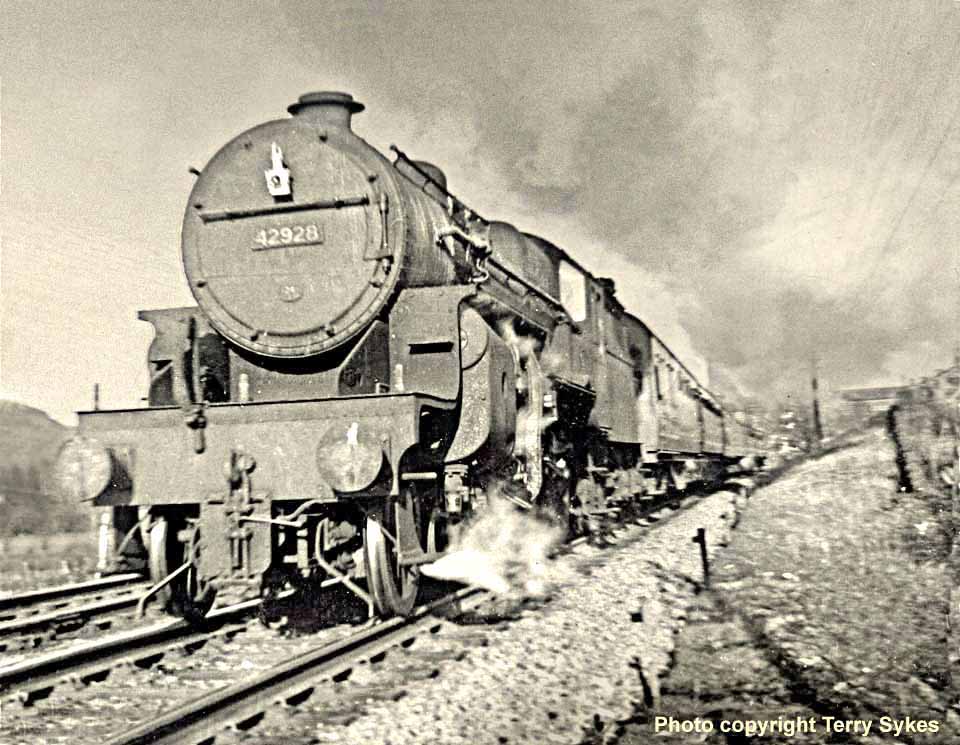
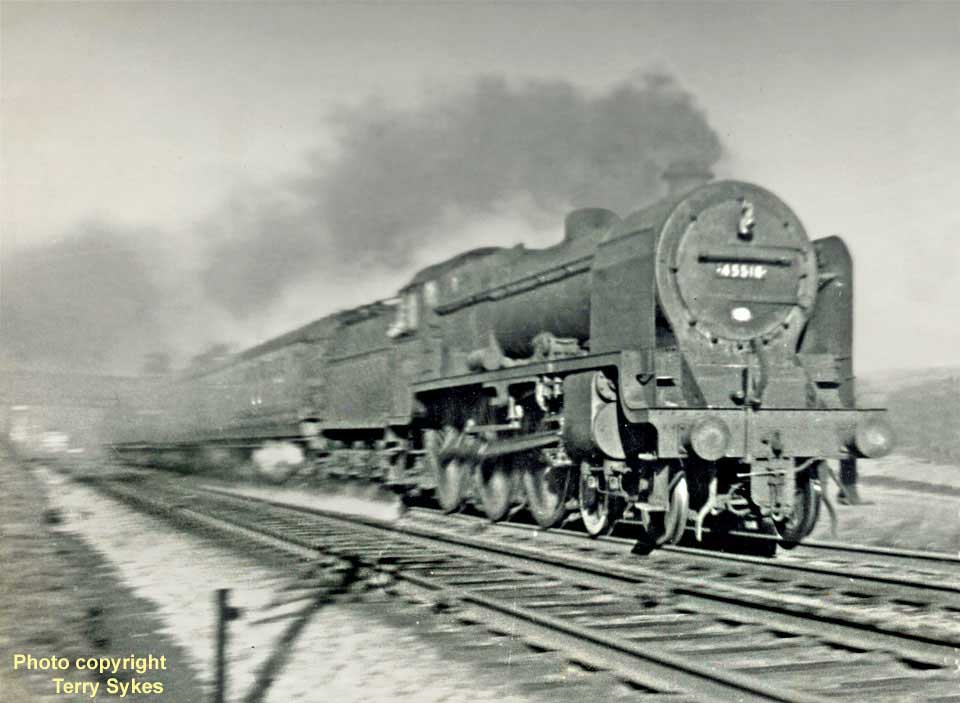
(Above) Sadly, while the paralleled-boilered 'Patriots' are my favourite locomotive class, not a single one survived the cutters torch, and this Brownie 127 image of No 45518 Bradshaw speeding past the 'rec' with a Leeds-bound stopping train is the only photograph I managed to take of these charismatic and iconic engines. Perhaps the illusion of great speed was created by the camera's chronically slow 1/25sec shutter speed or else the driver has some serious braking to do if the train is booked to stop at Saltaire!  (Inset) A 'Patriot' class nameplate 'Bradshaw', measuring 34½" long - went under the hammer for £9,000 at a Great Central Railwayana Action on 16th January 2010. Built at Crewe in 1933 (as LMS No 6006) the loco was renumbered 5518 the following year. It was named 'Bradshaw' in May 1939 to mark the centenary of the Bradshaw railway timetable publications. For the record, George Bradshaw was an English cartographer, printer and publisher, best known for developing the world's first compilation of a railway timetable very soon after the introduction of railways in Britain; the first edition was published on 19th October 1839, costing sixpence - 2½p in today's money - a cloth-bound book entitled 'Bradshaw's Railway Time Tables and Assistant to Railway Travelling'. This rather long-winded title was changed to 'Bradshaw's Railway Companion' in 1840, however the following year a new volume was issued monthly under the title 'Bradshaw's Monthly Railway Guide'. An amusing snippet can be found on Wikipedia's page about the verb 'to Bradshaw' being a derogatory term referring to the RAF pilots whose perceived lack of ability to navigate was betrayed by the pilots who plotted a course by following railway lines! In BR days the 'Patriot' class loco was numbered 45518 and allocated to Carlisle Upperby, Preston, Edge Hill, Warrington, Aston, returning to Edge Hill again and finally Lancaster (Green Ayre) from where it was withdrawn in October 1962. After four months in store at Green Ayre, it was cut up at Horwich Works in February 1963.
(Inset) A 'Patriot' class nameplate 'Bradshaw', measuring 34½" long - went under the hammer for £9,000 at a Great Central Railwayana Action on 16th January 2010. Built at Crewe in 1933 (as LMS No 6006) the loco was renumbered 5518 the following year. It was named 'Bradshaw' in May 1939 to mark the centenary of the Bradshaw railway timetable publications. For the record, George Bradshaw was an English cartographer, printer and publisher, best known for developing the world's first compilation of a railway timetable very soon after the introduction of railways in Britain; the first edition was published on 19th October 1839, costing sixpence - 2½p in today's money - a cloth-bound book entitled 'Bradshaw's Railway Time Tables and Assistant to Railway Travelling'. This rather long-winded title was changed to 'Bradshaw's Railway Companion' in 1840, however the following year a new volume was issued monthly under the title 'Bradshaw's Monthly Railway Guide'. An amusing snippet can be found on Wikipedia's page about the verb 'to Bradshaw' being a derogatory term referring to the RAF pilots whose perceived lack of ability to navigate was betrayed by the pilots who plotted a course by following railway lines! In BR days the 'Patriot' class loco was numbered 45518 and allocated to Carlisle Upperby, Preston, Edge Hill, Warrington, Aston, returning to Edge Hill again and finally Lancaster (Green Ayre) from where it was withdrawn in October 1962. After four months in store at Green Ayre, it was cut up at Horwich Works in February 1963. 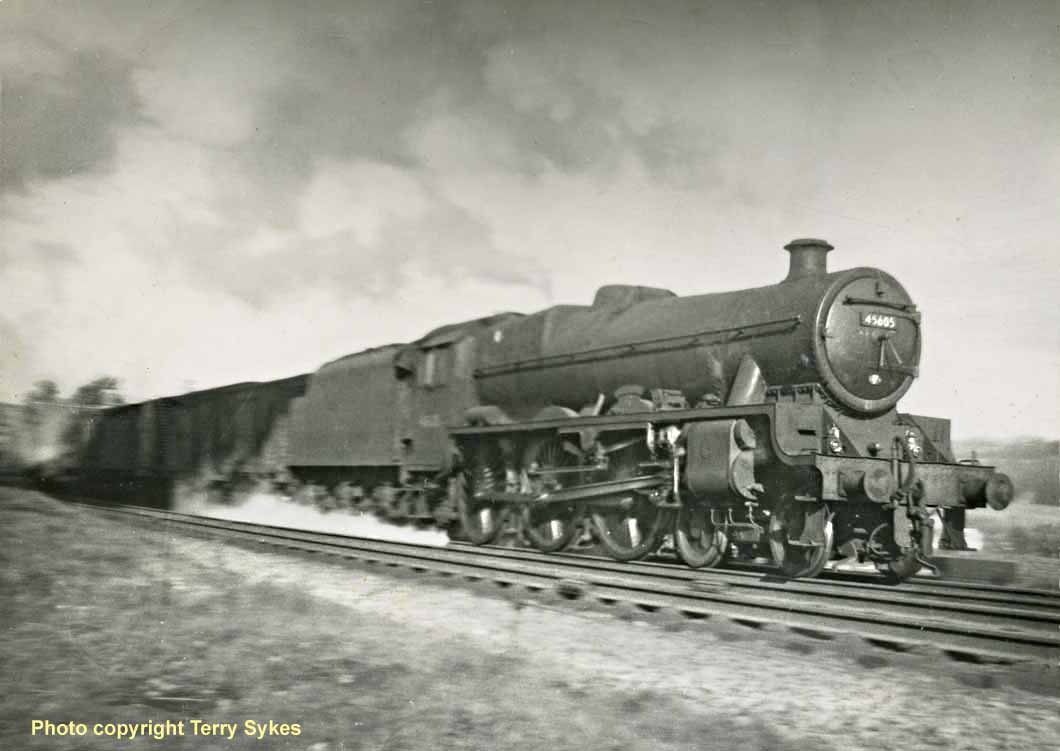
(Above-Below) 'Jubilee' class No 45605 Ceylon hurries a Leeds bound express goods train towards Saltaire in the spring of 1962. (Below) What a difference fourteen months make! Same place only this time I'm using my stepdad's Kodak folding camera to take a shot of a clean and tidy 'Jubilee' class 4-6-0 No 45739 Ulster heading an up express freight in the late summer of 1963. It's only when I look closer at this photograph that I'm reminded there used to be a house alongside the track beside Hirst Lane road bridge…was it a railway cottage? Several years later it was gone.
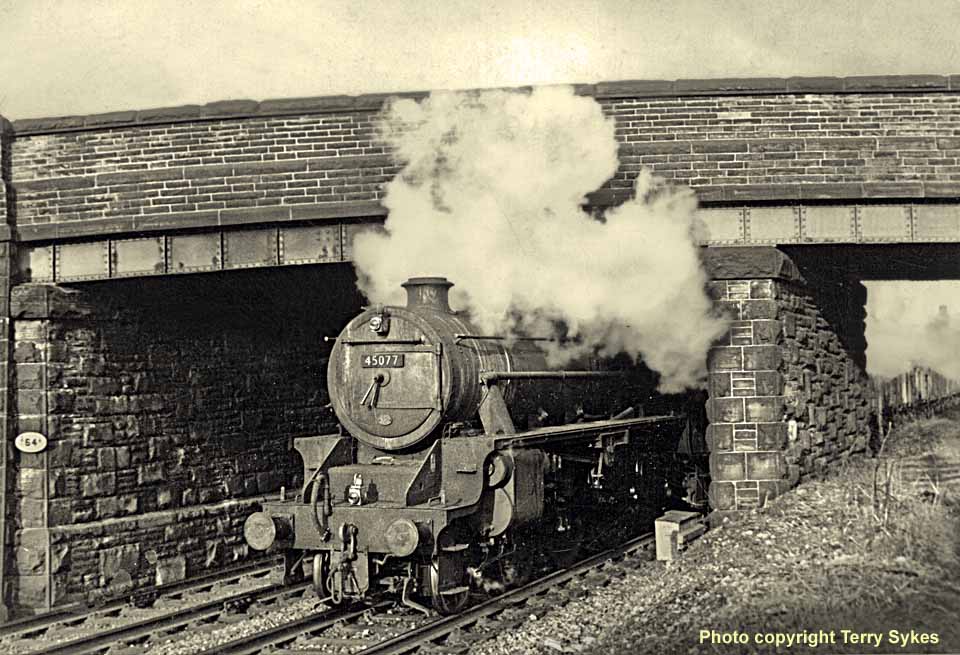
(Above-Below) Hirst Lane road bridge seems hardly big enough to accommodate 'Black Five' No 45077 as it appears to squeeze through with a northbound freight working. The large empty space under the right side of the bridge was a great place to avoid inclement weather, and one of the short chimneys from Salts Mill is just visible in the background. (Below) Approaching the bridge from the other side just a few minutes later, another Black Five No 44853 leaves Hirst Wood and the signal box behind, as it runs out of the evening sun towards Saltaire with a short stopping train. 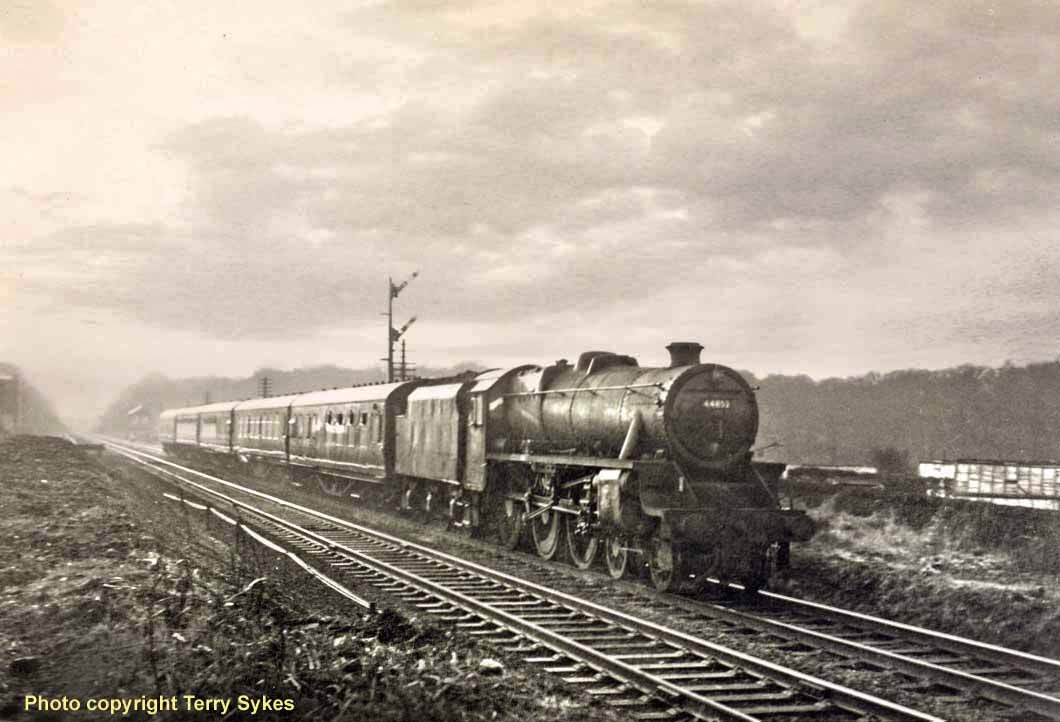

(Above) Two to three hundred yards north towards Bingley was Hirst Wood signal box - and what about this for a happy coincidence! As mentioned earlier, one of my spotting mates, Keith Burnham and I lived next door to one another in a terrace of tall houses on Bingley Road and spent many hours spotting trains at Hirst Wood. The Burnham's began letting out rooms and their first tenant was a friendly young bloke in his thirties called Dave, who worked on the railways as a signalman! As luck would have it, he had just been transferred to Saltaire to work Hirst wood signal box! Here Ivatt class 4MT 2-6-0 No 43014 storms past Hirst Wood box with a northbound freight on a bright sunny September day in 1963. These were very fine locomotives, albeit ugly-looking - hence their uncharitable 'Mucky Ducks' and 'Flying Pig' monikers - but appearances were the last thing on Ivatt's mind...he chose to follow the American practice of making all the major working parts of the engine easily accessible, plus he incorporated many of the latest labour-saving devices into them. Unfortunately when they were tried out on the 'Somerset and Dorset Line' with its steep and continuous gradients, all was not well! The boiler's steam production capacity was found to be sadly  lacking! Tests were carried out and the double chimneys were replaced with single ones which increased the drafting through the fire when the engine was being worked hard, the problem was cured! Following these modifications the engines became well liked and enjoyed a favourable reputations; In fact many of the features incorporated into these locomotives were carried forward into several of the BR Standard locomotive designs.
lacking! Tests were carried out and the double chimneys were replaced with single ones which increased the drafting through the fire when the engine was being worked hard, the problem was cured! Following these modifications the engines became well liked and enjoyed a favourable reputations; In fact many of the features incorporated into these locomotives were carried forward into several of the BR Standard locomotive designs.
(Inset) I was invited into the box by Dave the signalman on a couple of occasions, but the Brownie 127 pictures taken on my first visit were of poor quality. However, a second visit produced this shot of 'Royal Scot' Class 7P No 46115 Scots Guardsman approaching the box at speed, which is good enough to show. This was taken with my Kodak folding camera, for the Brownie 127 was now a thing of the past! The train is heading south and may have been a relief extra for one of the Scottish expresses, or perhaps Carlisle United were playing Leeds United in the FA Cup! The next time I saw this locomotive was around 1968 when I took a girlfriend up to Haworth for the day, and I was surprised to see it standing in private ownership besides the goods shed in Haworth yard. It had apparently been moved there directly after withdrawal from service in 1965.
(Below) As great as the signalman's view was from inside the box, it was somewhat restricted in the respect of railway photography, and there was no real substitute for being lineside! From down beside the signal box the next picture was a bit of a rarity for me! It shows rebuilt 'Jubilee' class No 45736 'Pheonix' moving slowly past Frank Wigglesworths engineering works with a northbound stopping train; this was the one and only time I ever saw this locomotive. The rebuild took place in 1942 when the locomotive's original 3A boiler was replaced with the larger 2A type, raising the boiler pressure from 225psi to 250psi and increasing the tractive effort by 3000 lbs. Whilst everything else was left the same, the extra 2.5 ton weight of the larger boiler was supported on the driving wheels, and this extra adhesion weight along with the 10% increase in power was sufficient for the rebuilds to be reclassified as 7P locomotives. There were plans afoot to rebuild the whole class of jubilee locomotives, but it was decided that the 'Royal Scots' were in more desperate need of the upgrade than they were, so it was shelved indefinitely. The only other 'Jubilee' to receive the larger boiler was 45735 Comet. Looking at this picture I was puzzled to see that the coaches appear to be adorned with 'go faster' stripes! Very similar in fact to the 'Coronation Scot' coaches of yesteryear! All I can think of is that the sun is coming over the top of the train and the rails on the 'up' line are being reflected onto the carriage sides...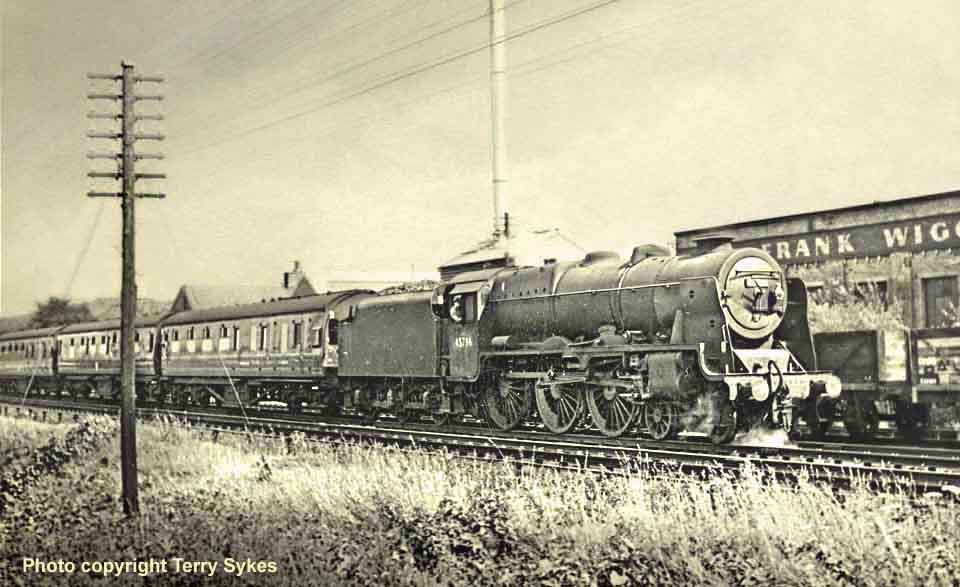
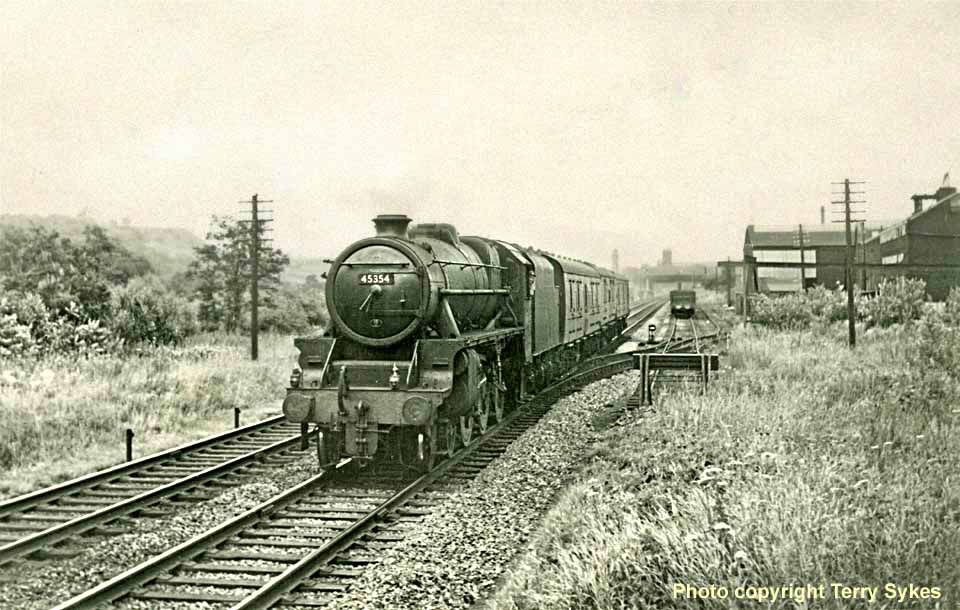
(Above-Below) This picture shows the layout of what I came to regard as my own private full-sized model railway! Black 5 No 45354 runs north past Wigglesworth's sidings with a short parcels train. The location of the signal box (hidden behind the locomotive) gave the signalman visual communication with the various goods movements at this once-busy sidings. In the distance can be seen the dome of the Congregational Church and the various mill buildings at Saltaire, while Hirst Lane road bridge is nearer the camera with the local 'rec' just beyond it. The hills on the left lead up to the edge of Baildon Moor. Hirst Wood is at its narrowest point no more than a few hundred yards wide where the railway passes through. The picture was taken from a wooden foot crossing on the edge of a housing estate. (Below) Derby 4 No 43999 trundles an up freight past the rec at Saltaire during the autumn of 1964. Almost six hundred of these versatile locomotives were built between 1924 and 1941; they were cheap to maintain and could do almost anything; a huge amount of LMS freight was handled by these simple and unassuming locomotives. 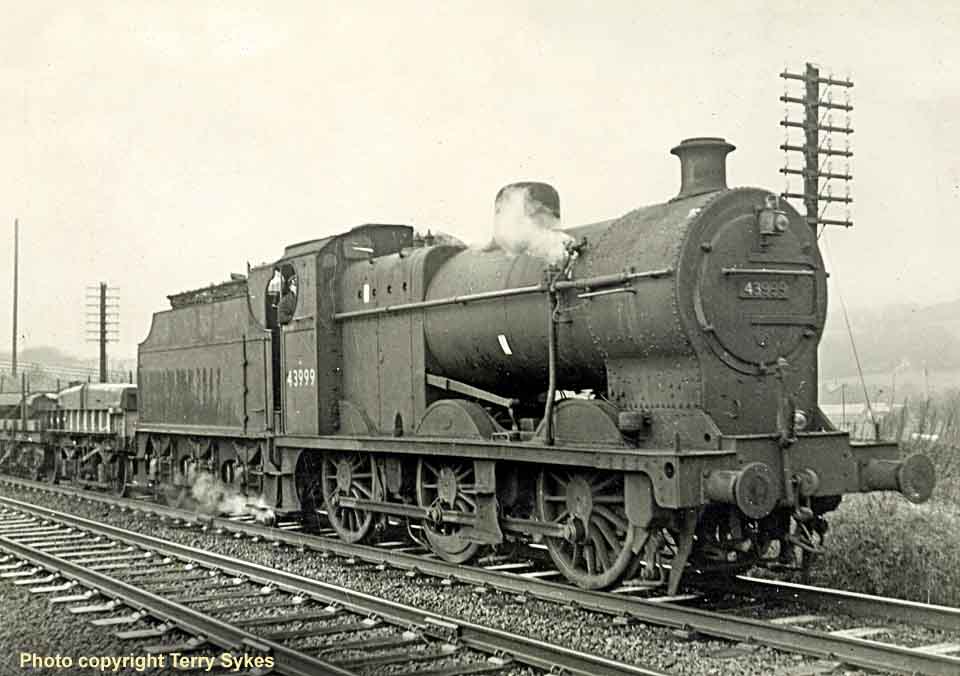

(Above-Below) The low evening sun illuminates the side of 'Black Five' No 45303 accelerating away from Hirst Woods with a Morcambe to Leeds express in June 1964. (Below) I thought I'd chance a few shots deeper in Hirst Wood and see what turned up, but I wasn't expecting this! 'Britannia' Pacific 70025 Western Star is well into its stride with a northbound express just two miles from the 15mph speed restriction it encountered on Shipley bend. The loco is sporting a Crewe North shed plate and I have no idea what the train is or where it's going! I was never any good at that kind of stuff, but on the technical side, the hand rails on the smoke deflectors were removed on the Western Region Brits' after they were deemed partially responsible for obscuring the drivers view of signals, which led to the 'Milton' rail crash in 1955. Grab holes were cut into the smoke deflectors - and, typical of Swindon, they were beautifully embellished with bronze surrounds.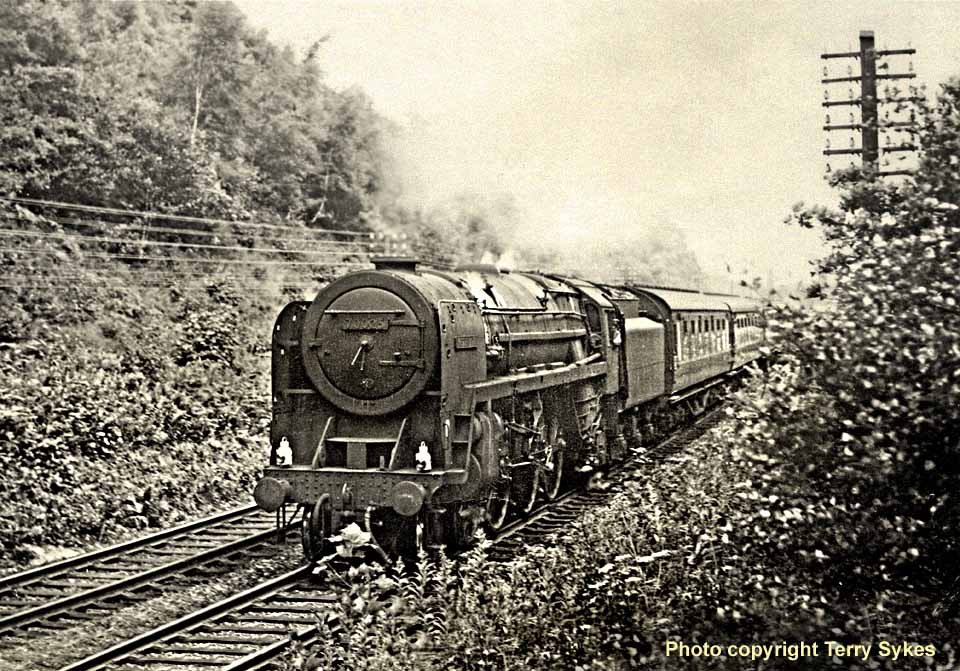

(Above-Below) I was just about to leave when the signal behind me sprung back into life. A Fairburn 2-6-4T running bunker first was not what I expected, so I grabbed an impromptu shot of 42138 running light engine towards Bingley...and I'm glad I did! It's turned out to one of my favourite photographs. The locomotive is leaving the woods behind and crossing the bridge over the River Aire. From here the railway winds north up the Aire valley and much of it is raised up on an embankment; my old school is 500 yards around the corner on the left and Bingley station is less than a mile away. (Below) My final photograph on this section of line shows 'Black Five' No 44758 approaching the wide flat valley bottom on the left where my old school (now 'Beckfoot Grammar') stands. The train has just crossed the River Aire in an area we called Bingley 'Old Hills' but I haven't been able to find out why! The engine is heading north with an express freight and doing what many people think these engines did best - everything! The only thing these engines lacked were names! Unfortunately having no wheel splashers to mount a nameplate, the handful of Black Fives that where named looked a bit odd! As did the V2s! No amount of fancy painting on the flat mounting plate seemed to work. Also finding over 800 names for one class of locomotive would have been challenging to say the least. It must be said, however, that the handful of preserved 'Black Fives' that carry names look great! The owners seem to have adopted a much lower profile for the nameplates and aesthetically it works very well.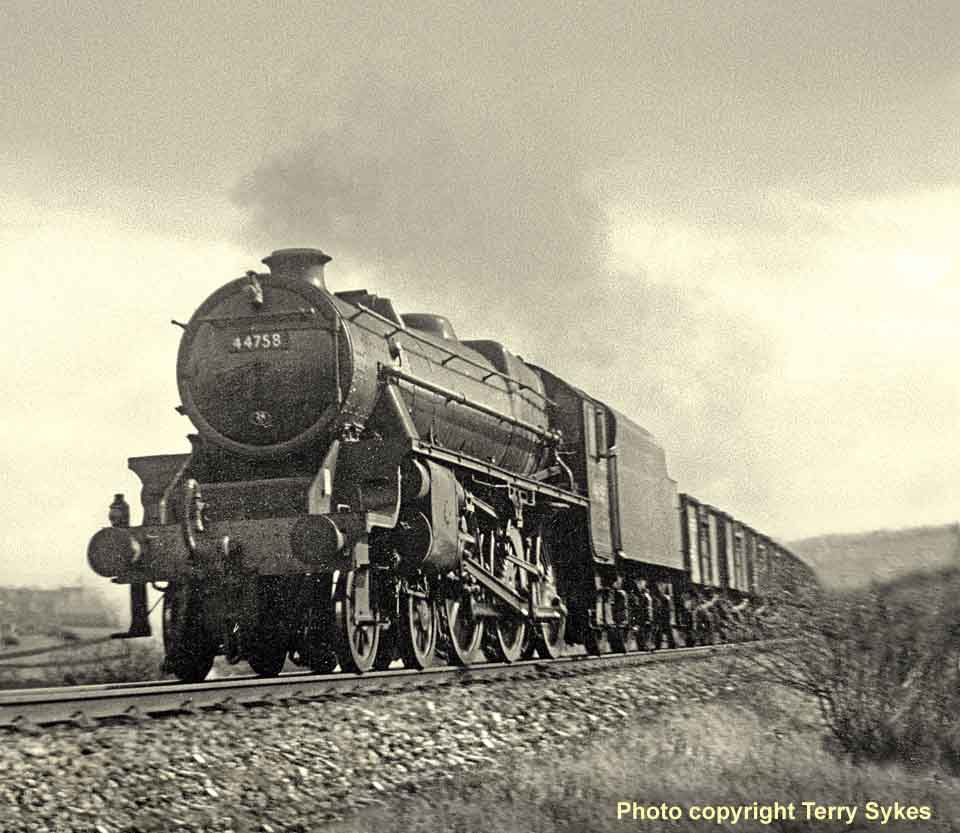
WORTH VALLEY SPECIAL
As mentioned earlier, I did a morning paper round for a newsagent called Mr Lindley, a really nice guy who had previously managed to get me a ticket for the Duchess-hauled 'Border' railtour in 1961. The following year my brother and I had been invited to join him once again, only this time he had tickets for the 'Worth Valley Special' organised by the then embryonic Keighley and Worth Valley Preservation Society; the charter was hauled throughout from Bradford Forster Square to Oxenhope and back by Manningham Shed's Midland 3F 0-6-0 No 43586 on 23rd June 1962…it was an interesting day to say the least - the carriages were packed full! Every time the train stopped for a photo shoot, everyone clambered off like a colony of swarming ants.
Many years later I was given a collection of random railway pictures and negatives which had been donated to the Vintage Carriages Trust at Haworth, and I was surprised to discover amongst them a set of negatives depicting this very same event. The first one I printed was the train preparing to set off from Bradford Foster square station. This is a great picture! Just look at the way the station fits inside the fabric of the city with the road bridge framing the platforms. But hang on a minute! That's my brother standing on the left looking sideways, and the feet poking in from the edge are probably mine! Also the very youthful-looking newsagent, Mr Lindley, always wore a black suit and tie…isn't he the guy nearest the coach? 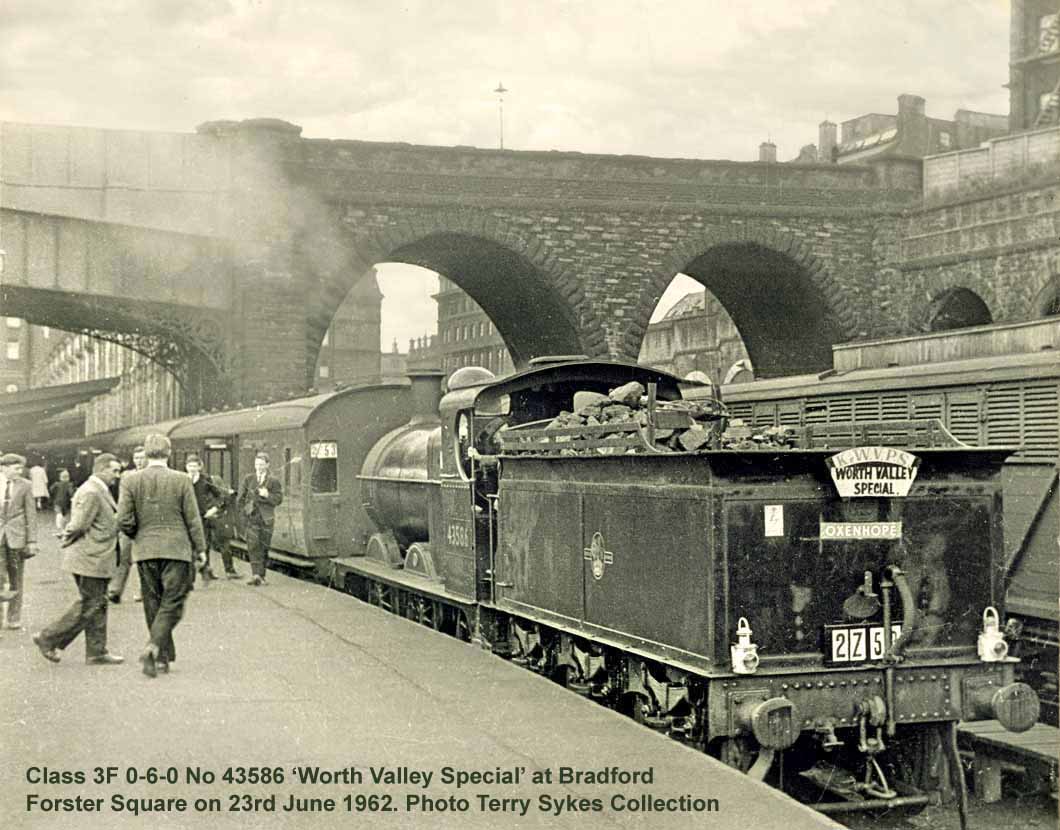

(Above-Below) Whoever the unknown photographer is, we should take our hats off to him (or her) for these shots at Oakworth, Haworth and Oxenhpe stations (above and below) were taken at a time when most photographers concentrated solely on the locomotive, rather than capturing the whole event as seen here. My brother and I are somewhere among the hundreds of enthusiasts scrambling over every inch of every station, but I haven't found another sighting of us. However I've included four pictures in the hope that someone might recognise themselves from some fifty-odd years ago... 
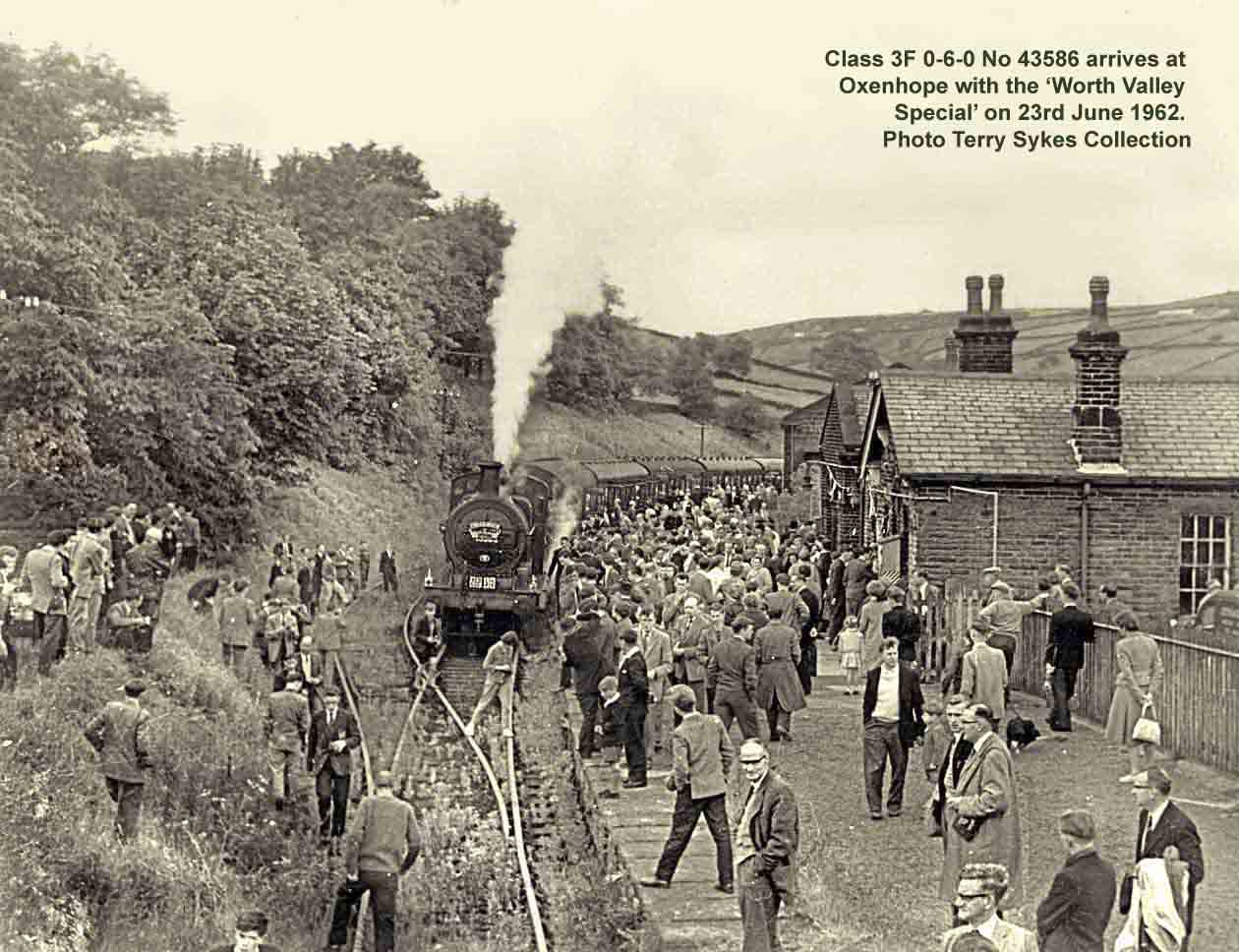
TIME OUT
Schooldays were busy times! It's hard for me to emphasize just how important football was to my brother and me. My brother played for Bradford schoolboys and upon leaving school at 15 he became the first apprentice professional footballer ever signed by Bradford City, which incidentally, was among the LNER Class B17/6 4-6-0s named after English football clubs; this surviving nameplate from No 2868 (later British Railways 61668) was photographed by Keith Long at Bradford Industrial Museum - click HERE to visit Keith's 'Cabsaab900' Flickr site.
I began playing for Bradford schoolboys the season after, and a successful cup run saw us playing the champions Stoke at Bradford City's ground in the quarter final of the English trophy. Sadly we lost, and I only found out later that a Sheffield Wednesday scout had been refused permission to talk to me, so a motor mechanic I became! But football still remained my No 1 aim in life and my fifth year at school was hectic! What with working 5½ days a week and dashing off to play for a Huddersfield Town junior team every Saturday afternoon, my weekends were frantic.
(Inset) This photo was taken by Tom Curtis, whose excellent 'Tom Curtis Rail Gallery' website HERE is  dedicated to all things Railway from the early Sixties right through to the Present Day. Tom writes - 'A 'Huddersfield Town' nameplate originally graced an LNER Class B17/6 4-6-0 No 2853 which became 61653 in BR days; the loco was scrapped in January 1960. GBRF have done a superb job in resurrecting some of these old 'Football Club' names particularly as the plates themselves are cast in brass and are a fair replica of the originals. Unfortunately the half-spherical football below the names themselves had to be modified to just a flat representation almost certainly due to gauging issues!'
dedicated to all things Railway from the early Sixties right through to the Present Day. Tom writes - 'A 'Huddersfield Town' nameplate originally graced an LNER Class B17/6 4-6-0 No 2853 which became 61653 in BR days; the loco was scrapped in January 1960. GBRF have done a superb job in resurrecting some of these old 'Football Club' names particularly as the plates themselves are cast in brass and are a fair replica of the originals. Unfortunately the half-spherical football below the names themselves had to be modified to just a flat representation almost certainly due to gauging issues!'
My pursuit of a footballing career at Huddersfield was hectic; on one particular occasion I played four competitive games in a single weekend! Eventually after knocking on 'Town's' door for over a year it became obvious that it wasn't going to open, and so together with four other Bradford lads we told Huddersfield to stuff it! As far as we were concerned they would have to find some other mugs as cannon fodder to bring through the scouts 'special prodigies'…even to this day I still don't understand it! Some of the Bradford lads were far better than the lads they were babysitting!
Needless to say railways had taken a big backseat during this period, and it was going to take something a little bit special to get me up and running again. Perhaps the appearance of a Merchant Navy Pacific at Leeds might do the trick!
(Below) On 13th June 1964, I headed for Leeds along with countless others to witness the rare sight of 'Merchant Navy' class No 35012 United States Lines at Leeds City station prior to departure of the Railway Correspondence and Travel Society's (RCTS) 'Solway Ranger Railtour', with renowned Nine Elms driver Burt Hooker in charge. It is hard to tell from this digitally-adjusted image, but in the original shot there are tell-tale signs of the biggest inherent pitfall of a hand-wound 620 roll film camera - the dreaded double exposure! It's not often you get away with a presentable image after one of these, but I have on this occasion. Thank goodness for the digital age! Meanwhile the four figures in the photograph create a sense of drama. The fireman is setting the SR-tyle discs to display an express passenger code on the front of the locomotive, while the guy in the foreground looks like he's daring anyone to step closer! There appears to be a member of the public taking pictures out of the drivers window, and the bloke standing down beside the cab looks like he means business! Could this be the driver Bert Hooker? 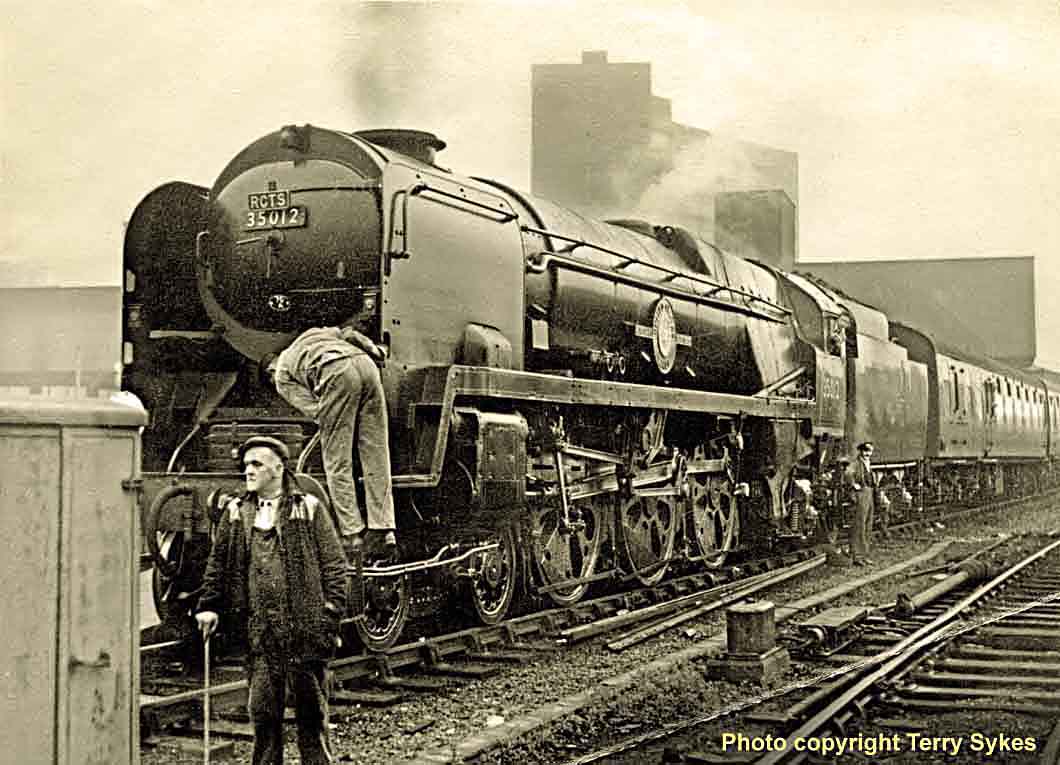
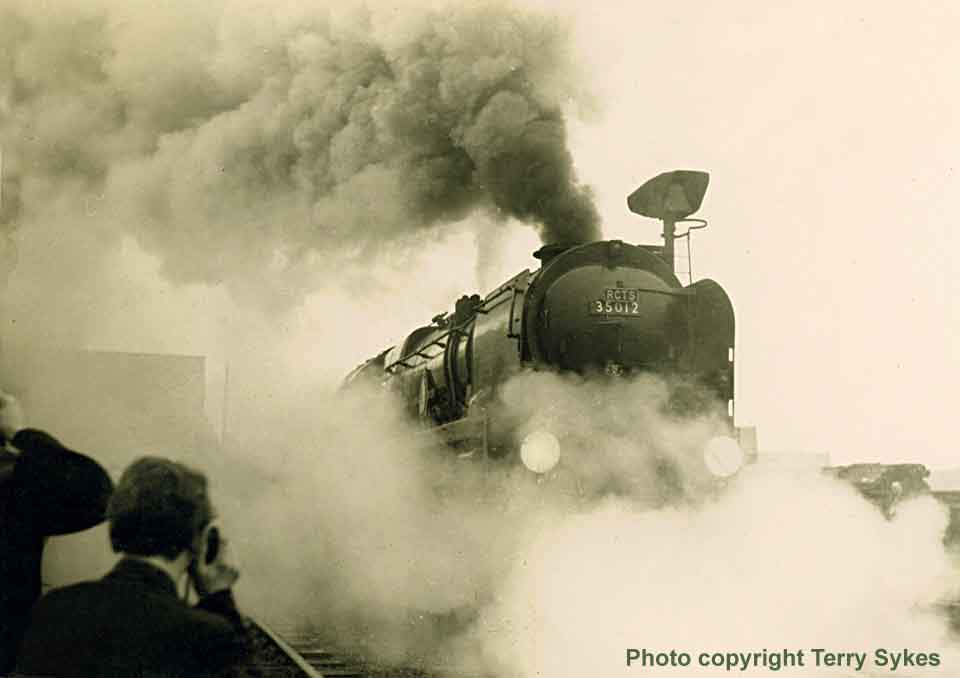
(Above) In the second picture of No 35012 United States Lines, I am guilty of another common mistake when taking a photo of a steam locomotive exiting a station; as the driver opens his cylinder draincocks you may find yourself engulfed in steam! Cheers Burt! Still it is what it is…and at least I was there!
Departing Leeds City at 8.43am, the 'Solway Ranger Railtour' ran via Skipton and Wennington to Carnforth where it joined the WCML for the next leg to Penrith; sadly the assault of Shap was spoiled by a dead stand at Shap Wells followed by further signal checks at the summit itself. At Penrith Ivatt's LMS Moguls Nos 46426 and 46458 hauled the train via Keswick and Derwent Junction to Workington Main, where enthusiast boarded a 6-car Derby-built DMU for a run via Bransty, Moor Row to Rowrah and return, before taking the coastal route via Sellafield, Corkickle, St Bees, Whitehaven Bransty and Workington to Carlisle. Meanwhile, the Ivatt 2-6-0's hauled the coaching stock via Penrith to Carlisle, where GNSR 49 'Gordon Highlander' and CR123 worked the Silloth branch out and back to Carlisle. 35012 then coupled up for the final leg to Leeds via the Settle-Carlisle line, departing Carlisle at 7.25pm and arriving at Leeds City at five past ten…
(Below) It would have been a huge wasted opportunity if I'd gone to Leeds and not had a quick look inside Holbeck shed to see what had changed since my last visit 18 months earlier. So what was going on? Not much actually! But with the the aperture wide open, and the shutter at 1/25th of a second I managed to record this presentable image of 'Willesden' 'Britannia' Pacific No 70020 Mercury standing inside the shed's dark interior. It's surprising what you discover for the first time when looking at old photographs! The hinges on the smokebox doors must have had problems with wear allowing the doors to droop and not seal properly when tightened in the wrong position. Both this locomotive and the Black 5 beside it have got a support bracket on the left side of the smokebox door to keep them in the correct position! Also the left hand buffer beam section seems to have had a knock and is bent down slightly. 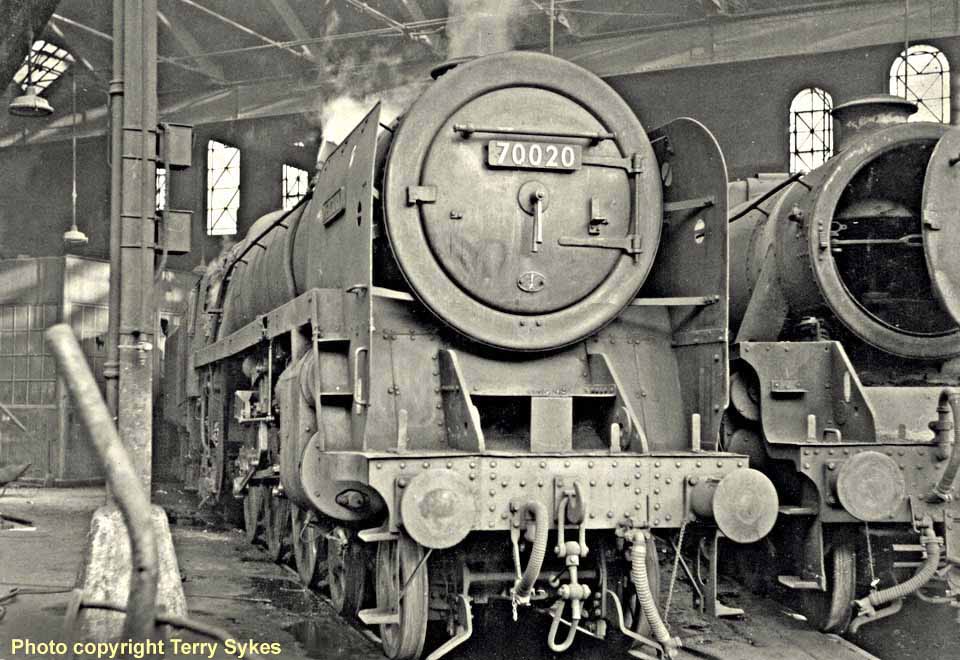

(Above) Outside I found 'Jubilee' class No 45602 British Honduras looking completely abandoned! She's seen here parked up on one of the grubbiest farthest away siding in the yard with only a pair snow ploughs for company. Its only when you look a bit closer you notice that the safety valves are gently lifting and she has a full head of steam! Also the coal is bunkered right up to maximum capacity, ready for the off.
(Below) Blackpool was a place you wouldn't really think of going to in the pursuit of rare locomotives, but looking at the following photographs it appears we did just that in the late summer of 1964. I believe we accompanied our parents on a day trip excursion with the proviso that they went their way and we went ours! I do vaguely recall the train being pulled by a Hughes Crab, and staring at a stone wall for ages as we stood outside Bradford Low Moor station. There was still a healthy presence of steam in evidence at Blackpool North shed 24E, and waiting beside the coaling plant is Wakefield 'Jubilee' No 45739 Ulster being prepared for the return leg of a holiday excursion. Behind the locomotive a 2-6-4T is on the turntable. 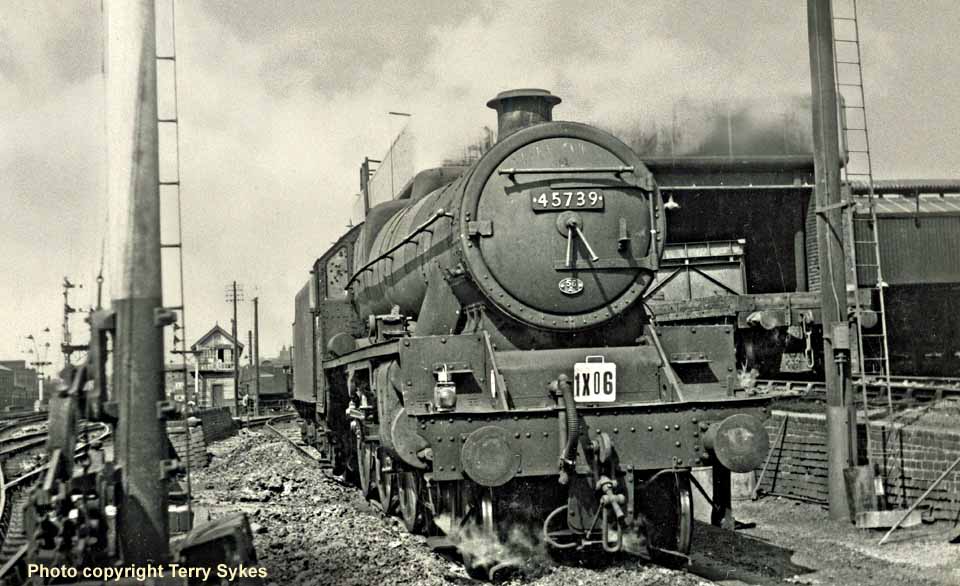
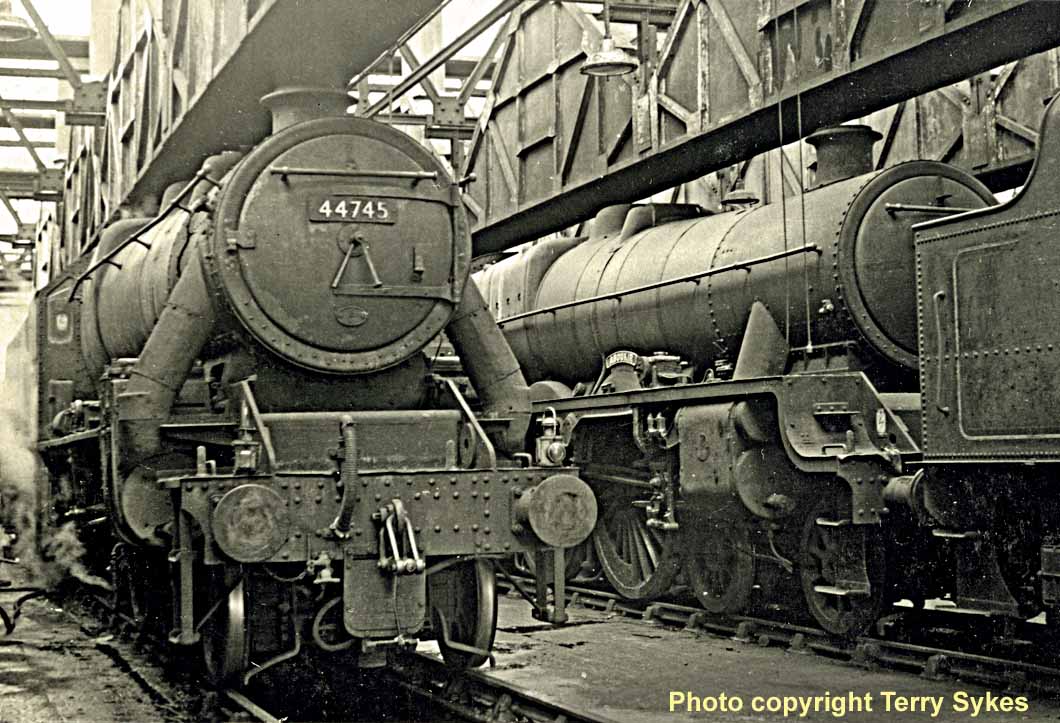
(Above-Below)) Inside the shed Blackpool North's own 'Jubilee' class No 45681 Aboukir looks bereft of life and was withdrawn not too long after in October. Rubbing shoulders with the 'Jubilee' is a Caprotti valve geared Black 5 No 44745 carrying express code lamps; it moved out of the shed while we were still there. (Below) The shed closed in November 1964 but you'd never have thought it looking at the line up of Stanier locomotives ready for business outside just three months earlier! From left to right, Stanier 2-6-4T No 42657 is also carrying express code lamps, whilst Black 5s Nos 45377, 45048, and 44731 await their next turn of duties.
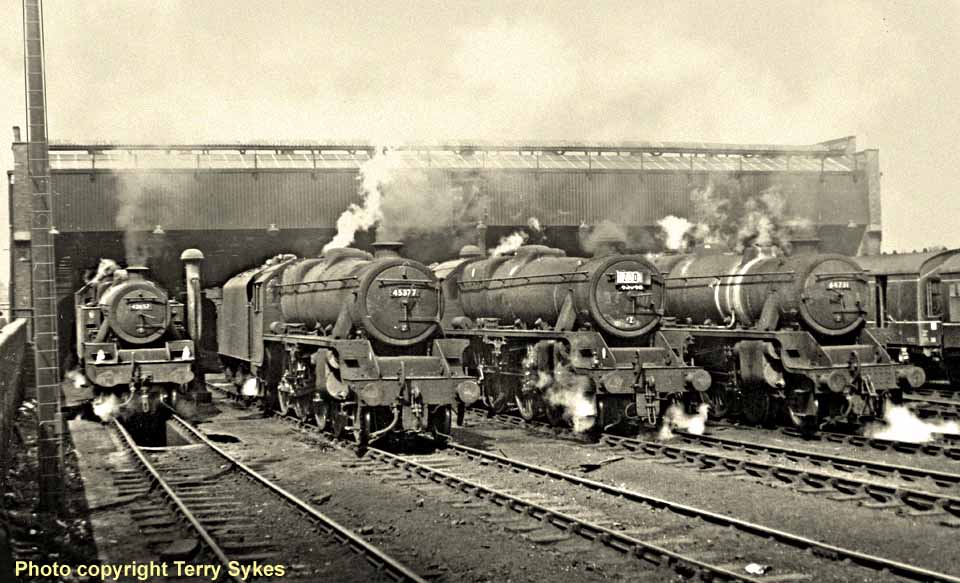
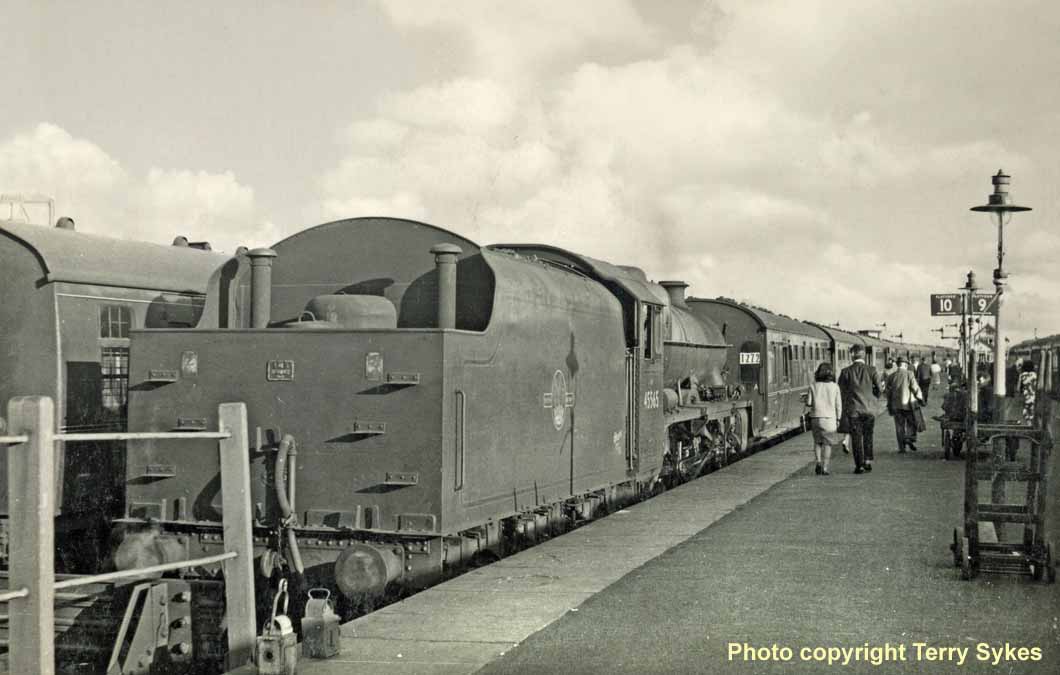
(Above) Finally venturing back into the station to catch our train home we found that it had been drawn into the station by a very clean 'Jubilee' No 45565 Victoria.
IN THE SUMMER OF 1964
In the summer of 1964 I was employed as an apprentice motor mechanic in Bingley West Yorkshire, and as I now had cash of my own in my pocket the cost of film and processing were no longer a major issue with railway photography. As mentioned earlier my stepdad had given me a Kodak 'Tourist' 620 medium-format folding camera which had a f4.5 lens and 1/200sec maximum shutter speed, and delivered generous-sized 6cm by 9cm negatives (roughly 2½" X 3½"). It wasn't long before I was getting on really well with figuring out its 'f' stops and shutter speed combinationss, and so it was time to visit York again.
(Below) On arrival at York station the first opportunity to present itself was this Class 9F 92011 passing light engine on the 'up' through line to pick up its train from the yard at Dringhouses. A nice even light turned out to be perfect to capture a decent shot of this impressive machine. Many railwaymen considered the 9Fs to be the most successful of the BR Standard locomotives, and after the experience I had in 1962 it's hard for me to disagree! We had been visiting friends in Weston Super Mare, and on returning home by train to Yorkshire I could see on the bends that we were being hauled by a 'Britannia' Pacific cruising mile after mile at speeds of around 70mph. When the train stopped at Gloucester, my stepdad let me run up the platform to get its number and I got a real shock to find myself looking at a 9F! 
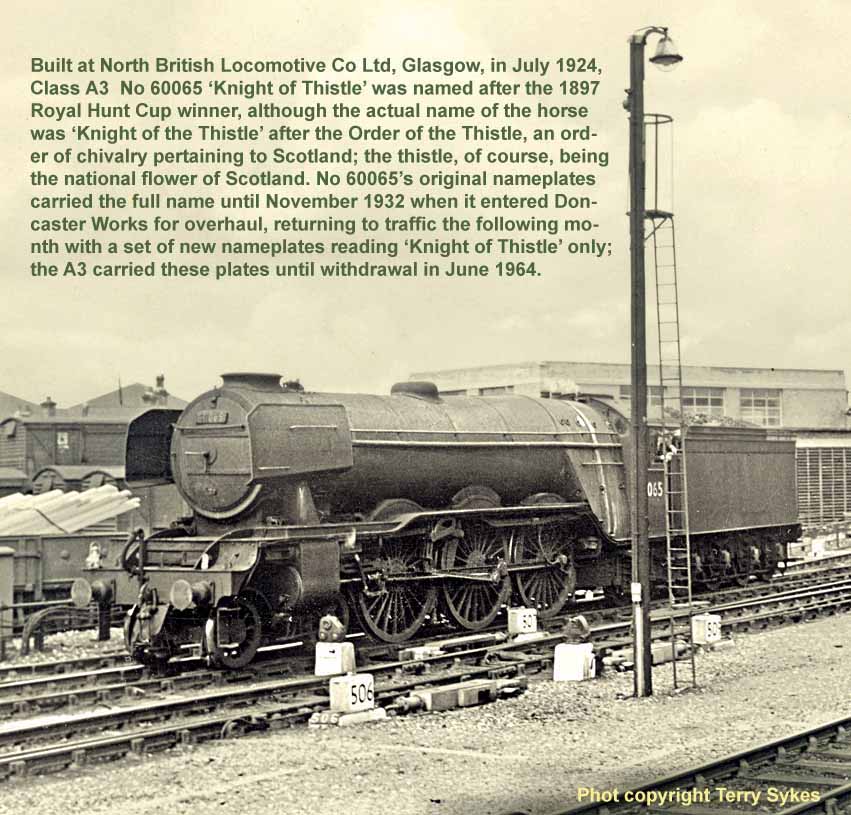
(Above-Below) Next I caught sight of a Class A3 Pacific 60065 Knight of Thistle reversing sneakily round the back of York station to the shed, which prompted this snatched shot, but the lamp post bang in front did nothing to enhance the picture! (Below) Then I managed to frame this thistle-bearing 'Deltic' D9021 Argyle and Sutherland Highlander humming through the station with the southbound 'Flying Scotsman'. 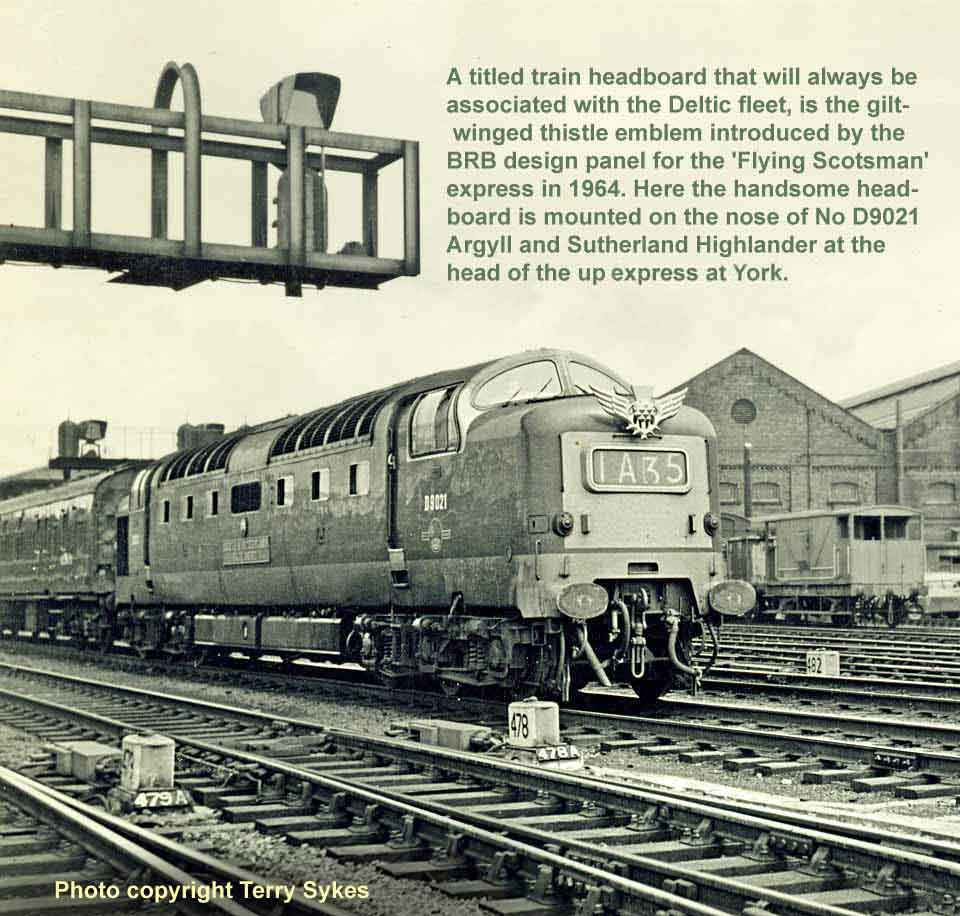
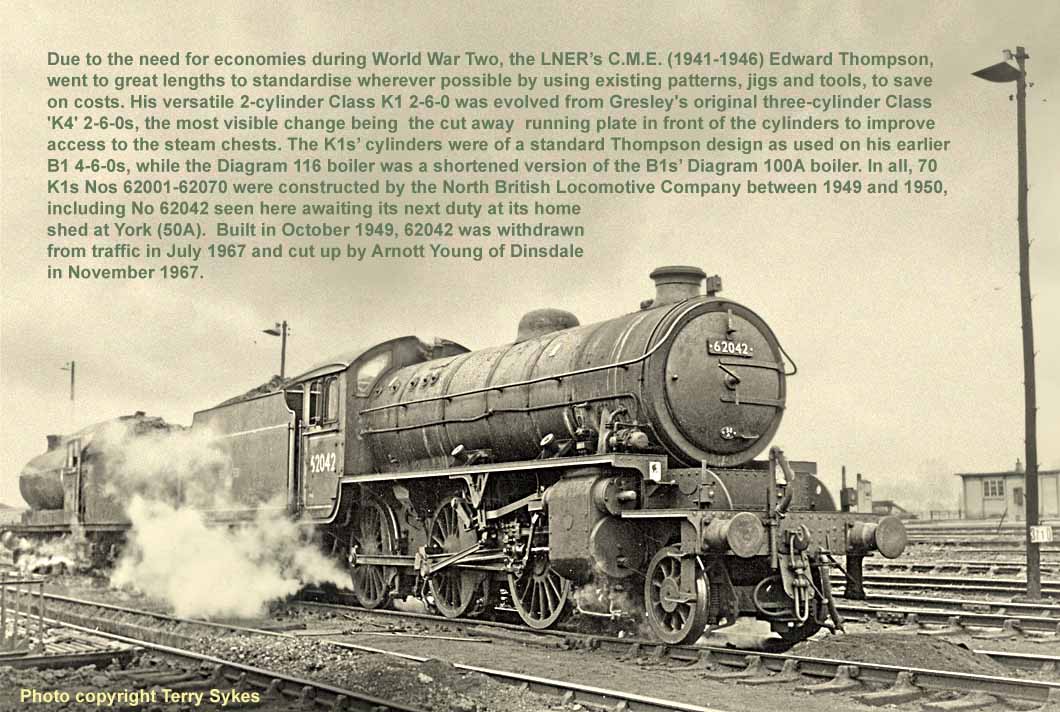
(Above-Below) A decision was then made to head for the shed! To this day I cannot remember how we got into the shed yard! Did we climb over the fence or just walk through the door? Anyway we were in. Most of the locomotives were freight and mixed traffic engines and I took shots of Class K1s Nos 62042 and 62065 in 'too good to miss' positions. 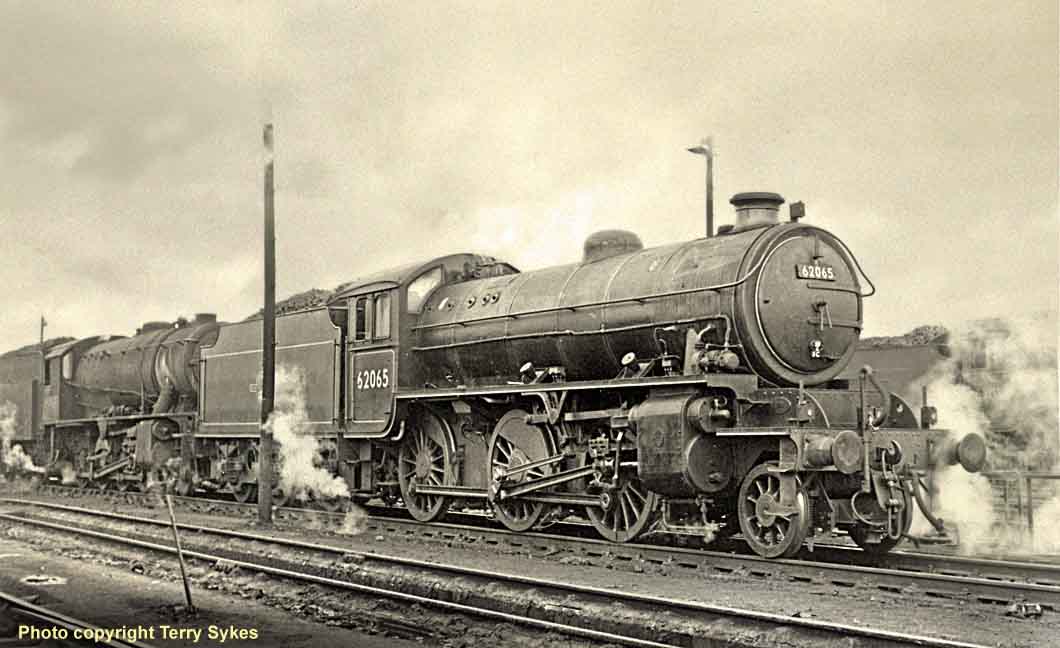
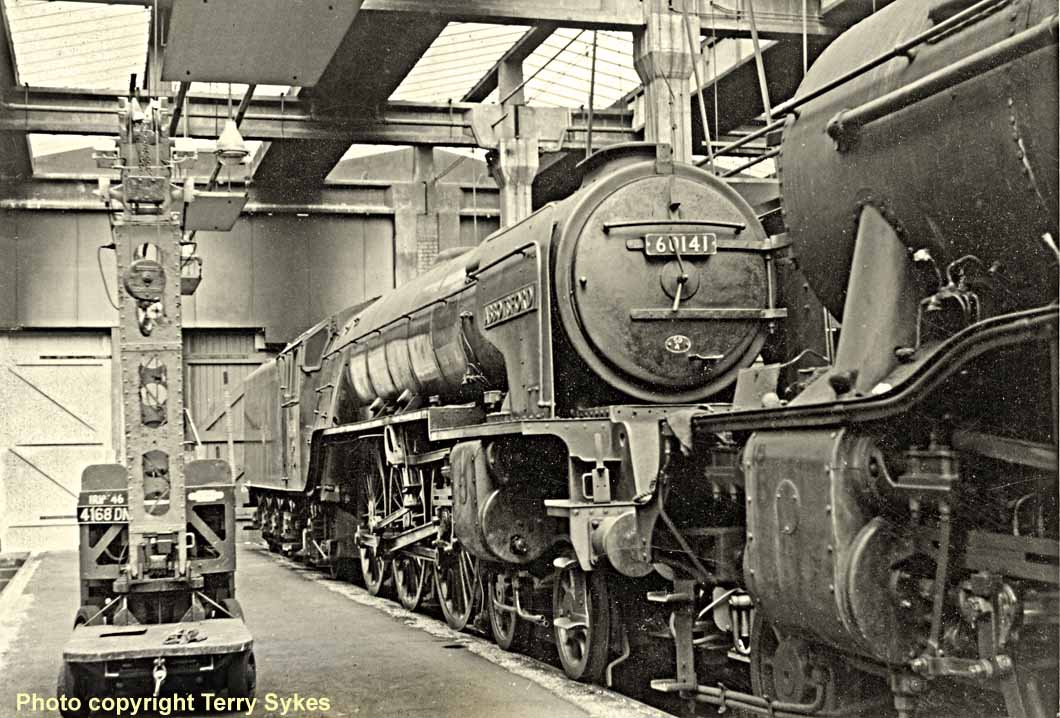
(Above) We then walked right into the shed itself and found ourselves in the workshops. Nobody was about! The camera was really doing the business, even with the lens wide open the depth of field was good enough to capture Class A1 Pacific 60141 Abbotsford from front to back in good sharp focus. Apparently it was the opinion of shedmasters and footplate crew alike that this particular loco's smooth riding and slick performance was a cut above the rest of the A1s. Anyone who has visited the National Railway Museum will recognise the setting in which this photograph was taken in 1964. The repair shop in York MPD has changed very little in the ensuing 51 years, but now of course there is an overhead viewing gallery allowing visitors to see what's going on!
(Below) Meanwhile outside at the far end of the yard was a row of sister A1s, including 'Sir Walter Scott', and 'Sir Vincent Raven'. Having been displaced by modern diesel traction they were standing in store lifeless and forlorn, awaiting their ultimate fate. 'Sir Walter Scott' was withdrawn and sold to Drapers of Hull in May 1964, but it was still in the yard on October 4th. 60126 'Sir Vincent Raven' survived a bit longer being withdrawn and sold to Drapers on January 18th 1965. And 'Abbotsford' was withdrawn on the 5th October 1964, becoming yet another of Drapers acquisitions. 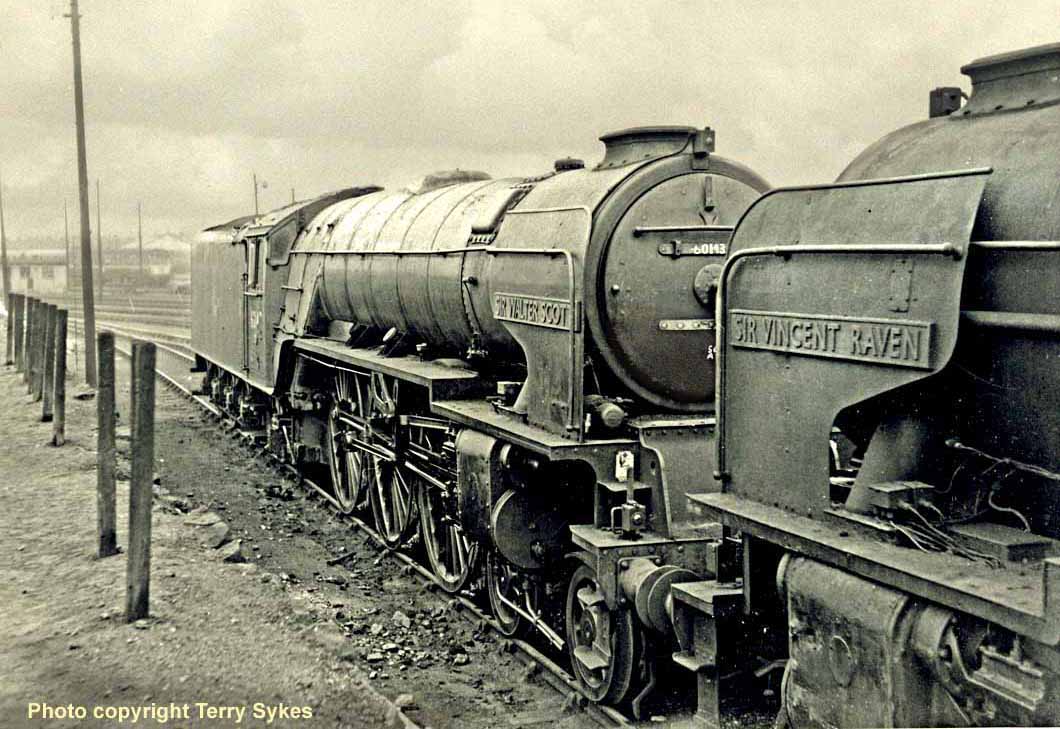

(Above) Finally returning to the station I used the eighth and last frame of the 620 film to photograph Type 4 'Peak' No D58 'The King own Royal Border Regiment' pausing at platform 14 with a Newcastle express. I really enjoyed travelling behind the Peaks; the high pitched rapid warble of the turbocharger when the driver put his foot down always made me smile. The water column sticking out from the station roof may seem of little use to a nodern diesel engine like this one. But as this view from the station footbridge reveals, the heating boiler water fill port in the locomotives roof is clearly visible just behind the cab with the sliding cover in the open position! With the introduction of more modern coaching stock and electric train heating (ETH) the original train heating boilers became redundant and both the water filling point and three bodyside steps were subsequently plated over to prevent crewmen climbing up to roof level in areas with overhead electrification equipment.
THE DIRTY NIGHT WE STUCK ON CADZOW BANK!
The night was dark and drear, and the rain was drawing near, as we set off from the 'Ross' to work a train,
Sure the train was overload, and we didn't know the road, as we started on our journey o'er the main.
We were neither there or here, with two bankers in the rear, at the 'Ross' we had forgot to fill the tank,
And the fireman had a tussle, to get steam to blow the whistle, on the dirty night we stuck on Cadzow bank!
Sure the fireman was a liar, when he said that he could fire, I can prove to you his boasting was all swank,
The conductor cock his lug, when he thought we'd dropped the plug, the dirty night we stuck on Cadzow bank.
With the water out of sight, we were really in a plight, the fireman swore that we would walk the plank,
And we would without a doubt, but we found the fire was out! the dirty night we stuck on Cadzow bank!
I was feeling sore annoyed, with the brakeman Harry Lloyd, for the trouble we had surely him to thank.
With the brake wheel in his hand, he brought us to a stand, The dirty night we stuck on Cadzow bank.
So my friends and fellow mugs, that are toiling on the pugs, Never worry if a pin comes out the crank,
Just keep your boiler right, and you'll no get such a fright, As we did the night we stuck on Cadzow Bank!
D.McLaughlan, Driver Polmadie, 1920. (Steam Lines)
The poem above was written about a hundred years ago, and it's taken some time to research the place names and phrases. Here's hoping I'm not too far off with my findings! The town of Hamilton in Lanarkshire 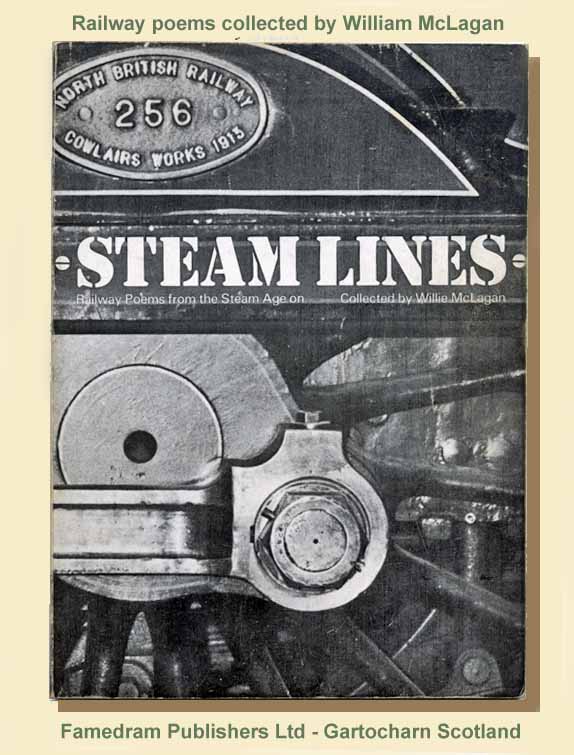 lies just 8 miles southeast of Glasgow City centre, but centuries ago it was known as Cadzow! The stately home of 'Ross House' in Hamilton was known as 'The Ross' and several major establishments, such as Hospitals still carry the Ross name today. So Hamilton was also nicknamed 'The Ross'!
lies just 8 miles southeast of Glasgow City centre, but centuries ago it was known as Cadzow! The stately home of 'Ross House' in Hamilton was known as 'The Ross' and several major establishments, such as Hospitals still carry the Ross name today. So Hamilton was also nicknamed 'The Ross'!
Finally The Scottish enginemen referred to locomotives in general, and freight engines especially as 'Pugs', and adding water to the boiler was referred to as 'filling the tank'. To prevent boiler explosions when the water level became dangerously low, a small lead plug was screwed into the top of the firebox, and this would melt allowing steam and water to blast into the fire and extinguish it! 'Dropping the plug' was a fireman's cardinal sin! It might have prevented boiler explosions but the resulting blowback in the cab has also caused very serious injuries!
MY LAST VISIT TO LEEDS 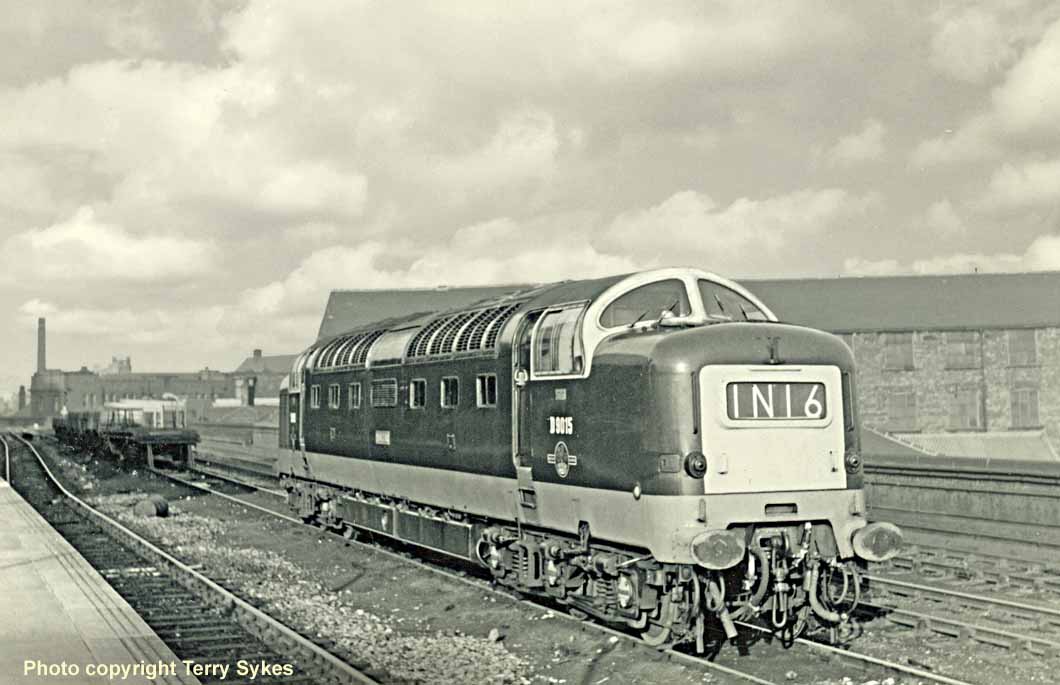
(Above-Below) I made my last photographic trip to Leeds in the autumn of 1964, and as might be expected it turned out to be a mostly diesel affair! But who could complain at this? The first locomotive I encountered was Deltic D9015 Tulyer which I photographed basking in the sunshine at the top end of a partly-modernised Leeds City station. (Below) If you look at this picture of Derby-Sulzer Type 2 Bo-Bo No D7580 you will see what appears to be a substantial enclosed overbridge under construction? Was this included in the final refurbishment of the station a few years later? Due to the upheaval taking place at that time it was hard to know what was going on! The Type 2's roof-mounted headcode panel is sporting a train reporting number '1N 84', but I believe this to be wrong. Prior to BR's Regional reshuffle, a headcode panel displaying a letter 'N' indicated a train destined for the North Eastern Region which was later absorbed with the Eastern Region in 1967. However, in 1964 No D7580 was allocated to Nottingham shed and it is quite possible that the IN 84 headcode hadn't been changed from its previous working from Nottingham to Leeds; indeed the seven-coach working in this picture may well be a Glasgow-Nottingham express about to set off on the last leg of its journey thereby returning the Type 2 to its home depot, in which case the correct headcode should display a letter 'M' indicating a Midland Region destination. The Type 4 'Peak' diesel at the other end of the train may have brought the train down from Scotland. 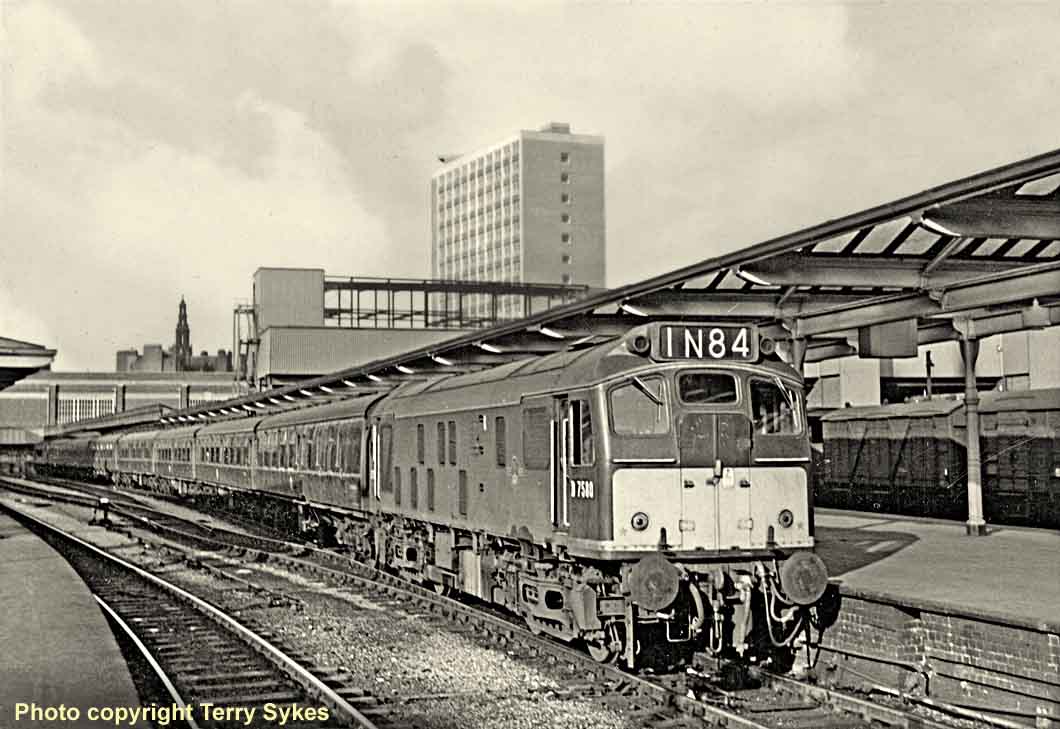
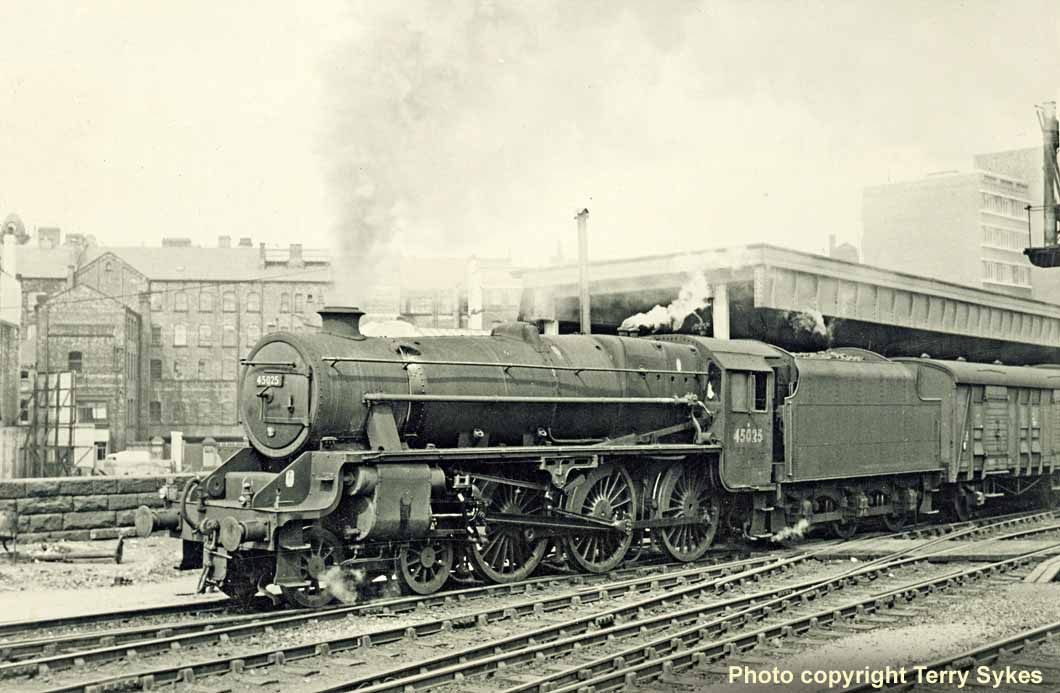
(Above-Below) 'Black 5' No 45025 is about to depart with an express livestock or perishable goods. Here's another engine that survived the cutters torch and passed into preservation. The locomotive spent a few years on the Keighley and Worth Valley Railway before heading north of the border to the Strathspey Railway where it resides today. (Below) Finally the last picture in the station is a bit of a mystery to me. I recall pondering on whether or not to take this shot due the lack of light inside the train shed, then decided to give it a go with the shutter at 1/25sec and the lens wide open. 'Peak' Class 45 D28 halts at Leeds with what could be a York or Newcastle-bound train. 
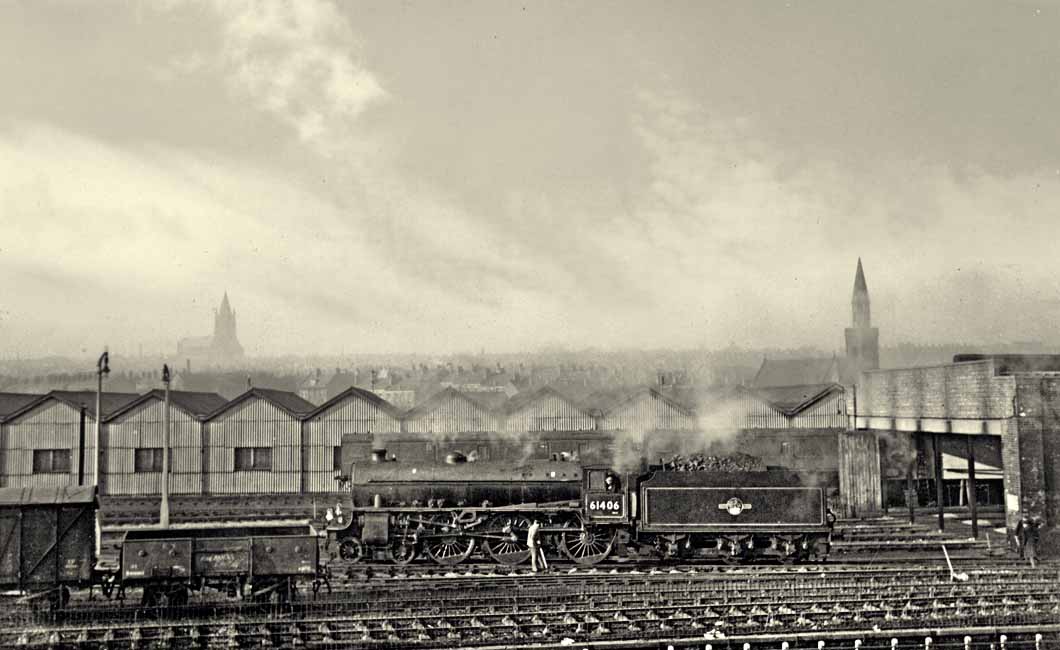
(Above) Sixteen is a busy and confusing age for any youngster. You often find yourself doing something other than what you really wanted to be doing! Work was largely controlling my daily life, girls were entering the equation and sport was taking up most of my leisure time. It's hardly surprising then that I had lost track of the changes taking place to the railway network around Leeds! Striding out to Copley Hill shed I was surprised to find the once-busy depot almost deserted! It was as if the shed had closed but nobody had thought to tell the crew of Thompson B1 61406 from Immingham shed; this was the only engine visible from across the tracks. Little did I know that the shed was indeed due to close just a few weeks later in October 1964. I took this picture wishing I could have been closer to the locomotive, but with hindsight it has turned out to be a pretty good image of 'Old Wortley' in the days before high-rise apartment blocks began to appear on the city skyline. Overlooking the shed on the right is the spire of St Mary of Bethany church, a busy community centre that once boasted three football teams and fifty players for many years. The church closed in 1972 and three years later it was demolished as part of the 'Tong Road Clearance Programme' and hundreds of back-to-back terraced housing were replaced with high rise flats and small parks. How long will it be I wonder before the flats are replaced? Dominating the skyline at the opposite end of Tong Road in Armley is the imposing St Bartholomew's Church; a church has occupied this site since 1630, however this impressive structure was built in 1872 and now gazes down on a very different scene. Anyone passing Copley Hill by train today will see only the back of large modern industrial units, however the long iron footbridge spanning the tracks is still there, leading down to a pleasant park.
(Below) Meanwhile back at Leeds Central I found Standard Class 3MT Mogul 77012 about to move the stock of an express from Kings Cross out of the terminus. The place looks rather run down and even the bright sunshine does little to improve appearances, yet it would be another three years before all trains were diverted to the newly-modernised Leeds City and the ex-GNR Central Station finally closed. 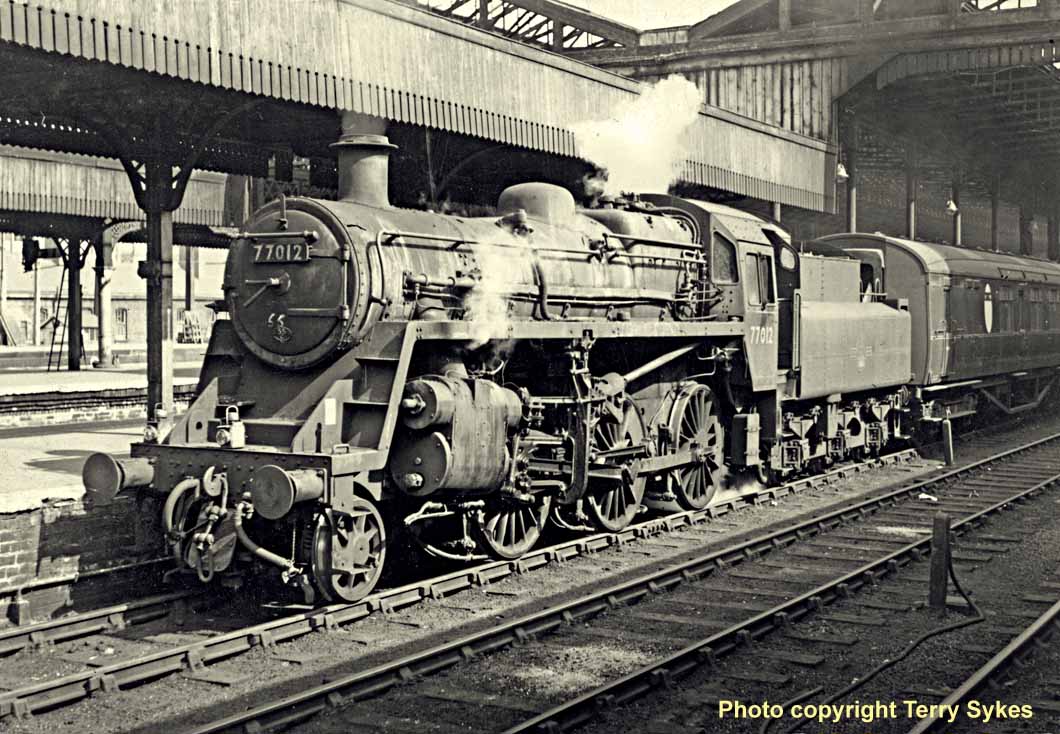
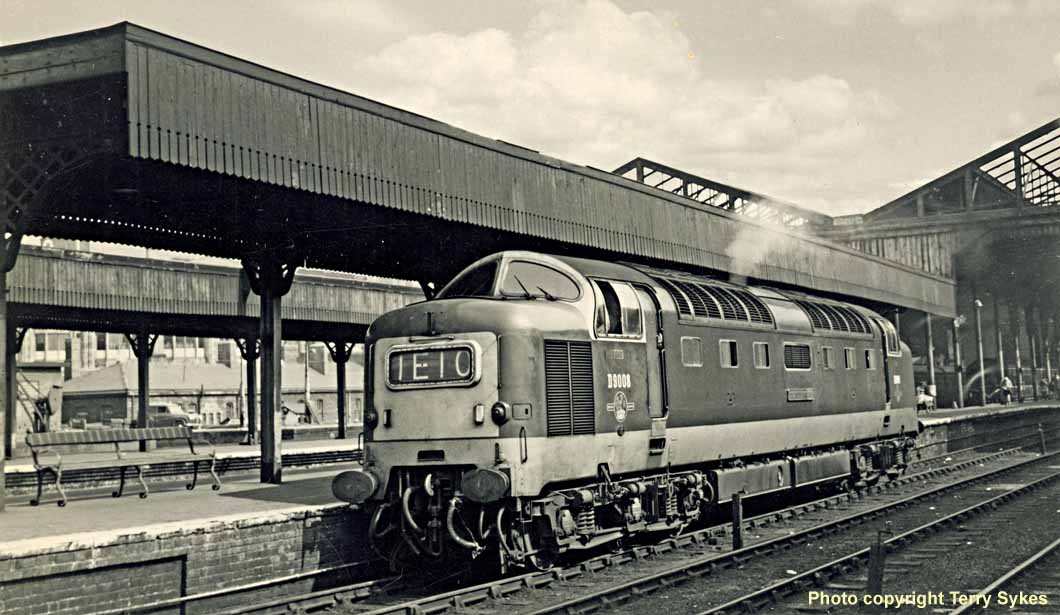
(Above-Below) The removal of the empty coaching stock releases the locomotive that brought the express into Leeds. Here EE Co Deltic class D9008 The Green Howards emerges out of the shadows into the bright sunshine; the headcode blinds reveal its next working, the 1E10 12.14pm Leeds Central-King's Cross. (Below) As D9008 pauses at signals I had just enough time to hand wind the film to the next frame and grab a second picture of the locomotive, its headcode display revealing the identity of the express it had brought in - 1N03 was the 'West Riding' 7.45am departure from Kings Cross. 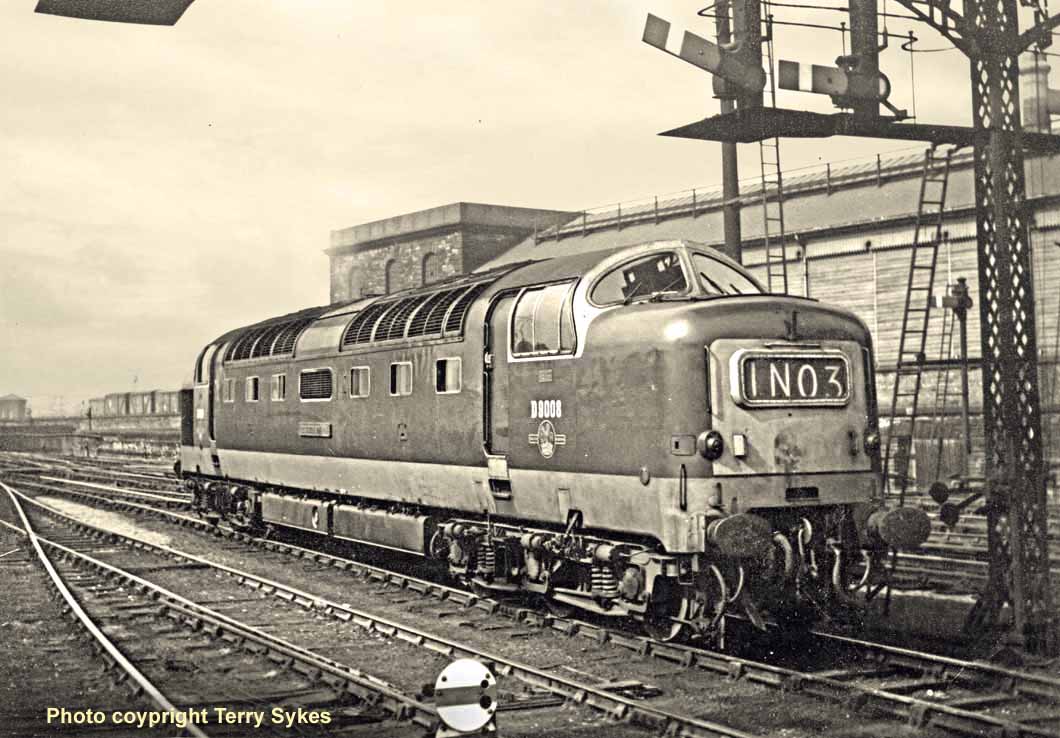
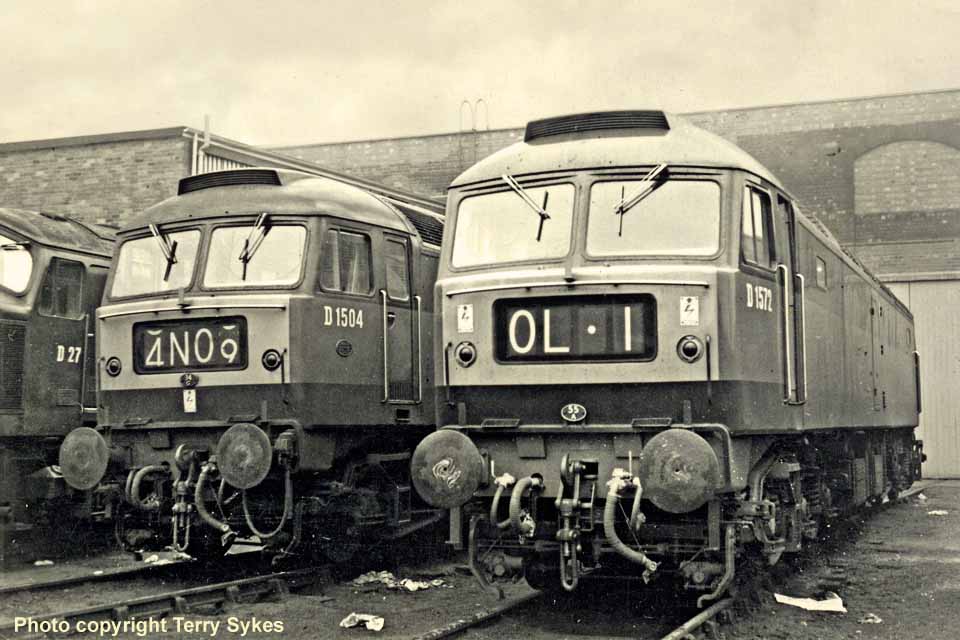
(Above) I walked over to Holbeck shed but must have been disappointed with what I found there. My visit only produced one photograph in the diesel side of the depot. The grubby-looking 1Co-Co1 'Peak' class 45 No D27 appears to be looking enviously sideways at its stablemates, a pair of 2nd Generation Brush Type 4 Co-Cos D1504 and D1572, but it needn't have worried too much; the attractive two-tone green paint job that the pair are displaying here will soon disappear beneath a drab overall blue livery of the BRB's Corporate Identity scheme - dreamed up by some Wally's idea of attractive uniformity! Design department? You must be joking! The overall blue colour scheme made them look like breeze blocks with windows at each end! D1572 was delivered new to Holbeck 55A in April 1964 and is only a few months old in this shot. The view of Finsbury Park 34G's D1504 beside it provides an interesting example of how the sheds fixed the code plates and warning signs in different positions.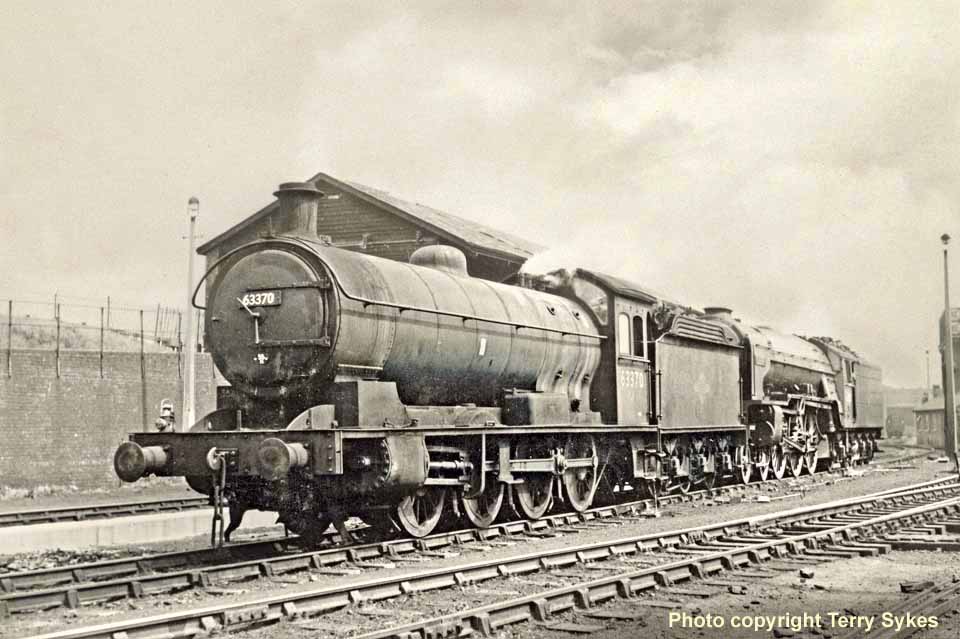
(Above) My final trek of the day took me to Neville Hill Shed, where I photographed a 'beauty and the beast' twosome posing alongside the coaling stage! Let the racehorse race, and the carthorse carry! Built at Darlington works in 1917, the Raven Q6 0-8-0 No 63370 rubs shoulders with her illustrious stablemate A1 Pacific 60121 Silurion built thirty one years later. I wouldn't normally have used up a precious shot on this grimy old work horse, but being one of only a handful of locomotives on shed at Neville Hill that day, it was a good decision to do so, and I'm really glad I did. The costs of building and running this rugged Q6 would have been a fraction of that of its glamorous partner, but during its long lifetime it probably made a dozen times more profit than any Class A1 Pacific ever did! After all freight is what paid the wages, and passenger traffic barely broke even. Sadly the locomotive is seeing out its last few days, being withdrawn the following month on 7 June 1964. A full history of the Class A1 locomotives has been compiled by Phil Champion based on a database provided by Tommy Knox and with reference to the RCTS book 'Locomotives of the LNER Part 2A' as a background. However much more can be found on the excellent A1 Steam Locomotive Trust's website HERE…a visit is highly recommended. 
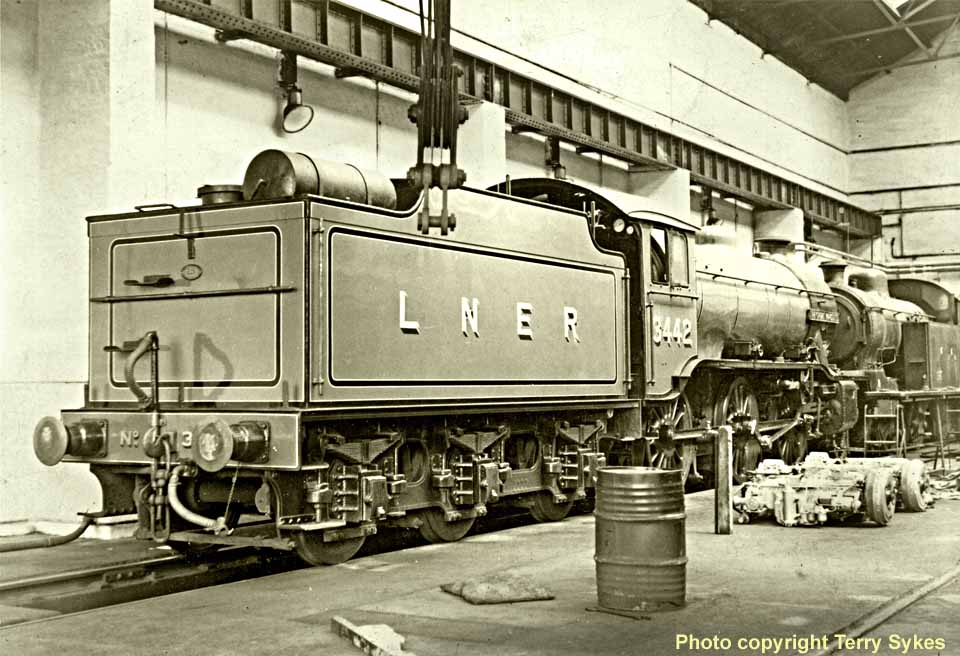
(Above) Meanwhile, after working several rail tours Gresley K4 3442 'The Great Marquess' stands in store inside one of the fitting sheds awaiting a decision on its future. With three cyinders and 5ft 2' driving wheels, the little K4 Moguls packed a huge punch for their size, producing a mighty 36,000lbs of tractive effort thereby avoiding the need for double-heading on the steeply graded Highland Lines. They were well liked, economical, and achieved their purpose admirably well! The loco behind is the now-preserved Class N7/4 0-6-2T No 69621 built at Stratford to a design by George Alfred Hill. It is now owned by the East Anglian Railway Museum and on loan to the North Norfolk railway. The two DMU engine units on the floor are a reminder that steam will soon to be for amusement only.
A CLOSE RUN THING
The driver looked along the track, and thought it's up to me!
And if I fail my days are done down here at Polmadie.
But why should I the burden take, why should I bear the load? I'll never hear the end of it, if I go off the road!
He wiped away the burning sweat his face was set and grey, And though the road was almost blocked he thought he saw the way.
Then up ahead there came a cry. 'Now give it all you've got!'
And with the last bowl of the match, he drew the winning shot!
J Barret, Guard (Steam Lines).
FACINATING PHOTOS FROM HERE AND THERE!
(Above) Here's a picture that grabs your attention! At first glance you could be forgiven for thinking that something has gone wrong with the photograph. But it's just that you don't see too many close ups of the de-streamlined Duchess Pacifics! The LMS streamlining was thought by many to be more of a publicity stunt than anything else. A beautiful new train! However on the 29th of June 1937 the doubters were proved wrong when 114 mph was achieved by the doyen of the class No 6220 Coronation on a special test run just 2 miles short of Crewe station! The LNER record had been pipped by just 1 mph!
But if ever a situation balanced on a knife edge, then this was it! A full brake application at almost two miles a minute made very little difference at first, and the train was still travelling at 100 mph just one mile short of the station. But then the brakes dug in! The complex network of curves and reverse crossings in sight of the platform ends were met at almost 60 mph; the train was bucking wildly left and right as it rampaged through the crossings and entered the station, but it stayed on the tracks. Just! The footplate crew were heroes! Had the train swept into the station on its side carrying everything before it, they would have been regarded as criminals! A knife edge indeed!
Sill Stanier and the LMS board had proved their point and it wasn't thought necessary to pursue any further ambitions with speed. The truth was the LMS never had a suitable stretch of line to make an out-and-out bid for glory - and the LNER were hardly going to lend them theirs! By 1949 the bulbous nose and full casing of all ten streamlined Pacifics had been removed. The casing had made maintenance very difficult, and unlike the LNER A4 Pacifics, the streamlined front end did not carry the exhaust up and away from the drivers view. The Coronation Pacifics needed a nickname - 'Ex' or 'De-streamlined' just didn't work! However the locomotives still carried a bevelled edge cut into the top of the smokebox, and this was thought enough for them to be dubbed 'Semi Streamlined!; Every single member of the class was thereafter referred to as a 'Semi'. Over the years the bevelled fronts were removed as the engines entered the shops for periodic maintenance, and by the late 1950s the last one had gone! I saw my first 'Duchess' Pacific at 12 years of age in 1960, but it was another 20 years before I discovered why I was calling them 'Semis'. Here Camden's No 46241 City of Edinburgh awaits departure from Crewe with a northbound express.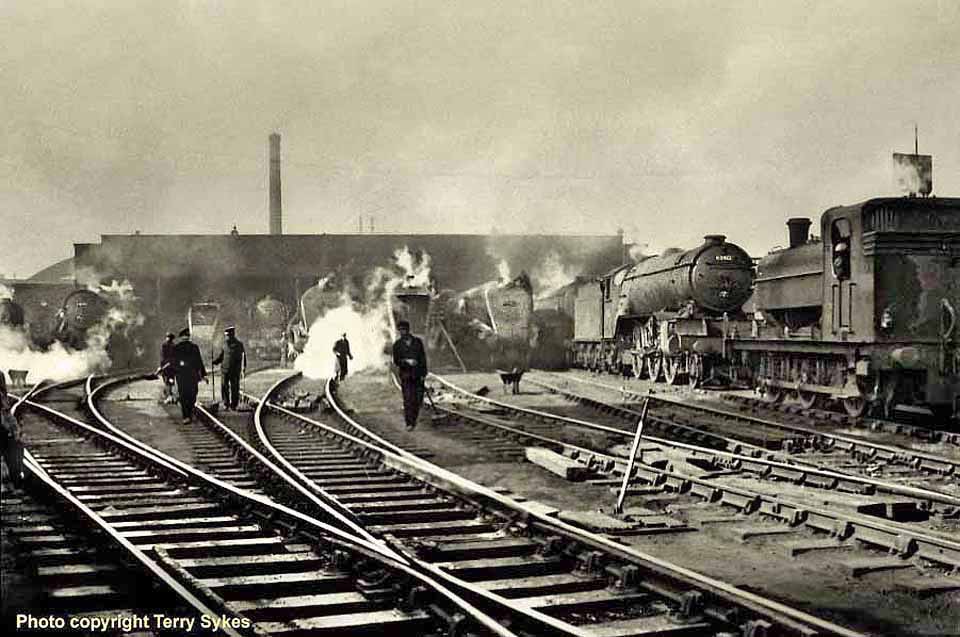
(Above) What a fabulous composition this is, and technically it would be very hard to beat! The foreground leads you into the background and you really have to study it to see what's happening here. Your brain then regroups and begins to take in the middle composition of workers and locomotives. But what is going on?
There are two wheelbarrows and several brush-wielding workers dominating the main composition, but when was the last time you saw an organised gang sweeping a loco shed yard? And who's the mysterious figure emerging from the steam in the centre? is he wearing a gabardine?
The picture is scanned from an old 127 contact print of professional quality. Is this a BR publicity shoot? Before the age of digital cameras high quality Polaroid shots were taken on film sets to make sure that everything was in the right place. Everybody here is wearing the same clean overalls, and the emphasis is definitely on the workers and not the locomotives. It begs the question that if you or I had sneaked into Kings Cross loco shed, would we stand in front of the workforce and take a picture of them? I don't think so!
The pencilled date on the back is 1955, but if it was 1954 it would be on the right timeline for BTF's famous 'Elizabethan Express' film. If I'm right and it is a film shoot, the odds are that the moment it was over the guys would be expected to hand their new work gear back to the shed stores. The next time you watch the 'Elizabethan Express' on 'you tube', you will see a brief shot of the shed yard that is very similar to this picture, and remember that 90% of the footage taken on these occasions was invariably left on the cutting room floor. 
(Above) Here's a memory from the past. During the 1980s and 1990s I was involved in a few projects on the Worth Valley railway. On three or four separate occasions I entered the mess room to find this very evocative photograph had fallen off the notice board and was being kicked around on the gritty floor.
Fed up of picking it up and cleaning it, I eventually took it home to scan. The photograph was taken at Oxenhope in the late 1970s, probably during the filming of the classic movie 'Yanks'; the train engine in the picture is the USA 2-8-0 locomotive ' Big Jim' which was acquired from Poland. Was it a staged film set, or was it a genuine shunting error? I have no idea! The image is great, but the caption chalked on the mess room notice board was even better!
RUSHING and PUSHING and DASHING when SHUNTING, gets you THIS!
The next image is not in itself very unusual, but coupled together with a poem from 'Steam Lines' it always makes me smile!
THE POLMADIE WINDJAMMER
Did you ever work a train down Bellshill, or the R&C.
Wi' aboot thirty odd o' mineral, and a brake nae what it should be!
And did you ever get that feeling 'round Drumpark or Tannochside,
That you weren't holding up a bit, though your brakes were all applied.
And did you ever get the yellow an' reverse in one last bid,
When from mount Vernon like an autumn moon, the next ones glowing red!
Then screeching doon through Uddingston, Wi' the thought this time your loused,
not worrying at passing the signal, 'long as nothing crossed your bows.
And did you ever on such an occasion use that oft' repeated crack,
When glowering back towards the van, 'That blighters on his back!'
Well, if you've never had this experience, wi' a donkey pounding like a hammer!
Then you've never worked a 'Jumbo,' a 'Polmadie Windjammer!'
A Gow, Driver (Steam Lines)
(Above) It's almost prophetic that the driver in the picture is looking under his locomotive. Perhaps he's wondering where his brakes went! It's possible that this photograph of McIntosh 812 class 0-6-0 No 57572 has been taken from a passing Scottish rail tour, the engine was based near Kilmarnock, and it's another great picture! I have not been able to discover why the 0-6-0 freight locomotives designed by Drummond and his successors in the late 19th and early 20th centuries were nicknamed 'Jumbos'. Perhaps they were first labelled 'Drumbos' after the designer, or perhaps it's because they were capable of hauling very heavy trains in relation to their size?
However figuring out why they were also nicknamed 'Windjammers,' is a much easier task. The Glaswegian enginemen with their wry sense of humour would have looked on in amazement at the arrival of the first streamlined 'Duchess' Pacifics. And then turning to the old 'Jumbos' they were driving on a daily basis with their wide flat smokebox mounting plates, it was just a matter of time before some wit referred to them 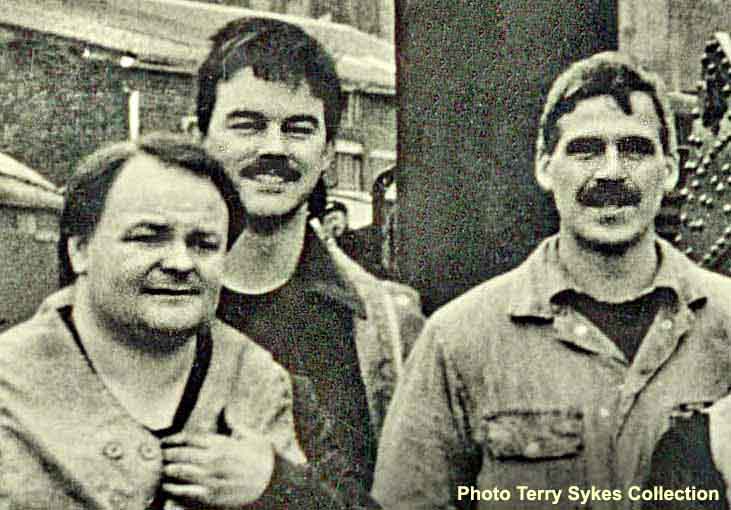 as 'Windjammers!'
as 'Windjammers!'
And finally the R&C was the 'Rutherglen & Coatbridge' railway built by the Caledonian in 1865. It was closed to all but goods traffic in 1964, but reopened to passengers in1994, and was electrified shortly after.
(Inset-Below) Next is a photograph honouring the Keighley and Worth Valley Railway's 50-ton steam crane crew in 1989. The gang is pictured at Keighley station in front of the ex-Crewe works 50 ton crane. They have just lifted the 22 ton fully restored Garsdale turntable into its new home beside the signal box, and are deservedly looking pretty pleased with themselves! There are fourteen human heads in this photograph, but can you spot them all? If not I'll give you a clue. The train driver Ralph Ingham is looking back from the cab of the Jinty 0-6-0T No 47279 some fifty-odd yards away!
THE DEVONIAN.
There's holidays, and then there's holidays! And in 1962 our parents decided that the family deserved some time away from it all. Far away from it all! And in the days before foreign package holidays gripped the nation, the South West coast of England was just about as far as you could go without actually falling into the sea.
My stepdad was now employed as a 'Wool Sorter' and the family income was buoyant. My eldest brother Geoff was a fully fledged teddy boy and wouldn't be seen dead in our company, so he got farmed out somewhere and the rest of us were on our way. Keith and I could hardly wait, after all they had funny looking engines down there! We'd already been amongst them two years earlier at Old Oak Common shed on the school's London trip, but now we'd see them at work.
We left Bradford Foster Square station at 9.22am aboard the chocolate and cream coaches of the 'Devonian'. We had caught this train several times before at Shipley on spotting trips to Leeds, but at 14 years of age it never occurred to me that the train actually went to Devon! The clue was in the name, of course, and it was hard for us to believe that before we got to Paignton there would be Great Western locomotives on the front.
The journey south was like a dream and I was captivated by the names of the towns and cities where we stopped: Derby, Birmingham, Gloucester, Bristol, Weston Super Mare, Taunton! And what was Taunton famous for? Oh yes, that's the place where mum and dad asked a railway official if there was enough time to hop off the train and get some sandwiches from the station buffet. 'Plenty of time,' he replied.
No there wasn't!
Keith and I had the unique experience of leaning out of the window and watching our anxious parents dashing along the platform as we disappeared down the track! The next stop was Exeter St David's, where we were removed with our luggage and deposited on the platform by several enthusiastic station staff. Then ten minutes later we were pushed aboard the next train to arrive, which incidentally had mum and dad's heads hanging out of it! We thought it was really funny, after all we spent most of our weekends jumping in and out of trains, but mother suffered a serious sense of humour failure which lasted 'til the end of the following day.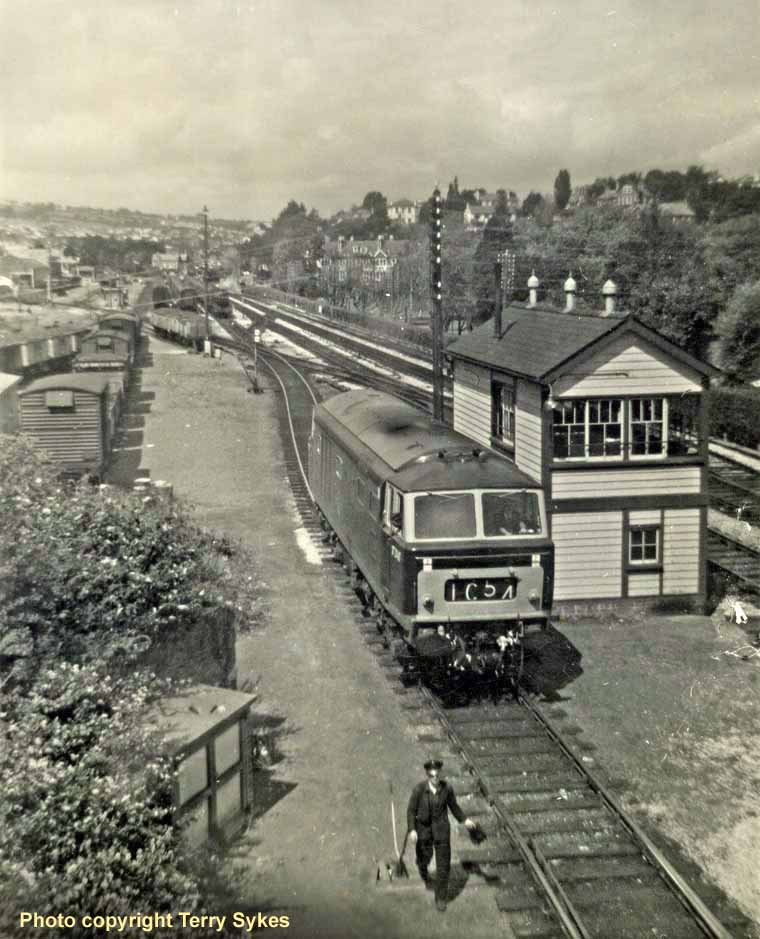
(Above-Below) During our Devon holiday we spent a lot of time in a large park in Paignton and on the beach at Goodrington Sands, both spots being in close proximity to the railway, which today of course forms part of the Torbay Steam Railway. My first Brownie 127 photo shows Hymek diesel hydraulic locomotive D7014 leaving its train behind in the carriage sidings outside Paignton. The picture was taken from the road bridge above Goodrington Sand station, and Paignton Station is just beyond the curve in the distance. Also in the picture, a Hall class 4-6-0 locomotive No 6923 Croxteth Hall has just arrived with the stock of a terminating train. The beach at Goodrington was a great place to watch the Halls, Granges, and occasional Castle class locomotives climbing the 1 in 60 gradient with long passenger trains. But this was just the branch line to Kingswear and the trains were few and far between - the call of the busy main line just ten miles away at Newton Abbot could not be ignored! So after a bit of parental badgering, the next morning Keith and I jumped aboard the local stopping train at Goodrington Sands. The train was just rolling to a halt behind No 6874 Haughton Grange, when I grabbed this hurried shot (below) before legging it over the bridge and jumping on board.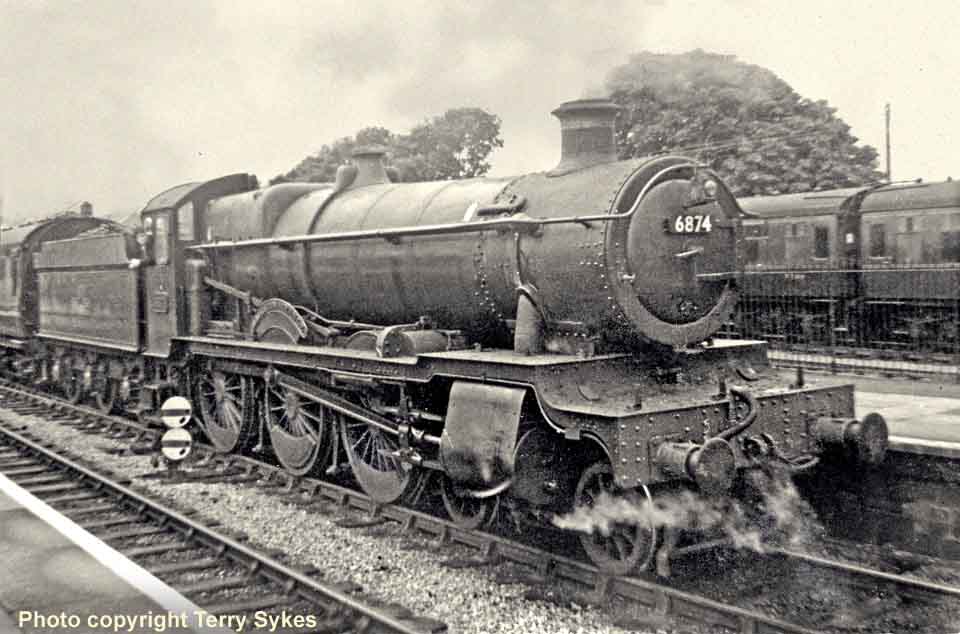
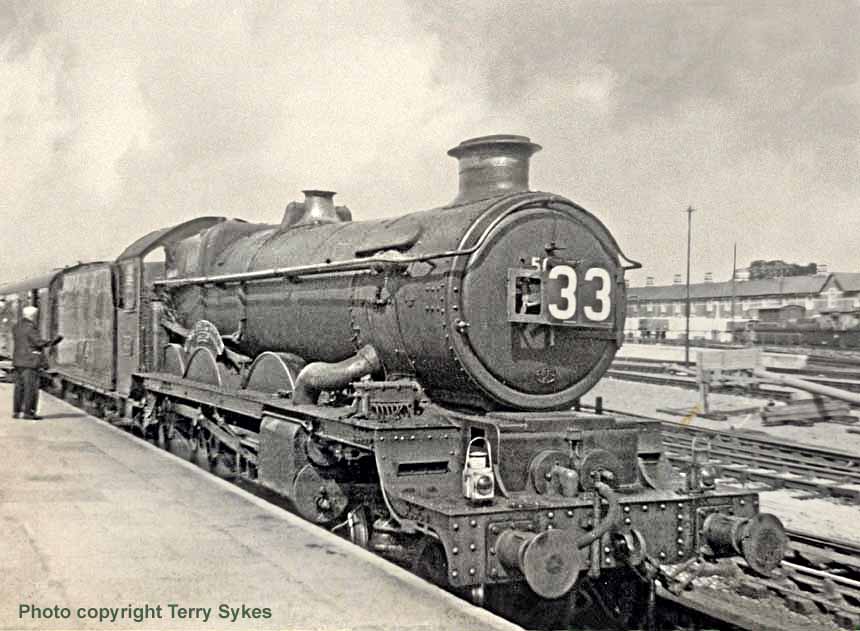
(Above-Below) Newton Abbot was a joy and there was always something going on in the vicinity of the engine shed just adjacent to the station. However it still had the feel of a quiet country junction, and it was  hard to believe that it had attracted the attention of no less than sixty five enemy air raids in the conflict with Germany just twenty years earlier. The picture above shows a double chimneyed Castle 5066 Sir Felix Pole awaiting departure with a westbound express; it appears the engine has lost the first digit of its train reporting number. For over fifty years I thought this train was heading to Plymouth and beyond, but after checking out Ed Chaplin's page 23 I now find that the train is setting off to where I just came from! It's a Paddington-Paignton express, which has lost a '1' digit somewhere along the line. Wait a minute though! On checking Ed's page again, perhaps it has lost a letter 'C' thus indicating the Wolverhampton-Penzance 'Cornishman' express. The Western Region's train reporting system was a minefield! (Below) Meanwhile at the other end of the station, the GWR's claim to the best mixed traffic engine in the country lies with the 4-6-0 Hall class locomotives. No 4996 Eden Hall is carrying a light engine lamp code so it has either just coupled-up to, or is about to come off an eastbound train.
hard to believe that it had attracted the attention of no less than sixty five enemy air raids in the conflict with Germany just twenty years earlier. The picture above shows a double chimneyed Castle 5066 Sir Felix Pole awaiting departure with a westbound express; it appears the engine has lost the first digit of its train reporting number. For over fifty years I thought this train was heading to Plymouth and beyond, but after checking out Ed Chaplin's page 23 I now find that the train is setting off to where I just came from! It's a Paddington-Paignton express, which has lost a '1' digit somewhere along the line. Wait a minute though! On checking Ed's page again, perhaps it has lost a letter 'C' thus indicating the Wolverhampton-Penzance 'Cornishman' express. The Western Region's train reporting system was a minefield! (Below) Meanwhile at the other end of the station, the GWR's claim to the best mixed traffic engine in the country lies with the 4-6-0 Hall class locomotives. No 4996 Eden Hall is carrying a light engine lamp code so it has either just coupled-up to, or is about to come off an eastbound train.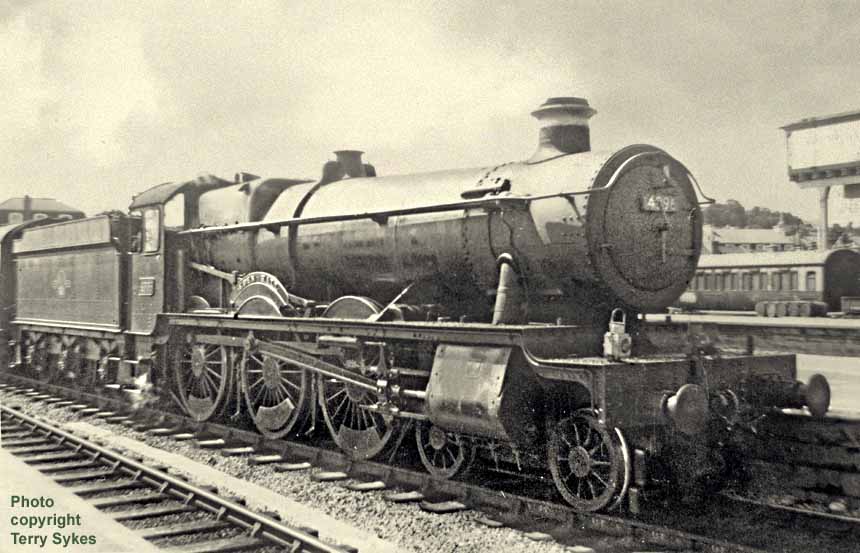
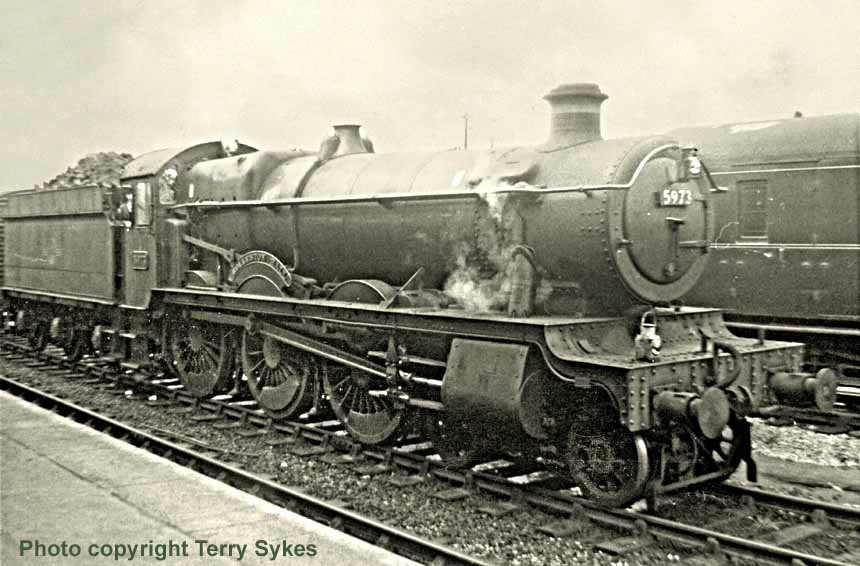
(Above-Below) The weather on the day was disappointing for a young lad with a cheap camera, and the sunny spells were scarce. Pictured above in dismal light is No 5973 Rolleston Hall rolling an express perishables meat and fish train to a signal halt on the through avoiding line. Built at Swindon in 1937 No 5973 has only one month of service life left; the engine would be scrapped one month later in September at its Swindon birthplace, and it's quite likely that many of the workers who built her would have witnessed her demise! (Below) Hallelujah! A sunny spell and an ex-works locomotive! Here 5992 Horton Hall is in absolutely immaculate condition as it pulls up right alongside us with a westbound express. My brother is sitting on the trolley and doesn't seem too impressed though, perhaps it has spoilt his view of the engine sheds over on the right of the station. The freshly overhauled locomotive would survive another three years, almost to the end of GWR steam.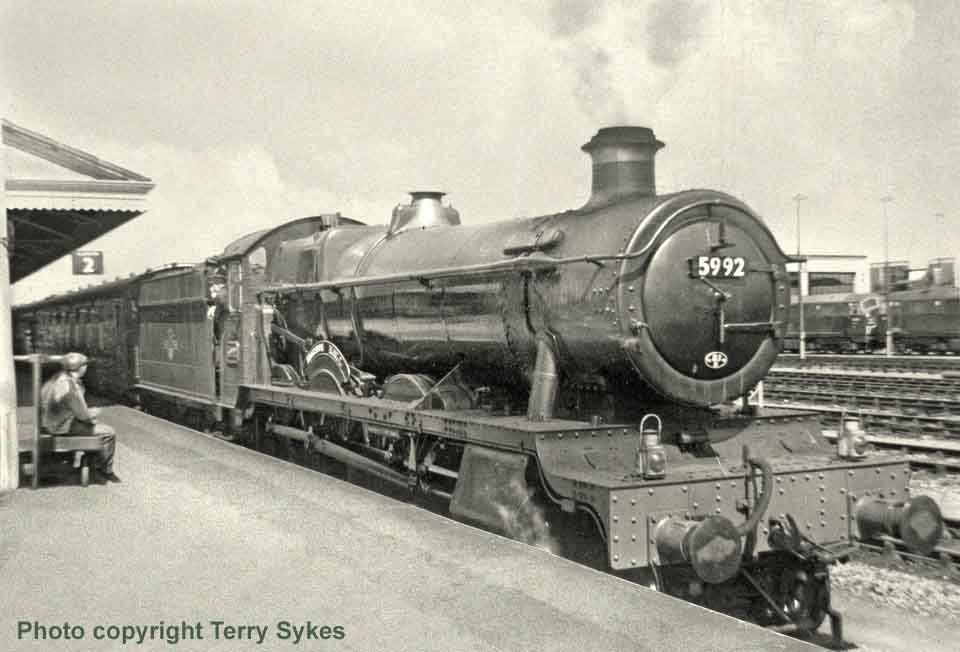

(Above-Below) Newton Abbot on a different day! 'Castle' class No 4037 The South Wales Borderer, looks clean and tidy as it runs into the station with a down train composed entirely of Midland coaching stock; the letter 'Z' in the train reporting number indicates a special working and the '10' is likely to be a Wolverhampton-Penzance train. I particularly like the 'going away' shot (below); it is a great composition, which leads me to believe that the first photo was taken by David Sturdy and the second by his older brother Jack with his more advanced Voigtlander camera, both boys being pupils at my old Bingley Secondary Modern School who happened to be on holiday in south Devon the same week as my brother and I. Parked just beyond the stop signal on the same length of track is a Type 2 diesel hydraulic locomotive that will couple up and assist the train over the severe gradients of the Devon banks that lie directly ahead on the way to Plymouth. The full story of how I came to acquire Dave and Jack's photos thirty-odd years later is related below.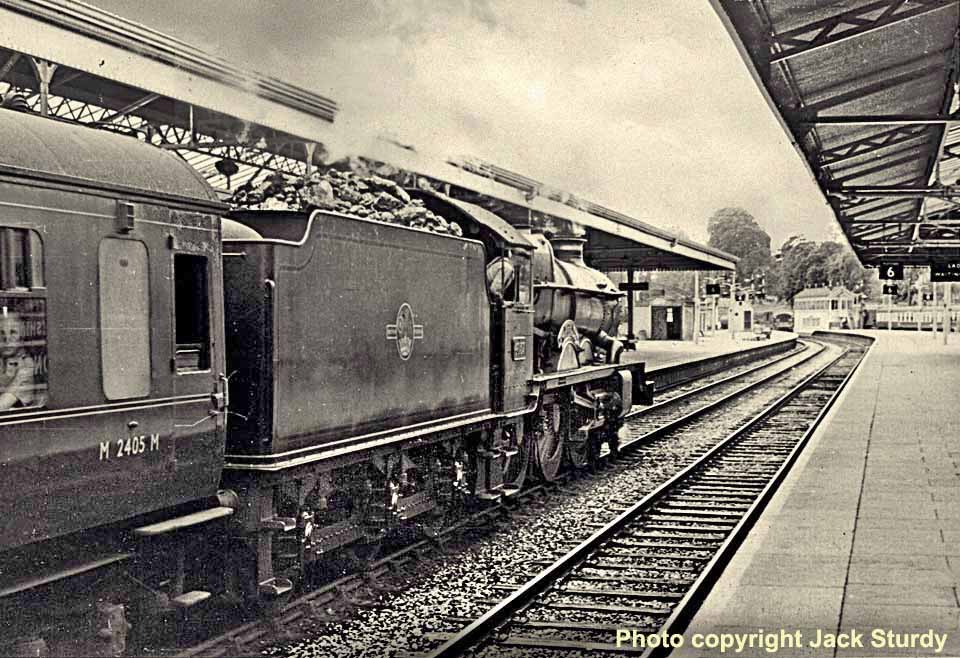
It wasn't long before my brother and I were on the move again, and our next target was Exeter St David's. It was easy to make friends on holiday, even more so among fellow spotters. So a group of us took off one morning  behind a very new looking Hymek diesel hydraulic locomotive D7012. And I have to tell you we were very impressed! The acceleration, and above all the top speed the other side of Newton Abbot was a real eye opener, and I still have a soft spot for these locomotives.
behind a very new looking Hymek diesel hydraulic locomotive D7012. And I have to tell you we were very impressed! The acceleration, and above all the top speed the other side of Newton Abbot was a real eye opener, and I still have a soft spot for these locomotives.
Exeter St David's had a completely different feel about it compared to Newton Abbot, it seemed much more businesslike. The trains seemed to arrive quickly braking hard, and then departing soon after in a swift no nonsense manner. Sadly though dieselisation was biting hard and most of the expresses were hauled by Type 4 2,200hp Warship diesel hydraulic locomotives. On the other hand the Southern Region's 'West Country' Pacifics kept popping in and out, and we watched them being banked up the severe gradient to Exeter Central station by a large Maunsel tank locomotive. I regret now not catching a picture of the banker giving it all!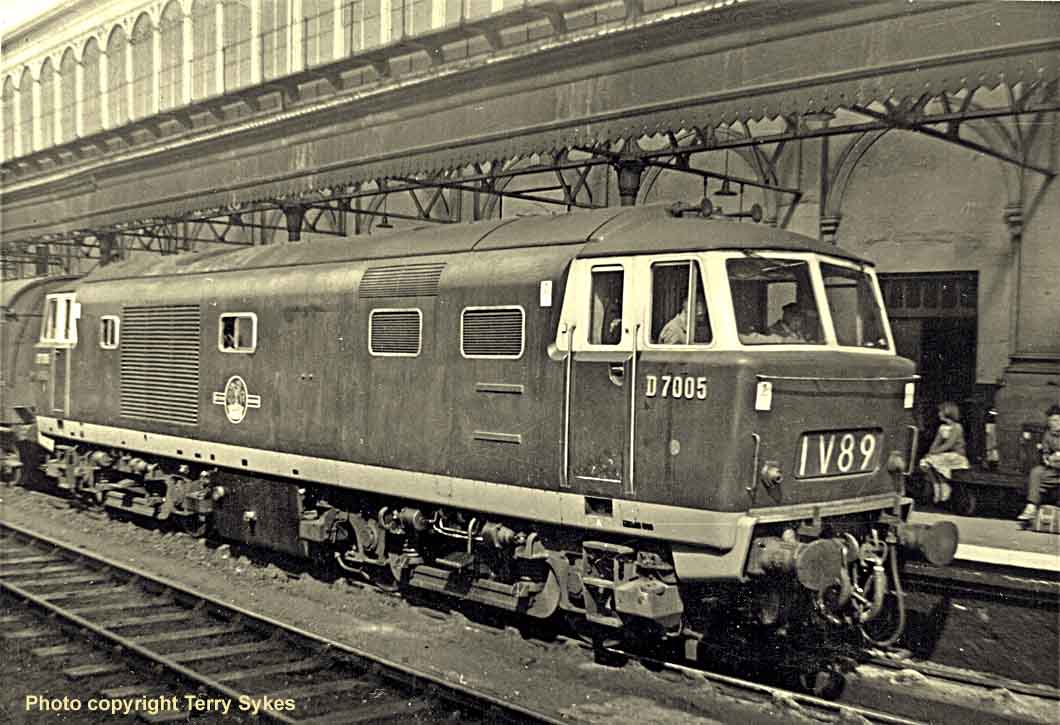
(Above-Below) Not getting an opportunity to photograph the Hymek that brought us into Exeter was a situation soon remedied. The first westbound express after our arrival produced another of the handsome Type 3, 1700hp locomotives. Hymek D7005 which is sporting a 1V89 train recording number, if I'm correct the '1' indicates express, and the 'V' signifies a train travelling west beyond Bristol. My next photographic offering below, exposes the limitations of my humble camera. Diesel hydraulic 'Warship' D865 Zealous has come out reasonably well, but the Rebuilt 'Battle of Britain' Pacific No 34060 25 Squadron at the adjacent platform is a bit on the dark and fuzzy side. Perhaps it's the chronically slow shutter speed that lends itself to a bit of camera shake now and again? Who knows?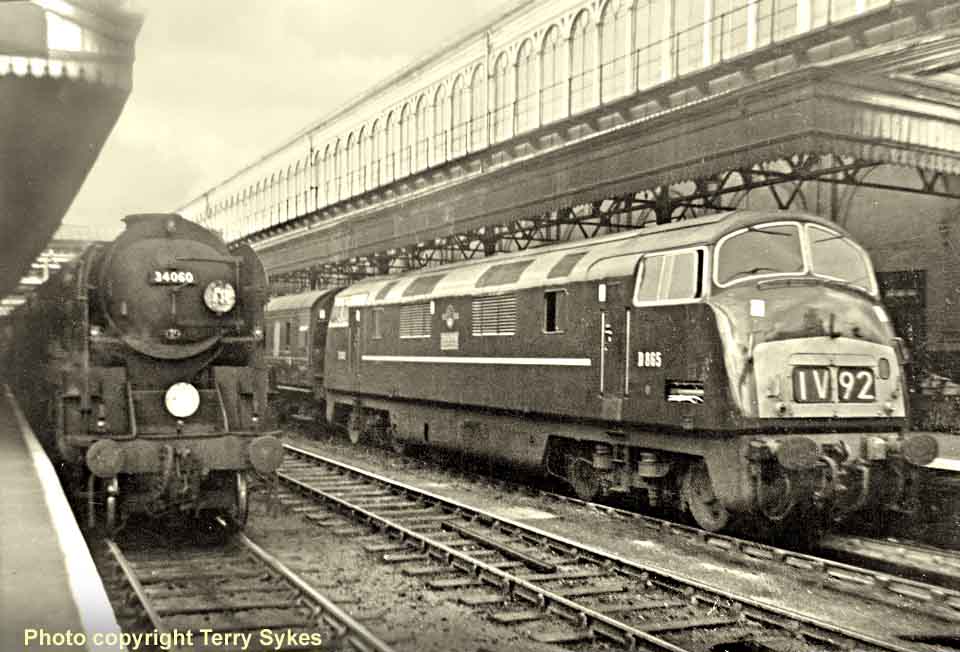

(Above) The next express to occupy the platform was numerically the next train heading west, 1V93. This time the camera has performed better; my hand was steadier and the light was good to record D864 Zambesi with a Liverpool-Plymouth train. You could never claim that the 'Warships' were handsome machines, but you soon became accustomed to their somewhat 'Deputy Dog' appearance, and of course all had patriotic and stimulating names. But handsome is as handsome does, and the 'Warships' were powerful and fast. All of their 80 ton weight was available for adhesion, and their 52,000lbs of tractive effort was almost 30% more than the Class 8P 'King' locomotives. Although they could reach 100mph with ease, their small driving wheels running at high speed were causing problems with stress fractures on certain stretches of rail, hence they became limited firstly to 90mph, and then later to 80mph.
(Above) The through expresses were obviously grabbing most of our attention, but over at the other side of the station, it was hard to ignore a quaint little tank engine coming and going at regular intervals. The picture shows Collett's 0-4-2 tank locomotive No 1471 awaiting departure with what is probably an autotrain for the Tiverton branch. It was many years later I discovered what it was and where it was going, but I'm really pleased with myself for taking a photograph of this locomotive. However I've opted to post the picture above by David Sturdy which is slightly better than my offering.
(Below) And finally the picture that made it all worthwhile! ... 'And then the sight that to this day, still causes me elation! Earl of Powis 'Castle, class, rolls into the station. The train it pulls seems much too long for one of small dimension, I wait to see a banker fix, I'm filled with apprehension!' ... This was the sight that years later prompted me to write the poem featured earlier on the page. Double chimney 'Castle' No 5056 Earl of Powis runs into Exeter with no less than 13 coaches trailing behind it. (We were all coach counters in those days!) With the Southern trains being banked up to Exeter Central, I was half expecting to see a banker attach for the westward uphill departure of the castle also, and while I was still thinking about it, she took off! The sound and speed of that departure is something I shall never forget. It was just simply awesome! The smoke hanging in the air, and the sound reverberating round the station seemed to last for a very long time.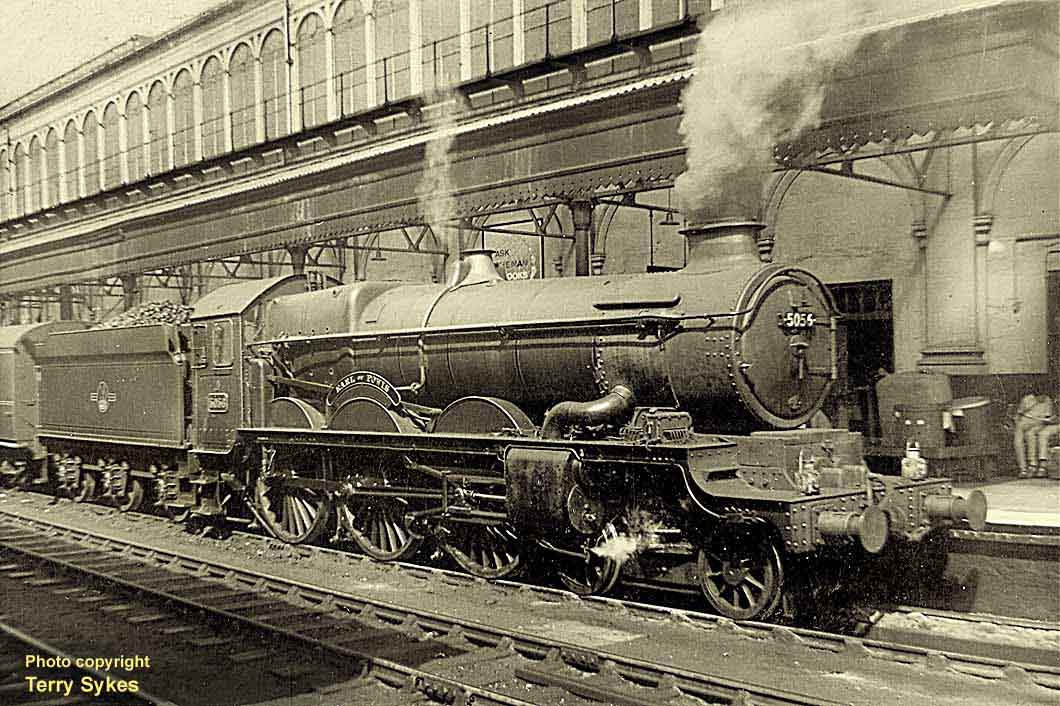
 (Inset-Below) Many years later when working on the Worth Valley Railway I was given some negatives to print, along with some railway photos that had been donated to the Vintage Carriages Trust. I was really surprised to find a photo of a young-looking David Sturdy, who was a pupil in the same class as my brother at Bingley Secondary Modern School.
(Inset-Below) Many years later when working on the Worth Valley Railway I was given some negatives to print, along with some railway photos that had been donated to the Vintage Carriages Trust. I was really surprised to find a photo of a young-looking David Sturdy, who was a pupil in the same class as my brother at Bingley Secondary Modern School.
This picture (inset) shows him standing in the cab of a 'Battle of Britain' Pacific No 34049 Anti Aircraft Command. (Below) The following pictures depict 'Merchant Navy' Pacific 35014 Netherlands Line first running into Exeter Central with the 'Atlantic Coast Express', and then later on by the coaling plant at Exmouth shed.
The question is, were these pictures taken by David? He looks about the same age as my brother in 1962, and 34049 was scrapped the following year. After several failed attempts at making contact I eventually tracked David down, and it turns out that we were both on holiday in Devon at the same time - and even more of a coincidence on the very same day I was photographing Western Region trains at Exeter St David's station, he and his brother Jack were photographing Southern Region trains at Exeter Central Station! He has no idea how some of his prints came to be donated to the KWVR twenty six years ago, but is delighted that they were and that the story has come full circle. David is just as passionate about railways now as he has always been, and is happy that we're using some of his prints on this page. 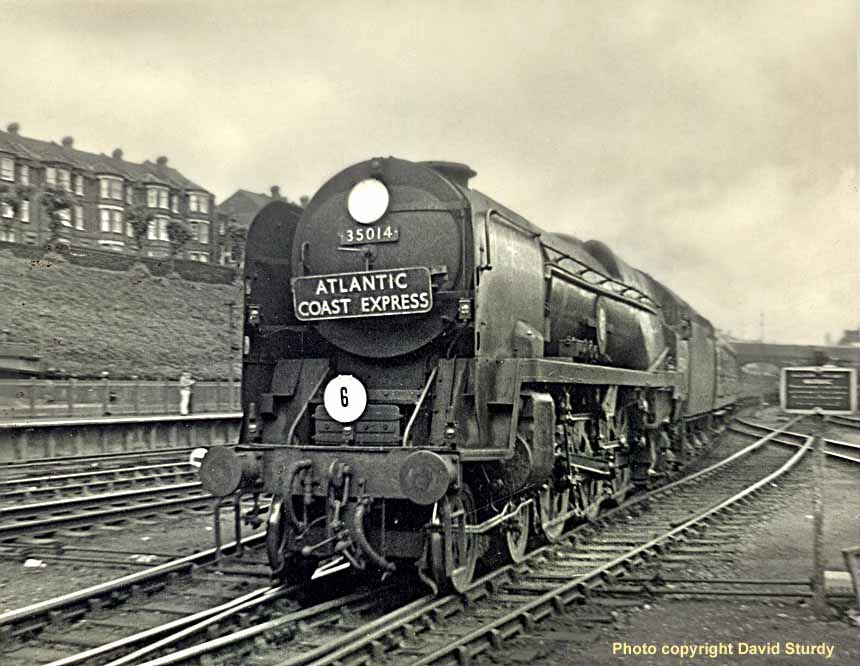
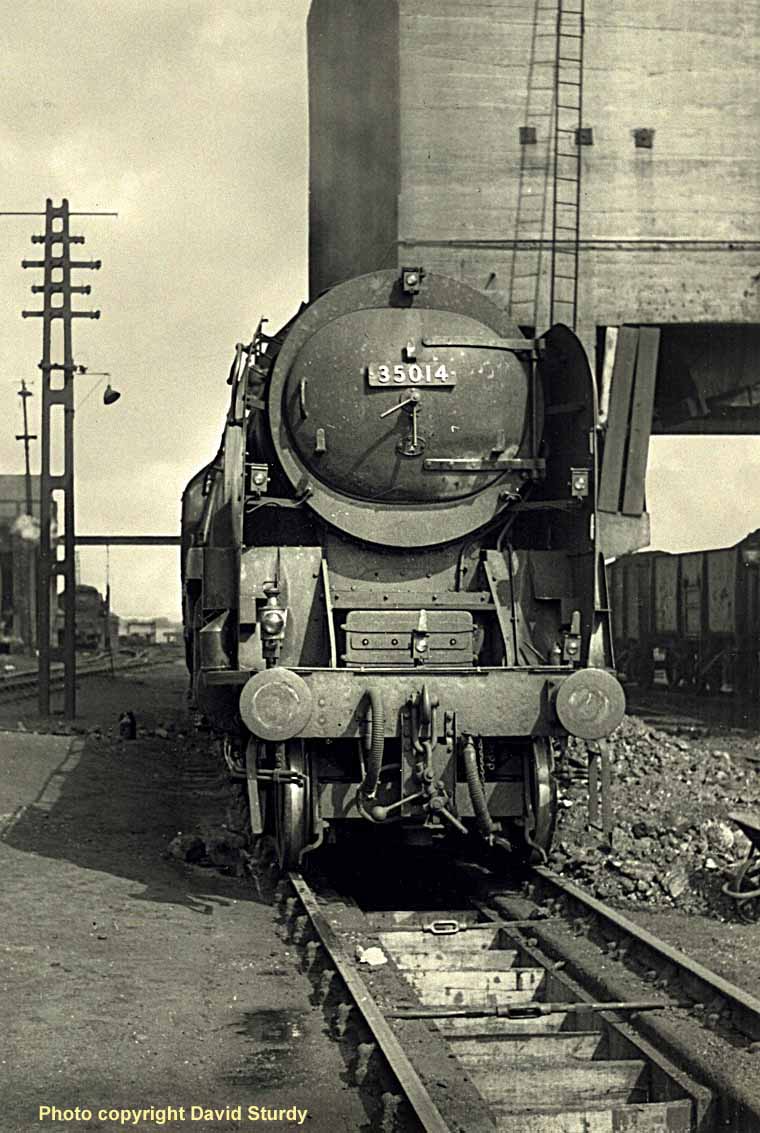

(Above) Our final railway excursion of the holiday was to Plymouth on a fine sunny day, though I don't remember much about the journey from Newton Abbot, and at 14 years of age I had never heard of the Devon banks. But I do vaguely recall seeing the first of the 'Western' class diesel hydraulics, Western Enterprise in a strange sand colour at Newton Abbot. And because the journey was swift and uneventful I have to surmise that we were diesel hauled. The first sight that greeted us on arrival at Plymouth North Road Station was this one of a 'Western' and 'Warship' standing side by side. It's only since writing this article that I have taken the time to figure out what was going on. If you look closely at the picture you can see that the driver of 'Warship' D870 Zulu is stepping out of the far cab, which implies that he has just coupled up to the train. Both headcode panels display a train reporting number of 1C30 indicating the westbound 'Cornishman' and the 'Warship' is about to set off on the final leg of its journey through Cornwall. This makes sense because the more powerful 2,700 hp 'Westerns' were built to take the heavier loads over the formidable Devon Banks between Newton Abbot and Plymouth. In that case, D1004 Western Crusader is only one month old and resplendent in deep maroon livery as it hands over control of the train to its less powerful companion for the final leg of the journey to Penzance. Amazingly, Western Crusader would be withdrawn from service just eleven years later, and scrapped at its Swindon birthplace the following Year!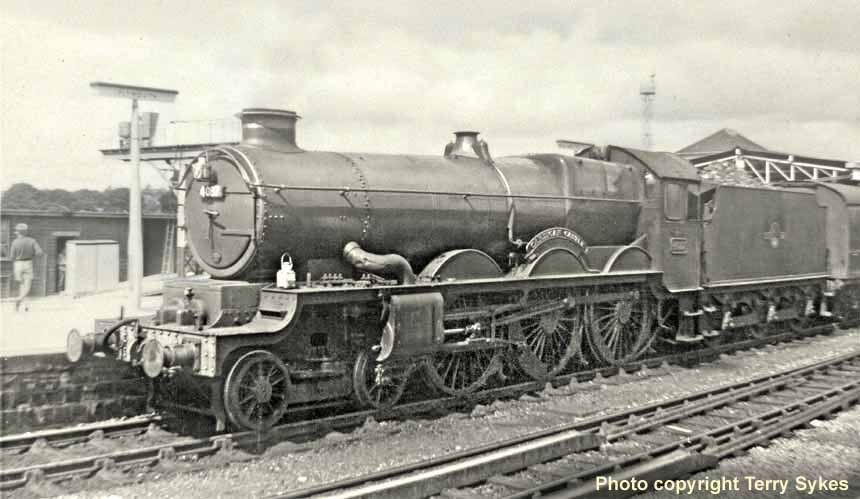
(Above-Below) On a much happier note, these two pictures produce a pleasant coincidence. It wasn't long after the departure of D870 Zulu with the down 'Cornishman' that the platform became occupied again. The first picture shows the arrival of a very clean and tidy double chimneyed 'Castle' class 4-6-0 No 4087 Cardigan Castle with a westbound stopping train. The locomotive's handsome lines show up well, albeit the overall effect is slightly spoiled by the dents in the cylinder steam pipe.(Below) While still pondering the origin of 4087's name…this naïve 14 year-old understood a 'cardigan' to be a type of buttoned jumper…another locomotive shed some light on matters; one of Hawksworth's elusive 'County' class 4-6-0s No 1008 County of Cardigan shows off its sleek lines as it runs the last few yards into the station with an eastbound express. 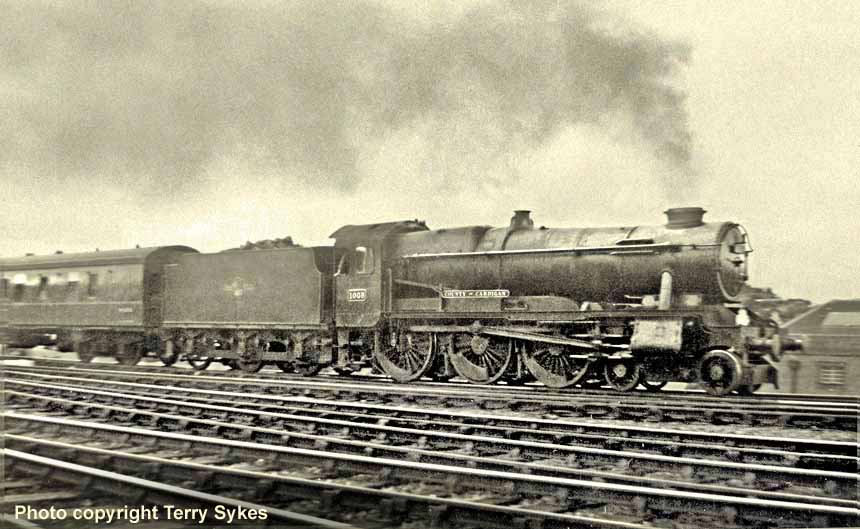

(Above-Below) We didn't see too many freight trains on the day, but this one turned up behind diesel hydraulic Type 2 D6352 and seemed to loiter in the station for a very long time. The locomotive is just 23 days old, and destined to have a service life of only nine years. (Below) The same 'Battle of Britain' class we had seen in Exeter just days earlier runs into Plymouth with an express parcels train on August 4 1962. No 34060 25th Squadron looks in excellent condition and survived to the end of SR steam, being withdrawn in July 1967. 
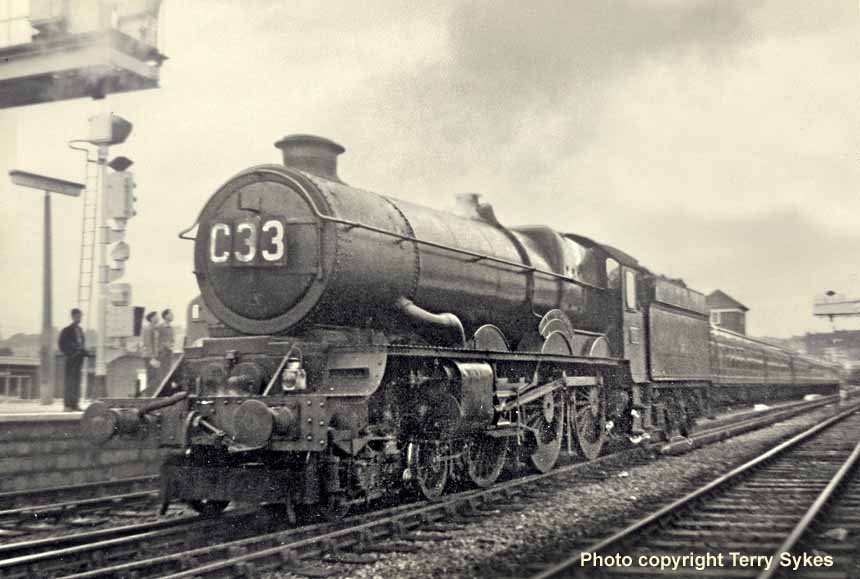
(Above) Having made contact with David Sturdy some 54 years after leaving school, we met up to discuss the amazing coincidence that brought about our mix-up with the photos we had both taken in Devon. When he looked through my old photo scrap book, he couldn't believe his eyes! The very last time a 'King' class locomotive ran through to Plymouth was to be 4 August 1962, and the engine selected from the last remaining examples was No 6026 King John. David and his brother had waited most of the afternoon at Newton Abbot, but somehow failed to see it. Many years later he wrote an article called 'In search of King John' - and here he was looking at my picture of King John at Plymouth on the very same day he missed it at Newton Abbot! I had been saving my twelfth and final shot for something special. But I hadn't expected this! Having uncoupled from the 'Cornish Riviera Express' at Plymouth, No 6026 is now reversing through the station to Laira depot. The picture emphasises very well the heavy front end of the 4-cylinder locomotives; the two inside cylinders are thrust well forward driving the front set of driving wheels, and the outside cylinders are set well back driving the middle set of wheels. This meant that getting steam to the outside cylinders from the smokebox necessitated the characteristic twisted outside steam pipes that we are all so familiar with.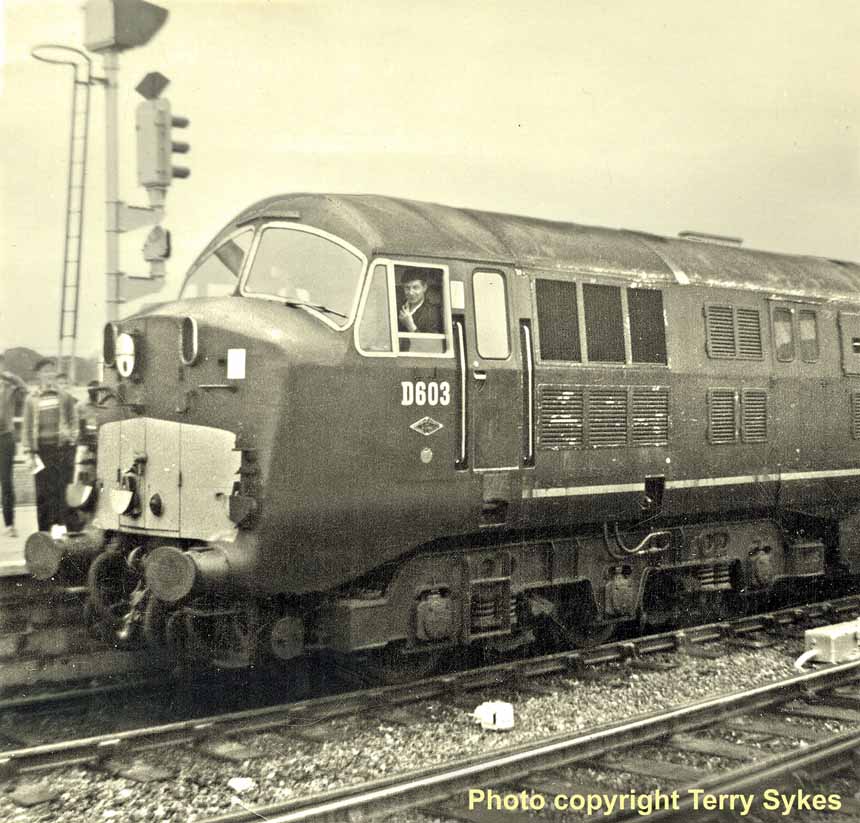
(Above-Below) The locomotive that coupled up to take the train on to Penzance was one of the North British 'Warships' No D603 Conquest, and so I risked an extra shot and ended up with half a negative which I had to print myself. Still half any picture is better than none, and my brother Keith is standing on the platform close to the locomotive. (Below) A nameplate from this ex-NBL A1A - A1A Class 41 Warship No D603 'Conquest' went under the hammer for £10,500 at a Great Western Railwayana Auction in April 2015. Built by the North British Locomotive Company Glasgow in November 1958, D603 was allocated to Plymouth Laira to work West of England Expresses to and from London Paddington. Withdrawn in December 1967 after less than 10 years service, the locomotive was cut up at Cashmore's Newport in November 1968.. 

(Above) The final throw of the dice…the going home shot! This picture by David Sturdy shows Warship locomotive D819 Goliath skirting the beautiful Devon coastline between Teignmouth and Dawlish at the head of a train for Bristol and the north.
Polite notice: All text and photographs are protected by copyright and reproduction is prohibited without the prior consent of the © owners. If you wish to discuss using the contents of this page the email address is below. Please note - this is not a 'clickable' mail-to link via Outlook Express. You will have to email manually.
dheycollection@ntlworld.com
To give credit where it's due, the compilation of this website would not have been possible without the support of many 'seasoned old timers' (now well past the Big Six-'0') who have all shared a small boy's passion for collecting engine numbers at one time or other. As the years rolled by, many turned their attention to railway photography - a natural adjunct to train spotting - and spurred on by the pictures that appeared in the monthly railway magazines, set about the task of recording the railway scene for the sheer joy of it. One such man is Peter Batty, whose collection of railway photographs date back to the 'Big Four' railway companies (LNER; LMSR; GWR; SR) before they came into public ownership in 1948. Now retired, PR Batty has dedicated his time to the Friends of the National Railway Museum as member of the editing staff on the quarterly journal, 'Review'.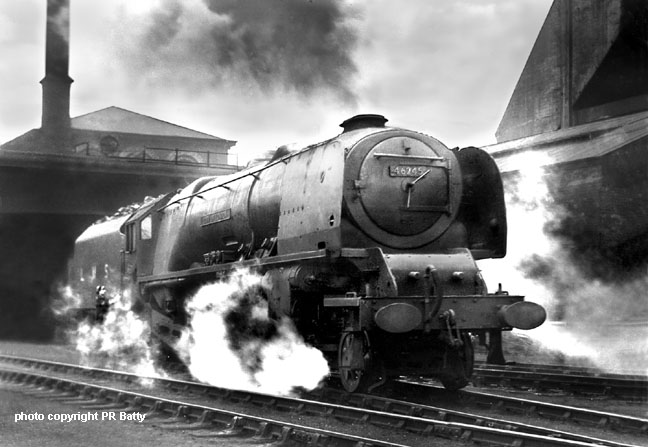
(Above-Below) This shot of a rather grimy Stanier Pacific No 46245 City of London - still carrying LMS on the tender - was taken at Camden shed on 4th April 1950. (Below) To facilitate the increase in wartime freight traffic to English ports, the Southern Railway's CME 1937-1947, OV Bulleid designed the Class 'Q1' 0-6-0. This all-purpose engine had a maximum tractive effort of 30,000lb with a minimum weight of 51 tons 5cwt which gave the Q1 the widest possible route availability throughout the SR network. Shortages of materials meant that Bullied had to dispense with traditional locomotive embellishments such as a footplate, wheel splashers and, in place of spoked wheels, a lighter 'boxpox' variety was used instead. The unusual 'bucket-style' chimney and non-cylindrical outer cladding of the boiler casing (made up of three sections) gave the Class Q1 the dubious distinction of being one of the ugliest ever seen on Britain's railways. Nonetheless, Bullied succeeded in producing a locomotive almost 14 tons lighter than any other engines of comparable size and power. Here, the 'no frills' design is clearly seen as No 33016 shares the company of a more conventional Class '700' No 30684 at Nine Elms in June 1956 . Photo © PR Batty
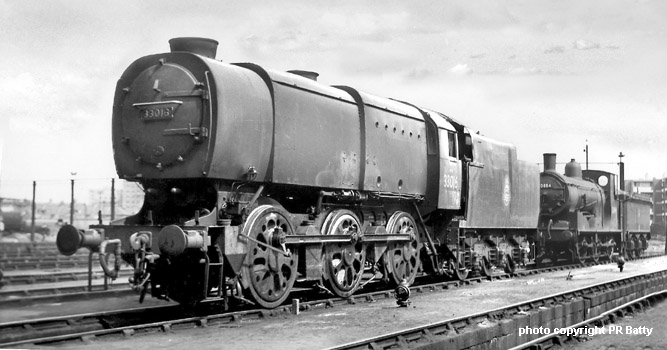
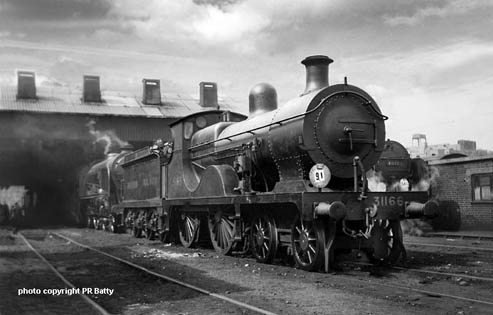
(Above) This charming shot of 'E' class 4-4-0 No 31166 at Bricklayers Arms in April 1953, gives some idea of the grimy conditions to be found at steam sheds in the Fifties. By the 1960s, Britain was showing signs of recovery from the ravages of World War 2, and more lucrative job prospects were being offered in alternative industries than BR had on its books. Therefore few willing hands could be found to do the hard, dirty job of cleaning and firing steam engines at depots, and BR's ageing steam fleet fell into a dire state of cleanliness. The 'E' class was a Wainwright design, introduced in 1905 for the South Eastern & Chatham Railway. Harry Wainwright was appointed the SECR's locomotive superintendent between 1899-1913, and produced several designs comprised of robust and conventional 0-6-0, 0-4-4T and 4-4-0 locomotive types, several of which survived into BR days. The last 'E' class was withdrawn in 1955 and Bricklayers Arms shed (73B) closed its doors at the beginning of the 1962 summer timetable.
THE PETER BATTY PICTURE GALLERY - AROUND THE REGIONS

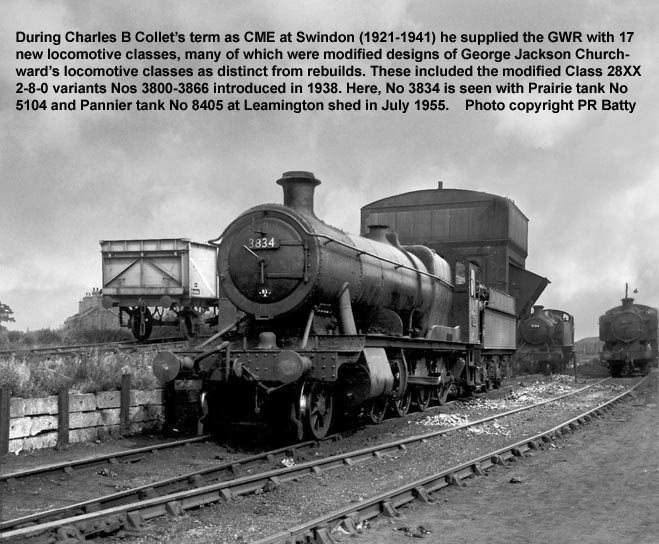
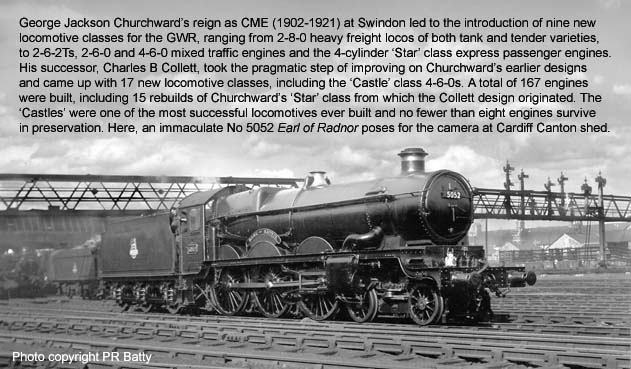
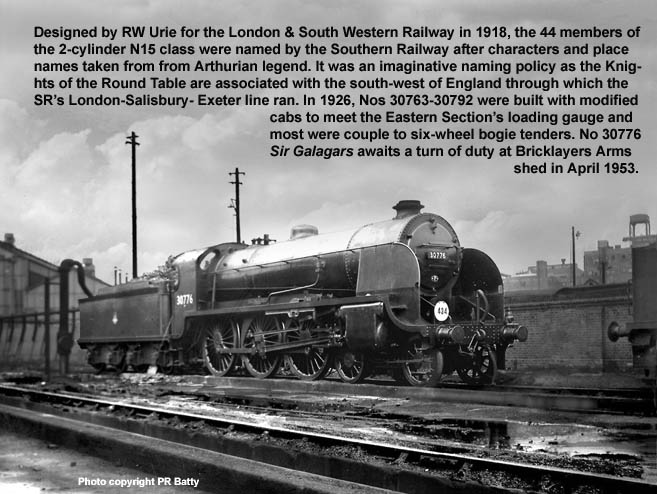
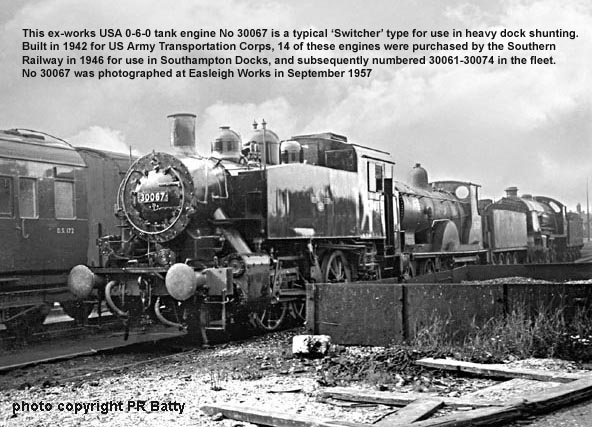
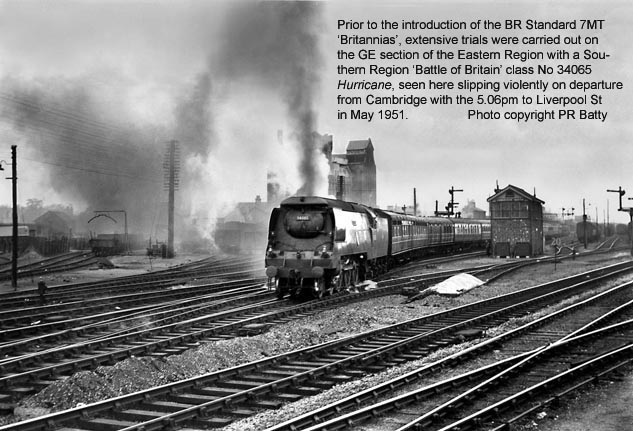
THE PETER BATTY PICTURE GALLERY - DIESEL DEVELOPMENTS
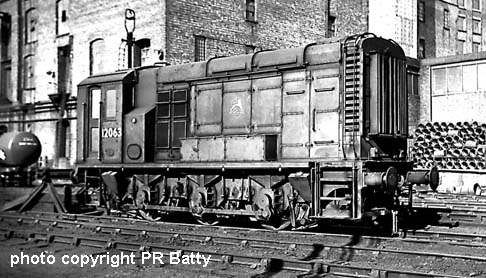
(Above-Below) Introduced in 1945, the LMS/EE Co Class 'OF' 0-6-0 diesel electric shunter Nos 12033-12138 (later classified DEJ3 by the Eastern and North Eastern Regions of British Railways) ended their days as TOPS Class 11. Constructed at Derby, the fleet of 106 shunters was powered by EE Co 6-cylinder 350hp engines with a maximum tractive effort of 35,000lb. By 1967, withdrawal of this class was relatively swift due to a combination of reduced freight traffic and the rationalisation of BR's motive power under the National Traction Plan. The photo shows No 12063 resting between duties at Kentish Town MPD on 16 October 1955. (Below) Introduced in 1958, the Barclay 204hp 0-4-0 diesel-mechanical shunter numbered 25 in the BR fleet. The shunter was powered by the same Gardner Type 8L3 engine as above, giving a maximum tractive effort of 20,000lb. Transmission was mechanical using the Wilson-Drewry CA5 type 5-speed epicyclic gearbox. No D2418 was photographed at Inverurie Works, Scotland on 16 May 1959. Photos © PR Batty



Polite notice: All text and photographs are protected by copyright and reproduction is prohibited without the prior consent of the © owners. If you wish to discuss using the contents of this page the email address is below. Please note - this is not a 'clickable' mail-to link via Outlook Express. You will have to email manually.
dheycollection@ntlworld.com





